|
|
The Farndale Timeline 2 The Modern Age 1600 to the present day
|
|
The colour code
key to this page will help to navigate:
Dates
in red.
Royal
history in Blue.
Key National Events in Orange.
Local
history impacting on Farndale history in purple.
Farndale history in green.
Links
to the family trees of the Farndale Lines are in Brown.
The history up to
about 1600 is a common history of all modern Farndales. From about 1600, the
family continues with that common origin, but starts to grow and over time,
diverge. So this second timeline tells of that divergence, and of the various
Lines of Farndales, all related, but paving their own distinct courses over
time. How remarkable it would have been for the early ancestors, to learn about
the diverse and remarkable achievements of their later descendants. We modern
Farndales, can start to envision not only our common ancestry, but our
diversity through the ages which followed.
If Timeline 1 (1000 CE to 1600)
evidences the depth of the Farndales’ history, Timeline 2 (1600 to date)
evidences its breadth and diversity of experience.
A preliminary
note about Cleveland
Timeline 1 (1000 CE to 1600)
is the history of a family which emigrated out of Farndale into the wider area
to the south of the North York Moors, with focused clusters around Bishop
Wilton, York and Doncaster. From the mid
sixteenth century the family had moved north of the North York Moors into
Cleveland and we see the family focused there through the seventeenth into the
early eighteenth centuries. From the early eighteenth century, the family
remained predominantly focused in Cleveland but started to emigrate more widely
again, for instance to the Ampleforth area and
beyond.
So we have a picture of a family focused in Farndale in
the thirteenth century, emigrating out of Farndale into the fourteenth century,
and then moving to focus to the north around Cleveland in the md sixteenth
century.
And
so, we now find ourselves predominantly in Cleveland. Cleveland would find
itself at the heart of the industrial revolution from the mid eighteenth
century, with extensive ironstone mining, alum production and Victorian
building. However in the early years it was described by John Farndale, our
author ancestor, as a sylvan countryside of rural landscape, with adventurers
in the North Sea (then called the German Sea), and tales of smugglers. Some of
the family in the early eighteenth century would find themselves pulled to the
bustling port of Whitby.

1599
On 22 January 1599 William ffarndaill, the
son of George Farndale of the Doncaster-Kirkleatham-Skelton
Line was baptised in Skelton. He married Jane in about 1622
and they lived at Moorsholm and Liverton. William was the Founder of the Skelton 1 Line,
from
which the Great Ayton 1 Line
and the Moorsholm 1 Line
descend.
|
|
|
1599 to 1682
|
|
|
|
|||
|
|
1624 to 1659 |
1630 to 1676 Skelton, Moorsholm, Liverton |
||||||
|
||||||||
Those Farndales shown below in the timeline who are
descendants of the Skelton 1 Line,
can be identified by the annotation S1.
1600
Elizabeth
I, 1558-1603
The
East India Company began to trade in the Far East.
Population
reached 4.8 million.
1601
The Poor Law placed legal obligation on parishes to
care for those unable to work. Three classes were introduced – the able bodied
poor who were offered work in houses of correction; the impotent; and
persistent idlers.
1602
Georgins ffarndayle
was baptised at Skelton on 28 March 1602. He lived at Liverton/Moorsholm. George is on the direct family line of modern Farndales. See
the
Doncaster-Kirkleatham-Skelton Line.
1603
The
Stuart Line, 1603-1714
James I, 1603-1625
Bubonic plague outbreak in London.
Union of the Crowns of Scotland and England (though the
nations remained separate with their own parliaments).
1604
A
third of the population of York died from plague.
1605
The Gunpowder Plot: A plot in which Guy Fawkes and other Catholic associates conspired to blow up King James VI and I and the Parliament of England was
uncovered.
Adoption of the Union Flag for Great Britain.
1607
14 May 1607 - Jamestown was founded in the Virginia Colony and was the
first permanent English colony in the Americas.
1610
William Camden’s Britannia, the
first county buy county survey of Britain.
1611
John Speed’s The Theatre of the Empire of Great Britain
included the first set of county maps of England and Wales.
The publication of the King James Bible.
1616
William Shakespeare died.
1618
The Company of Adventurers of London Trading with ports
in Africa.
The Thirty Years War 1618-1648
1620
The Pilgrim Fathers sailed for America on the Mayflower
to establish Plymouth Colony.
Charles
I, 1625-1649
1627
The
development of Scarborough based on the benefits of ‘taking the waters’.
1630
Population reached 5.6 million.
Public stagecoaches began to operate within a radius of
about 30 miles of London.
1632
On 29 July 1632, Richard Farndale, the
son of George Farndale of the Doncaster-Kirkleatham-Skelton
Line married Emmie Nellice at Liverton. Richard and Emmie
were Founders of the Liverton 1 Line.
They had three sons, but the eldest two sons died within about a year. Richard
was church warden at Liverton Church by 1635.
1634
Nicholas Farndale, son
of George Farndaile of the
Doncaster-Kirkleatham-Skelton
Line was baptised in Liverton on 6 July 1634. Nicholas is on
the direct family line of modern Farndales and Founder of the Liverton 2 Line
(which Line preceded K1 and K2).
1640
The Long Parliament.
1641
The Protestation Oath required adult males to declare allegiance to the King, Parliament and the Protestant religion. About a third of the returns survive.
1642
English Civil War (1642–1651)
Oxford became the Royalist base.
The Battle of Edgehill which was inconclusive.
All theatres closed to prevent public disorder.
1643
Marchamont Nedham and Mercurius Britanicus.
1644
Royalists defeated by Parliamentary troops at the
Battle of Marston Moor.
1645
The Battle of Naseby and the Battle of Langport. The
last Royalist field army was decimated.
1647
The
London Corporation established to build workhouse.
Marchamont Nedham and Mercurius Pragmaticus
(royalist)
1649
January 1649 - Trial and execution of Charles I.
The
Commonwealth, 1649-1653
1651
The Battle of Worcester ended the English Civil War.
1652
The First Anglo-Dutch War, fought mostly at sea.
1653
The
Protectorate, 1653-1660
Marchamont Nedham and Mercurius Poliuticus
(platform for the Commonwealth regime)
1654
James Farndale, the son of William ffarndaill (S1), the Skelton 1 Line), married Isabell in
Skelton. They had one hearth at Moorsholm, and two sons, though the younger son
died within a year. He was Founder of the Moorsholm 1 Line.
1655
British captured Jamaica from the Spanish.
1660
Charles
II, 1660-1685
The Royal Society founded to promote discussion about
scientific subjects.
The start of Samuel Pepys’ diary.
The Tenures Abolition Act ended feudalism.
A poll tax levied on all men and women over 16 years
old annually (until 1697).
The first regular standing army established.
The English Navy became the Royal Navy.
1661
On 19 November 1661,
John
Farndale of Whitby married Alice
Peckock at Whitby Parish Church.
Whilst I have not traced his parents, it seems very probable that he descended
from the Farndales of Cleveland who we have already met, and this was a family
who moved naturally from the Cleveland countryside to the port town of Whitby.
John
and Alice are the Founders of the Whitby 1 Line,
from which the Whitby 2 Line
and the Whitby 4 Line
descend.
|
|
|
1636
to 1832
|
|
|
|
|
|
|
1711 to 1827
|
|||
|
1773 to 1938 Whitby and around |
Those
Farndales shown below in the timeline who are descendants of the Whitby 1, 2 and
4 Lines,
can be identified by the annotation W1.
1662
The Quaker Act made it illegal to refuse to take the
oath of allegiance.
The Settlement Laws made it easier to evict newcomers
if a complaint was made within 40 Days of their arrival. This reduced the
mobility of the poorer classes and discouraged the search for work elsewhere.
Limits to rights to claim poor relief.
The Book of Common Prayer included a prohibited
marriage list.
The Hearth Tax – a shilling to be paid twice a year for
every hearth or stove in all domestic buildings. From 1663, hearths were
listed.
George Farndale was
baptised at Liverton on 10 August 1662.
1663
The first turnpike road was authorised for a section of
the Great North Road.
1664
The Conventicle Act forbade religious meetings of more
than 5 people to discourage on conformity.
The Second Anglo Dutch War, 1664 to 1667.
Impressment into the navy was officially authorised.
1665
The Oxford Gazette (later the London Gazette).
The Great Plague in London killed over 60,000.
1666
Great Fire of London, 1666
The Burial in Wool Act required woollen shrouds to be
used.
1667
The earliest ships’ muster books.
John Milton’s Paradise Lost.
1670
The population reached 5.7 million.
1671
Establishment of a Board of Customs.
1672 to
1674
The Third Anglo Dutch War – the army was increased to
10,000.
1675
John Ogilby’s Britannia Illustrata
included 100 strip maps of roads in England and Wales.
On 4 October 1675 Richard ffarndaill, a
Yeoman of Brotton, married Martha Sawer. This seems to have been the first
association of the family with Brotton, and perhaps of Kilton. He Founded the Brotton 1 Line.
1680
Headstones began to be widely used to mark a place of
burial.
The Great Comet first identified by telescope.
1681
On 31 October 1681, the administration of the estate of
George ffarndell (son
of William ffarndaill (S1), the Skelton 1 Line), late of Stockton, who died
intestate, was granted to his widow, Merilia. George had founded the Great Ayton 1
Line.
1682
The first settlers arrived in Pennsylvania.
Travels of Celia Fienes
provide detailed information on certain English towns.
1683
The Great Frost – a frost fair held on the Thames.
James
II, 1685-1689
1685
The Bloody Assizes in the south west.
1687
The Settlement Act of 1662 amended so that it was
necessary to establish settlement by occupying property valued at over £10 per
annum for more than 40 days.
1688
The Glorious Revolution.
George Farndale married
Alice Petch at Loftus on 19 April 1688.
1689
William
III and Mary, 1689-1702
Legislation to encourage the consumption of gin rather
than French brandy.

1690
The Battle of the Boyne.
William Farndale was
baptised at Liverton on 23 November 1690. William married Mary Butterwick at
Skelton in 1738. He was church warden in Skelton. He was one of the early
Farndales in Kilton.
William is the Founder of The Kilton 2 Line
which branches into a significant part of the modern Farndale family (the lines
with ** are contemporary lines which still have family members alive today):
|
|
|
1690 to 1841
|
|
|
|
|
|
|
1739 to 1833
|
|
|
|
|
|
|
1772 to 1917 Loftus, Brotton,
Whitby, Marske, Middlesbrough |
|
|
|
|
|
The George
Farndale part of the Loftus 2 Line ** 1843 to Date
|
|
|
1796 to Date
|
1814 to Date Stockton,
Middlesbrough and more widely |
|
1914 to 1944 Surrey, Sussex |
1932 to Date California,
Oklahoma, Arizona, Washington |
1934 to 1966 Pontypridd,
Glamorganshire |
|
1913 to Date Northumberland |
|
Those Farndales shown below in the timeline who are
descendants of the Kilton 2 Line,
can be identified by the annotation K2.
1692
The Massacre at Glencoe.
The Royal Hospital at Chelsea was established.
1694
The Bank of England founded by Royal Charter.
1695 to
1699
Large scale emigration from Scotland following famine.
Many settled in Ireland.
1696
County Sheriffs were required to compile poll books of
voters.
A Window Tax replaced the Hearth Tax and led to
widespread bricking up of windows.
1697
Paupers were required to wear badges.
Waymarkers were inscribed on roads.
1698
Between 1698, Isabell ffarndaill, the daughter of Richard ffarndaill, a
Yeoman of Brotton, the Brotton 1 Line had four children out of
marriage.
1699
The first slave ship sailed from Liverpool.
The Standing Army was limited to 7,000 ‘native born’
men.

1700
George Farndale, the
son of Nicholas Farndale, the Liverton 2 Line
(which Line preceded K1), church warden
in Loftus, was fined 1s by the jury of the manor court of north Loftus for
letting his horse go on to the Common.
William Farndale the
son of George ffarndell (S1), the Great Ayton 1 Line,
was
sworn in for jury service in Loftus.

1701
The population reached 6 million.
1702
Queen Anne, 1702-1714
First daily newspaper, the Daily Courant, published in Fleet
Street – it later merged with the Daily Gazetteer.
1704
Marlborough's victory at the Battle of Blenheim, 1704
A Deeds Registry was established in Wakefield
containing over a million records of property ownership, followed by records in
the East Riding in 1708 and North Riding in 1735.
1705
John Farndale
son of Nicholas Farndale,
of the Liverton 2 Line
(which Line preceded K1
and K2),
married Elizabeth Bennison at Brotton on 5 February 1705. By then he was living
in Kilton
and was one of the first members of the family, with his brother George Farndale
(Founder of the Kilton 2 Line),
to live in Kilton. John and Elizabeth were the Founders of the Kilton 1 Line,
a core hub for the development of the history of the wider family.
John
is the Founder of the Kilton 1 Line, which branches into a very significant part of the modern
Farndale family (the lines with ** are contemporary lines which still have
family members alive today):
|
|
|
|
1680 to 1973
|
|
|
|
|
|
|
|
|
|
|
1743 to 1797 Whitby, Lythe |
1753 to 1790 Brotton, Skelton |
1788 to Date
|
The Australia 1 (Birregurra) Line 1793 to 1923 Birregurra and
Victoria, Australia
|
1795 to 1953
|
1795 to 2005
|
1822 to 1989 Bishop Auckland,
Newcastle |
1827 to 1984
|
1836 to Date Ontario via the
Crimean War |
1845 to 1992
|
1850 to 1974
|
1875 to Date
|
The John Farndale
part of the Loftus 2 Line ** 1848 to Date
|
|
|
|
|
1883 to 1928
|
1922 to Date Wetherby, Thirsk,
Northallerton |
Hartlepool and
more widely |
1890 to 1934 Illinois, Iowa,
Wisconsin |
1885 to Date California, Texas |
1897 to Date Wensleydale and
more widely |
|
1940 to Date Wales particularly
Glamorganshire |
1886 to Date Newfoundland |
|
|
|
|
|
1907 to Date London and Sussex |
1911 to Date London, Bedford,
Northampton, Essex |
1921 to Date London |
|
|
|
|
The Robert
Farndale part of the Wakefield 1 Line ** 1885 to date
|
1894 to Date Thirsk,
Northallerton, Richmond |
|
|
The Thomas
Farndale part of the Wakefield 1 Line 1839 to 2002 Wakefield and more
widely
|
1849 to 1993
|
1909 to Date Nottingham and
more widely |
1914 to Date Holderness, Hull |
1947 to Date Wide geographical
spread |
|
1909 to Date Bradford,
Chesterfield |
1904 to 1943 South Shields,
Bradford |
|
1919 to Date New Zealand,
particularly Masterton |
1940 to Date Cambridge, London,
Middlesex |
|
|
|
|
1871 to 1912 Ontario, Canada |
|
|
|
|
|
|
|
|
|
|
|
|
1866 to Date London and more
widely |
1886 to Date Leicester,
Nottingham and more widely |
1916 to 1945 Bradford |
|
|
|
|
|
|
|
|
|
Those
Farndales shown below in the timeline who are descendants of the Kilton 1 Line, can be identified by the annotation K1.
1707
The Act of Union established the Kingdom of Great
Britain.
On 11 January 1707 Thomas Farndale (W1), the son of John and Alice Farndale
of Whitby, the Whitby 1 Line,
married Sarah Perkins at Sneaton to the southwest of Whitby.
Thomas was a carpenter.
Lewis
Carrol stayed in Whitby on many occasions. It is thought that he drew his
inspiration for his poem ‘The Walrus and the Carpenter’ from the nearby village
of Sandsend, on the coast to the north west of Whitby.
The
Walrus and the Carpenter Walked on a mile or so, And then they rested on a rock
Conveniently low: And all the little Oysters stood And waited in a row.… The
time has come,' the Walrus said, To talk of many things: Of shoes — and ships —
and sealing-wax — Of cabbages — and kings — And why the sea is boiling hot —
And whether pigs have wings.' But wait a bit,' the Oysters cried, Before we
have our chat; For some of us are out of breath, And all of us are fat!' No
hurry!' said the Carpenter. They thanked him much for that. … O Oysters,' said
the Carpenter, You've had a pleasant run! Shall we be trotting home again?' But
answer came there none — And this was scarcely odd, because They'd eaten every
one."

1708
The earliest artillery muster rolls.
The coldest winter for centuries.
1709
Poor harvests across Europe led to bread riots in
Britain.
1712
Thomas Newcomen’s steam driven piston engine provided
efficient pumping of mines.
1713
The Treaty of Utrecht – Spain ceded Gibraltar and
France ceded Newfoundland to Britain.
1714
The
House of Hanover
George
I, 1714-1727
1715
Jacobite Rebellion of Fifteen, 1715
1718
The first factory opened in Derby, producing silk.
1720
The South Sea Bubble, 1720.
1723
The Black Act added 50 capital offences to the penal
code including some forms of poaching.
Knatchbull’s Act enabled workhouses in parishes.
1724
Daniel Defoe’s A Tour through the whole island of
Great Britain.

1727
George
II, 1727-1760
George
II was born in Hanover the son of George I and Sophia of Celle. He married
Caroline of Brandenburg-Ansbach in 1705.
1728
Vitus Johanssen Bering reached Alaska.
1729
The first parliamentary acts to curb the consumption of
gin.
Charles Wesley
founded the Methodists at Lincoln College Oxford. See also the Journal of John Wesley.
1730
The first seaside towns appeared in Brighton and
Margate.
Charles ‘Turnip’ Townsend promoted crop rotation.
1732
Unmarried mothers were expected to name the father of
their child under oath during a Bastardy Examination.
1733
Latin was replaced by English in public records.
The invention of the flying shuttle revolutionised
weaving.
Elias Farndale
was born, perhaps around Thirsk, in or about 1733. He married Elizabeth Raper
at Thirsk on 28 February 1753. He is Founder of the Ampleforth 1 Line.
Because I have not yet ben able to identify his parents, I cannot directly link
him, and his descendants into the wider family. It is possible he was not
related to the Farndales who arrived in Cleveland by about 1567. However the
fact that I have only found evidence of Farndales in the immediate centuries
after 1567 in Cleveland, means that I think it is highly probable that Elias
(and therefore his descendants) are somehow linked to the families in Cleveland
who we know about in the sixteenth and seventeenth centuries. In other words
Elias is probably descended from the known family above, but we have just not
yet managed to prove that or establish exactly how he links in. There is a
‘missing link’ here, but it is still probable that he is part of the same family
we have met above.
So,
Elias is the Founder of the Ampleforth 1 Line which branches into a significant part of the modern Farndale
family (the lines with ** are contemporary lines which still have family
members alive today):
|
|
|
1728 to Date
|
|
|
|
|
1788 to Date
|
|
1826 to Date Leeds and around |
1849 to 1993
|
1927 to Date South Australia,
Northern Territory |
1936 to Date Thornaby and more
widely |
|
1875 to 1948 Wetherby, York,
Northallerton |
1910 to Date Bradford and
around |
|
1870 to 1933 Norwich and area,
and New Zealand |
1911 to Date New Zealand |
1912 to 1945 Uxbridge and area |
Those
Farndales shown below in the timeline who are descendants of the Ampleforth 1
Line,
can be identified by the annotation A1.
William Farndale,
son of John and Elizabeth Farndale
(K1),
the Kilton 1 Line,
married Abigail Gear at Brotton.
1734
Jethro Tull published essays on improving farming
including the use of the seed drill.

Jethro Tull's seed drill
Jethro Tull (1674 – 21 February 1741, New Style) was an
English agricultural pioneer from Berkshire who helped bring about the British
Agricultural Revolution. He perfected a horse-drawn seed drill in 1701 that
economically sowed the seeds in neat rows. He later developed a horse-drawn
hoe. Tull's methods were adopted by many great land owners and helped to
provide the basis for modern agriculture. This revolutionized the future of
agricultural success.
1735
The Hawkhurst smugglers were active across south east
England.
1738
On 28 May 1738, Francis Farndale, son
of Thomas Farndale (W1), the Whitby 1 Line,
a carpenter like his father, married Margaret Spark.
1739
The Great Frost in Britain
The War of Jenkins' Ear, with Spain, 1739 to 1740.
Britain went to war with Spain over Captain Jenkins’ ear, claimed to have been
cut off in a skirmish at sea.
Formation of Methodist Societies around London.
Dick Turpin, highwayman, hanged at York.


Richard "Dick" Turpin (1705 – 7 April 1739)
was an English highwayman whose exploits were romanticised following his
execution in York for horse theft. Turpin may have followed his father's
profession as a butcher early in life, but, by the early 1730s, he had joined a
gang of deer thieves and, later, became a poacher, burglar, horse thief and
killer. He is also known for a fictional 200-mile (320 km) overnight ride from
London to York on his horse Black Bess, a story that was made famous by the
Victorian novelist William Harrison Ainsworth almost 100 years after Turpin's
death. Turpin's involvement in highway robbery followed the arrest of the other
members of his gang in 1735. He then disappeared from public view towards the
end of that year, only to resurface in 1737 with two new accomplices, one of
whom he may have accidentally shot and killed. Turpin fled from the scene and
shortly afterwards killed a man who attempted his capture. Later that year, he
moved to Yorkshire and assumed the alias of John Palmer. While he was staying
at an inn, local magistrates became suspicious of "Palmer" and made
enquiries as to how he funded his lifestyle. Suspected of being a horse thief,
"Palmer" was imprisoned in York Castle, to be tried at the next
assizes. Turpin's true identity was revealed by a letter he wrote to his
brother-in-law from his prison cell, which fell into the hands of the
authorities. On 22 March 1739, Turpin was found guilty on two charges of horse
theft and sentenced to death; he was executed on 7 April 1739.
William Farndale (K2), the Founder of the Loftus 1 Line,
was baptised in Skelton on 3 January 1739. He married Hannah Toes at Lythe
Parish Church in 1761 and was elected and sworn as a constable for Loftus in
1781.
The
Watchmen of the North
Law
enforcement and policing during the 1500's, and earlier, were not administrated
nationally, instead they were organised by local communities such as town
authorities. Within local areas, a constable could be attested by two or more
Justices of the Peace, a procedure that had its roots in an Act of 1673. From
the 1730s, local improvement Acts made by town authorities often included
provision for paid watchmen or constables to patrol towns at night, while rural
areas had to rely on more informal arrangements. In 1737, an Act of Parliament
was passed "for better regulating the Night Watch" of the City of
London which specified the number of paid constables that should be on duty
each night. Henry Fielding established the Bow Street Runners in 1749; between
1754 and 1780, Sir John Fielding reorganised Bow Street like a police station,
with a team of efficient, paid constables.
1740
The death of Holy Roman Emperor Charles VI in 1740 led
to the European War of Austrian Succession in which the British and Dutch
supported Marie Theresa’s claim to the Austrian throne against the Prussians
and French. George II personally led his troops at the Battle of Dettingen in
1743, becoming the last British monarch to lead his troops into battle.
On 29 June 1740, Giles Farndale,
son of Thomas Farndale
(W1),
the Whitby 1 Line,
was impressed into the navy. He was almost certainly press
ganged in Whitby, at the age of 27.

Press
gang in the eighteenth century
George Farndale was
buried at Skelton on 20 December 1740.
1741
The Foundling Hospital opened in London, with outposts
elsewhere across the country.
1742
Dr
William’s
Library recorded a general register of births of Protestant Dissenters of the
Three Denominations of Baptists, Presbyterians and Independents.
In
January 1742, Giles Farndale, son of Thomas Farndale (W1), the Whitby 1 Line
died on board HMS Experiment. Giles was a press ganged sailor in the
Caribbean, who served on HMS Experiment and almost certainly fought in
the battle for Cartagena de Indias, during the War of Jenkins’ Ear.
The ‘Experiment’ was
commissioned under Captain Hughes at Deptford between Mar and Jun 1740. On
29 Jun 1740 the ‘Experiment’ was at The Nore (see below), where Giles Farndell
(or Farndale; he is listed under both names in different Muster Books), came on
complement. From
there she sailed for Port Royal, Jamaica (see below) where she arrived on 15
Sep 1740. From there until June 1741 the ship was either in Port Royal, at sea,
or in Cartagena.
Port Royal provided a
safe harbour initially for privateers and subsequently for pirates plying the
shipping lanes to and from Spain and Panama. Buccaneers found Port Royal
appealing. By the 1660s the city had, for some, become a pirate utopia and had
gained a reputation as the "Sodom of the New World", where most
residents were pirates, cutthroats, or prostitutes.
The ship was part of a
squadron sent to the Caribbean to support Admiral Vernon's operations against
the Spanish during the War of Jenkins' Ear. Vernon was also famous
for introducing grog, a mixture of rum and water, to his sailors to prevent
scurvy and drunkenness. He earned the nickname of "Old Grog" because
he wore coats made of grogram cloth.
Vernon suffered his most
humiliating defeat in March 1741, when he led a large amphibious operation
against the port of Cartagena de Indias in Colombia. Despite having a superior
naval and land force, he was unable to overcome the strong Spanish defences led
by Blas de Lezo, and was forced to withdraw after losing thousands of men to
disease and combat.
The battle of Cartagena
de Indias was a major naval and land engagement that took place in March 1741,
during the War of Jenkins' Ear. It was part of Admiral Vernon's attempt to
capture the Spanish port city of Cartagena de Indias, which was a key trading
and military centre in the Caribbean. Vernon had a large force of 29 ships of
the line, 22 frigates, 71 sloops-of-war, 80 troop ships, and 50 merchant ships,
carrying about 12,000 soldiers and 15,000 sailors. He also had the support of
4,000 colonial troops from Virginia and Jamaica. The Spanish defenders were led
by Admiral Blas de Lezo, a veteran officer who had lost an eye, an arm, and a
leg in previous battles. He had only 6 ships of the line and about 2,700
soldiers and 600 sailors, but he also had the advantage of strong fortifications
around the city and the bay. He also had the help of 600 Indian archers and
some local militia. The battle lasted for more than two months, and involved
several naval and land attacks by the British, as well as counterattacks by the
Spanish. The British managed to capture some of the outer forts and batteries,
but they failed to breach the main defences of the city. They also suffered
heavy losses from disease, especially yellow fever and malaria. The British
finally gave up on 20 May 1741, after a failed assault on the Castillo San
Felipe de Barajas, the largest fort in the city. They retreated with about
9,500–11,500 dead and 7,500 wounded. The Spanish lost about 800 dead and 1,200
wounded.

HMS Experiment capturing
a French Privateer in 1757
1745
The
Jacobite Rebellion of Forty Five. The Jacobite Rebellion of 1745, in which
Charles Edward Stuart (‘Bonnie Prince Charlie’) landed in Scotland and marched
with a Highland army into England, was defeated at Culloden in 1746 and
Scottish opposition brutally suppressed by George’s second son Prince William,
Duke of Cumberland.
1746
Battle
of Culloden, 1746 - Scots defeated at the Battle of Culloden. Duke of
Cumberland, the King's 2nd son, ruthlessly represses the rebels and Scottish
traditions.
1747
A tax was imposed on all horse drawn carriages.
1750
The population of Great Britain reached 6.5 million.


Whitby
in about 1750
On 11 February 1750, William Farndale
married Mary Taylor at Liverton. William and Mary founded the Kilton 3 Line.
He was a farmer at Craggs, a farm later associated with the Farndale family and
particularly the Craggs Line.
1751
The Army introduced Regimental numbers instead of being
named after the colonel in command and were soon given official titles such as
the “King’s Own”.
1752
Estates forfeited by the Jacobites were bestowed to the
Crown.
14 September 1752, England and Wales adopted the
Gregorian calendar.
1753
The Bow Street Runners were appointed to patrol
London’s streets.
The Licensing Act required the recording of full
registers of victuallers, to be kept by the Clerk of the Peace as Quarter
Sessions.

The
Harbour at Whitby in the eighteenth century
On 10 November 1753, John Farndale, the son
of Thomas and Sarah Farndale
(W1),
and Founder of the Whitby 2 Line, was a seaman named in a
list of 42 of the crew of ‘The Friendship of Whitby’ when James
Cook was Mate (later the famous Captain Cook). John would be about
42 years old.
Ship: "Friendship" of Whitby, owned by John Walker, Grape Lane, Whitby. Richard Allerton, Master, James Cook, Mate. John Farndill, Seaman, 45 years old, Whitby, served seven months 12 days, 30 March 1752 to 12 May 1753. Paid 8/4d muster dues. Prior to this he sailed with Robert Easton of London, but the name of ship is not given. No ship of James Peacock appears in Whitby records, but the name Peacock appears often as crew member in the muster rolls. In fact there was a Captain Peacock still living in Whitby in 1984.
The Friendship of Whitby
was a collier ship that carried coal and other goods between London, Newcastle,
and Norway. On March 30, 1752, the ship sailed from Whitby to London, where it
arrived on April 9. It then sailed to Newcastle, where it arrived on April 18.
It then sailed to Norway, where it arrived on May 3. It then returned to
Newcastle on May 12, and then to Whitby on May 17.
There
also a record that John Farndill sailed on the Three Brothers between 21
November 1751 to 7 January 1752:

1754
Hardwicke’s Marriage Act required marriages to take
place in the parish where either bride or groom had been born. Parties to a
marriage were required to be 21 years old or have parental consent and marry in
a licensed church.
The first printed Army Lists.
1755
Elias Farndale
Junior (A1)(the
pioneer of the Ampleforth 1 Line)
was baptised in Thirsk. He married Dorothy Heseltine on 14 June 1785 at
Ampleforth. By 1788, they lived at Windgate Farm, which may be Windy Ridge at Yearsley.
There is also a resolution of a land dispute in 1835 which referred to land of
Elisha Farndale in that area and near Gilling Moor. There is also reference to
Coxwold, which is nearby. Elias and Dorothy had three sons, who each had
sizeable families.
1756
The Seven Years' War against France, 1756-1763
The Black Hole of Calcutta, 1756
Clive secured Bengal at the Battle of Plassy, India,
1757
The start of privateering from Alderney.
1757
The Militia Act revived county militias. 30,000 men
were raised between 1757 and 1763.
1759
Capture of Quebec by General Wolfe
1760
The industrial revolution began about here.
Robert Bakewell began pioneering innovative
agricultural practices including the selective breeding of sheep.
George
III, 1760 - 1820
1761
The Parliamentary Enclosure Acts between 1750 and 1845
legalised the enclosure of landowners’ property, transforming the countryside.
The Bridgewater Canal opened, followed by a period of
canal building.
John Harrison’s chronometer allowed the determination
of longitude at sea.
1762
Records were required to be kept in metropolitan
parishes of parish poor infants.
1763
Mortimer’s Universal Directory listed retail shops in
London.
William Dade, a Yorkshire clergyman, started the practice to keep detailed parish registers, which practice spread.
1764
James Hargreaves’ Spinning Jenny.
Lloyds Register of Shipping.
1766
Hanway’s Act required all pauper children under 6 from
metropolitan parishes to be sent to school in the countryside, separating the
children from their parents.
On 24 September 1766, William Farndale, son
of William and Abigail Farndale,
(K1),
the Kilton 1 Line
married Elizabeth Barry at Whitby. He was a master mariner, sailing colliers in
Whitby (like his Whitby 4 Line relatives). Maybe the Whitby 4 Line
is more closely related here? William and Elzabeth were Founders of the Whitby 3 Line.
His son, Robert Farndale, was a
ship’s carpenter, but died in 1796 aged only 23.
1767
I am very grateful to Dr Tony
Nicholson who provided me with the following geographical history of
Kilton. Joseph
Tullie provided an estate plan of Kilton dated 1767:

The area which Tony has kindly highlighted with a
red square shows the village of Kilton at that time. So this was Kilton at the
time of John
Farndale (“Old Farndale of Kilton”).



The smaller red square shows Kilton Hall at the end
of the street. The oblong red shapes show the five houses on each side of the
street, which are described by
John Farndale in his writings. The yellow squares
highlight other houses, scattered elsewhere across the village.
The Kilton of that earlier age, the age of Old
Farndale of Kilton, was a time when Kilton flourished, and where our family that has
lived at Kilton estate upwards of two hundred years were living in Kilton in
large numbers. Indeed as well as the Kilton 1 Farndales, there were other Farndales
of the Kilton 2 Line and
the Kilton 3 Line.
1769
Captain James Cook claimed New Zealand for Britain.

Richard Arkwright patented his water frame.
1770
Captain Cook landed in Botany Bay.
A rise in grain prices saw the potato surpassing bread
as the staple of the working man’s diet.
First water powered mills begin the age of mass
production in factories.

1772
The first Navy Lists were published.
Publication of the first Morning Post.
John Farndale (K2) was baptised in Loftus on 27
October 1772. John was the Founder of the Brotton 3 Line. John married Jane Pybus in 1794.
1773
The Boston Tea Party, 1773
Captain Cook reached Antarctica.
1774
The Madhouse Act required all ‘madhouses’ to be
licensed, and aimed to counter abuses including imprisonment of rejected
spouses. The Act remained in force until 1959.
1775
Watt’s steam engine was patented.
The American War of Independence, 1775-1783
1776
The Declaration of Independence, 4 July 1776
An Act which allowed decommissioned ships to be used as
prison hulks.
1777
A tax was imposed on male servants.
1778
James Cook and George Vancouver were the first
Europeans to reach British Columbia.
Louis XVI of France declared war on Britain.
On 27 January 1778, George Farndale the
second son of Old Johnny Farndale
(“Old Farndale of Kilton”) and Grace nee Simpson, (K1), the Kilton 1 Line, married Mary Stephenson in
Skelton. George was a butcher in Brotton. George and Mary founded the Brotton 2 Line.

The Butcher of Brotton by 1778
1779
In
the late eighteenth century, the Skinningrove coastline was raided by an
American privateer captained by Paul Jones. Paul Jones was a Commodore in the
American navy, born in Scotland. After raiding the Cumberland coast he was
determined to plunder Whitby, then a wealthy port. He appeared off
Skinningrove, fired into the village and then sent his men ashore on a raiding
party before heading for Whitby. His ship was fired upon by soldiers who manned
a battery above where the Spa now stands, but their cannon exploded and hurled
two soldiers to their death onto the rocks below.
On
20 September 1779, the bailiffs of Scarborough sent an urgent message to
Bridlington to say that a hostile squadron of ships, captained by the notorious
Paul Jones, had been sighted. Three days later four vessels - Bonhomme Richard,
Alliance, Pallas and Vengeance - entered the bay off Sewerby between
Bridlington and Flamborough Head, causing the local people to hide their
valuables and take shelter. But Jones was not interested in small gains - he
was after a much bigger prize. A fleet of English merchantmen was moving along
the coast, protected by two men-o'-war, the Seraphis and Countess of
Scarborough, and they were trying to reach Scarborough harbour for protection
by cannons positioned in Scarborough Castle. They didn't make it.
In
spite of Jones' superior strength and firepower, the two English ships fought
bravely and indeed, the Seraphis was more manoeuvrable than Jones' Bonhomme
Richard. Crowds stood on Filey cliffs to watch this most remarkable of sea battles,
with Bonhomme Richard ramming the Seraphis until the two were locked in what
was described as a deadly embrace. The crews then engaged in hand-to-hand
fighting and close cannon fire. Although the Countess of Scarborough was
beaten, the gallant Seraphis continued to inflict severe damage on the Bonhomme
Richard, so much so that the ship's master gunner hauled down her flag. But
Jones fought on until fire from other American vessel, followed by a cruel
explosion on Seraphis caused her master, Captain Pearson, to surrender.
Jones
then abandoned the Bonhomme Richard with many injured crewmen still on board,
and commandeered the Seraphis to claim victory. For more than 36 hours, Jones
tried to save his stricken ship but, badly holed and damaged by fire, she sank
on September 25 with her pennant still fluttering. Paul Jones watched her sink,
thus making this the only known occasion when a maritime commander won a battle
and then left the scene in a beaten ship. Some reports say Jones left his
injured crew members to go down with her.
1780
Methodist registers began.
The Gordon Riots in London protested against the
Catholic Relief Act.
1782
Gilbert’s Act allowed parishes to form unions to
maintain workhouses for the elderly and infirm.
1783
The Stamp Duty Act introduced tax on baptisms, marriage
and burials (not paupers).
The volcano Laki erupted in Iceland which had
catastrophic effects on European weather and caused many deaths.
The Treaty of Paris created the United States.
1784
The invention of the threshing machine.
The first mail coaches were introduced.
A Game Tax was levied on all qualified to kill or sell
game.
Taxes introduced on owners of hoses used for transport
or racing.
William Pitt was Prime Minister, 1784-1801
1785
First edition of The Times.
A tax was imposed on female servants.
On 22 February 1785 Thomas Farndale, son of
Francis Farndale, (W1), the Whitby 1 Line,
a carpenter like his father and grandfather, married Jane Calvert.
1787
John Farndale son of John and Hannah Farndale
(who had sailed with James Cook) (W1),
the Whitby 2 Line,
was a weaver. On 9 July 1787, regarding his ‘runaway’ apprentice: John
Sanderson, Apprentice to John Farndale, Weaver of Lofthouse, Yorkshire; he is
stout made, a little pitted with the small pox, dark brown hair, and has a bald
spot on the top of his head, occasioned by a fall; he had on when he went off,
a blue jacket, a yellow striped waistcoat, leather breeches, and brown and
white mottled stockings. If the said Apprentice will return to his Master, he
will be kindly received; and any person or persons harbouring or employing him
after this public notice, will be prosecuted with the utmost vigour, and any
person giving notice of the said John Sanderson to the said John Farndale, will
be handsomely rewarded (The Newcastle Courant, 28 July 1787).
On 17 May 1787 John Farndale, son of William and Mary Farndale,
the Kilton 3 Line,
married Ann Young in Guisborough Parish Church. By 1797 the family were farming
in Kilton.
1788
A penal colony was established in Botany Bay in
Australia.
1789
The French Revolution began.

1790
The invention of a new surfacing treatment for roads by
John McAdam.
1791
Thomas Paine’s Rights of Man was
published.
The Canada Act divided Canada into Upper and Lower
Canada.
The Universal British Dictionary
in 5 large volumes gave details of counties, schools and other facilities.
By 1791 John Farndale (“Old
Farndale of Kilton”), born on 28 February 1724, the son of John and Elizabeth Farndale
(K1),
the Kilton 1 Line,
had moved to How Hill Farm on the Wharton Estate at Kilton. He had
previously been a tenant on Cragg Farm, also of the Wharton Estate (see also
the wider family association with the Craggs Line). In 1791, John paid £66 9s
8d for just over 83 acres in Kilton. He was also a merchant and was involved in
the alum trade and he later told tales of smugglers at Cat Nab at Old Saltburn.
John had married Grace Simpson on 16 April 1750.
Alum
was extracted from quarried shales through a large scale and complicated
process which took months to complete. The process involved extracting then
burning huge piles of shale for 9 months, before transferring it to leaching
pits to extract an aluminium sulphate liquor. This was sent along channels to
the alum works where human urine was added. At the peak of alum production the
industry required 200 tonnes of urine every year, equivalent to the produce of
1,000 people. The demand was such that it was imported from London and
Newcastle, buckets were left on street corners for collection and reportedly
public toilets were built in Hull in order to supply the alum works. This
unsavoury liquor was left until the alum crystals settled out, ready to be
removed. An intriguing method was employed to judge when the optimum amount of
alum had been extracted from the liquor when it was ready an egg could be
floated in the solution.
Old Johnny’s grandson, John Farndale, the
Author, wrote of him: ‘My Grandfather, who was a Kiltonian, employed many
men at his alum house, and many a merry tale have I heard him tell of smugglers
and their daring adventures and hair breadth escapes.’

Our
association with the smugglers of Cat Nab at Old Saltburn. There is more about
smuggling at Saltburn and the activities along the North Sea coast in the
eighteenth century in the webpage which records the writings of John Farndale.
John continued, ‘The steward always called old J
Farndale to the vice-chair, he being old, and the oldest tenant. Farndale’s was
the most numerous family, and had lived on the estate for many ages.’ and ‘once,
a year at Christmas – they (the Squire) balanced accounts, over a bottle
of Hollands gin, and after eulogising each other, the squire would rise and
say, “Johnny, when you are gone, there will never be such another Johnny
Farndale”. Old Johnny Farndale died on 24 January 1807.
John Farndale, the
Author, who in 1870 wrote of life in Kilton in the 1790s, also wrote of Samuel Farndale, son of William and Abigail Farndale, (K1), the Kilton 1 Line:
“… Near them is Samuel Farndale and Betty, his
wife, and their five children, one still alive, cabinet makers and joinders,
Wesleyans. They had some land, lived to be old and died in Kilton, respected.”
John Farndale, the
Author later wrote of the eighteenth century Kilton, looking back in time from
1870: “No place can equal Kilton for loveliness”, standing as it does, in
the midst of sylvan scenery, beautiful landscape and woodland scenery, and what
a perfume of sweet fragrance from wild flowers, particularly the primrose-acres
that would grace any gentleman’s pleasure ground for beauty and for loveliness.
Kilton, as it is situated, is fitted only for a prince.”
He added, after listing the many farmers of Kilton,
including several Farndales, Here we have chronicled something like a
genealogy of a race of people once throng the streets of Kilton, but where are
they now to be found? Many of them have gone to their everlasting reward, yet a
few, a small few, remain unto this day. We believe Kilton had the pre-eminence
of many of its neighbouring villages. We knew no poachers, no cockfighters, no
drunkards, or swearers. Kilton people were church-going people, yet, on a
Sunday afternoon, what hosts of young men and young women mustered for play,
their song was: There is little Kilton, lies under yon hill, Lasses anew lad,
come when you will; They’re witty, they’re pretty, they’re handsomely bound, A
lo! for the lasses in Kilton town.
In his memoirs, John Farndale described Kilton "of
great interest with a great hall, stable, plantation and ancient stronghold in
ruins (Kilton Castle)". "It is still a small place" he says
and he describes how many have left it and made their name.
In Impact of Agricultural Change on the Rural Community
- a case study of Kilton circa 1770-1870, by Janet Dowey, she wrote The most
predominant family at Kilton was the Farndales, their ancestry ages old. Its
most distinguished member John Farndale wrote numerous books on the area. Kilton,
the village itself had been a thriving community consisting of a public house,
a meeting house, two lodging houses and a schoolhouse, from which sprang two
eminent schoolmasters. A butcher's shop, a London tailor and his apprentice and
eight others, a rag merchant, a shop which sold some books, pens, needles, tape
and thread. Five sailors, two soldiers, two missionaries plus a number of very
old people. The picture John Farndale paints is of a peaceful rural community
who boasted of no poachers, no cockfighters, no drunkards or swearers. A church
going people who met together on a Sunday afternoon. Kilton at that time had
nearly 20 houses and a population of 140 men, women and children, a Hall,
stables, plantation and the old Castle plus 12 small farms stop when John wrote
these books he was speaking of a time long since gone (the early nineteenth
century), he listed each family that lives lived within the village. Robert
Jolly was a farmer and a staunch Wesleyan. After his death his farm was carried
on awhile by his sons. This being the time of Nelson's death (1805), John goes
on to say that there was great reformation in Kilton estate, "the little
farms were joined together, about 150 acres each. Every farmer had to move to a
new farm. The sons of Robert Jolly each moved away at this time, one became a
lifeguard to George III and the other eventually became a minister. William
Bulmer was another native of Kilton and married with nine children, he made his
living buying and selling, but all his children moved away into 'respectable'
situations."
1792
The first Regency Crisis
1793
War with the French Republic, 1793-1797
The Friendly Societies Act.
1795
The Speenhamland system for poor relief was introduced
offering financial assistance linked to the price of bread, but this effected
the south of England.
The Quota Acts forced counties to supplement
recruitment to the Royal Navy.
Food riots and widespread famine in England following
poor harvests and high prices caused by the war with France.
1796
Chaplains’ Returns recorded baptisms, marriages and
burials overseas.
Edward Jenner’s first vaccination against smallpox.
The Retreat near York opened, offering a more humane
approach to the treatment of persons with mental illness.
The Supplementary Militia Act raised an additional
64,000 men, by ballot, to serve in the war against France.
The Army began to record deaths of serving personnel.
John Farndale (K2) was born at Brotton on 16
March 1796. He married Elizabeth Wallace in 1827, and was a farmer, but may
have suffered bankruptcy, and worked later as a labourer in an iron foundry in
Stockton. He was the Founder of the Stockton 1 Line,
but this family also had an association with Coatham.
John had a large family including another John Farndale(K2), born in 1829, who was a
grocery warehouseman in Stockton; and George Farndale(K2), born in 1835, who was a
druggist, chemist and grocer, but who also suffered bankruptcy. John also had
two sons, William Farndale(K2), and Peter Farndale(K2), who were both solicitors’
clerks, and about whom we know a lot. Peter was a native of Coatham, and from
boyhood worked with the firm of Messrs Faber, Fawcett and Faber in Stockton.
1798
Introduction of income tax.
First War with Napoleon Bonaparte, 1798-1802
Battle of the Nile, 1798
Thomas Malthus’ An Essay on the Principle of
Population.
1799
On 23 April 1799 John Farndale, who may
have been the son of Robert Farndale, (W1), the Whitby 2 Line, married Dinah Boyes in
Loftus. John and Dinah Farndale were the Founders of the Whitby 4 Line.
John Farndale was a carpenter. By 1833, Dinah was widowed and the subject of
the 1837 Poor Law Valuation for Whitby. Dinah Farndale is listed in the returns
for the Royal Hospital Chelsea for payment of Army and other pensions
1842-1883, so John may have served as a ship’s carpenter in the Royal Navy.
1800
Pitt's Bill for the Union of Great Britain and Ireland
into the United Kingdom.
1801
United Kingdom population was 16.3 million.

1802
The Health and Morals of Apprentices Act 1802 improved
conditions of apprentices working in cotton mills.
1804
The first railway steam locomotive.
Napoleon became Emperor of France.
One sixth of British men served in the army or navy.
1805
1805 - the Battle of Trafalgar

In 1805 (it is suggested that this was when celebrating
the Victory of Nelson at Trafalgar, though he would have been 14 then) John
Farndale (FAR00217) fell down a well but was saved by his buckle. But
for that buckle, those Farndales who are descended from John would never have been
born!
1805-1815 - Second War with Napoleon, now Emperor.
John Farndale, later
the author, was the second son of William Farndale (K1), the Kilton 1 Line and he was born on 15 August
1791. In 1870, in The History of the Ancient Hamlet of Kilton-in-Cleveland,
printed by W Rapp, Dundas Street, Saltburn 1870 (see further below), he later
wrote: "My first remembrance began in my nurse's arms when I could not
have been more than 1 1/2 years old; a memory as vivid as if it were yesterday.
She took me out on St Stephen's Day 1793 into the current Garth (a small
enclosure) with a stick and 'solt' to kill a hare. A great day at the time”.
Another time (some say, after celebrating the victory of Trafalgar, 1805) he
was dangling head foremost down the draw well hanging by the buckle of his
shoe. He goes on to describe a very happy childhood and he clearly adored his
mother. "At this time I believe I loved God and was happy."
His parents, he said, "were strict Church
people and kept a strict look out. I became leader of the (Brotton) church
signers, clever in music". He had a close friend, a musician in the
church choir. One day he met him and said he had been very ill and had been
reading a lot of books including "Aeleyn's Alarum" and others "which
nearly made my hair stand on end." His friend told him that he was
going to alter his way of life and if John would not refrain from his
revelries, he would "be obliged to forsake your company".
"That was a nail in a sure place. I was ashamed and grieved as I
thought myself more pious than he. Now I began to enter a new life as suddenly
at St Paul's but with this difference, he was in distress for three days and
nights but for me it was three months". He fasted all Lent and
describes his torment. "How often I went onto the hill with my Clarinet
to play my favourite tune."
But he was revelling again by 1815 (see below!).
In 1805 (it is suggested that this was when celebrating
the Victory of Nelson at Trafalgar, though he would have been only 14 then) he
fell down a well but was saved by his buckle – as he later wrote: “I
remember a draw well stood near the house of my father’s foreman. One day I was
looking into this well at the bucket landing, when I fell head foremost. The
foreman perceiving the accident, immediately ran to the well to witness, as he
thought, the awful spectacle of my last end. I had on at the time a pair of
breeches, with brass buckles on my shoes (silver ones were worn by my father
and others), and to his great astonishment, he found me not immersed in water
at the bottom of the well, but dangling head foremost from the top of a single
brass buckle, which had somehow caught hold.” Anyone directly descended
from John, therefore owes their existence to a shoe buckle!
1806
A military academy opened at Woolwich for the training
of officers.
Napoleon’s attempted economic blockade of Britain.
1807
The import and use of slaves in Britain was outlawed,
but continued in the colonies.
George Farndale (K2) was baptised at Brotton
on 15 March 1807. He married Ann Child in 1842. He was an early Farndale in Kilton
and lived at Sykes House there. He died at only 40 from typhus fever, but Ann
continued to run the farm of 60 acres with three employees after he died. His
son, George Farndale, would
found the Loftus 2 Line.
1808
1808-1814 - The Peninsular War
The County Asylums Act encouraged the construction of
private asylums for the mentally ill.
1809
The Battle of Corunna
The Battle of Talavera
In 1809, John Farndale,
the eldest son of Old Johnny Farndale
(“Old Farndale of Kilton”) and Grace nee Simpson, (K1), the Kilton 1 Line,
was a tenant farmer in Kilton.
There is a detailed record in the Skelton and Kilton Terrier
of John’s fields and acreage and how they were planted in 1809 which can be
seen on his webpage. John Farndale grew wheat and oats and had fields to
pasture and paddock and his farm was enclosed into a stack yard, Broad Garth,
Farndale Barf, Bulmer Barf, Swales Barf, Ward Barf, South and North Cow
Pastures, Chapel Long Close and the Lane from Kilton to Kilton Thorpe.
A
‘terrier’ is a record of filed names, with reference number, land use, acreage
and rent.
John had married Jane Pybus on 23 December 1795. They
had no children.
In 1809, Wiliam Farndale,
a younger son of Old Johnny Farndale
(“Old Farndale of Kilton”) and Grace nee Simpson, (K1), the Kilton 1 Line,
was also a tenant farmer in Kilton.
As with his older brother, John, there is a detailed record in the Skelton and
Kilton Terrier of John’s fields and acreage and how they were planted in 1809
which can be seen on his webpage. William had married Mary Ferguson in
Brotton on 20 September 1789.
William Farndale grew wheat and oats and had fields to
pasture and paddock and his farm was enclosed into the homestead, Garth, Harry
Duck Stank, Stank Head, Ward Fece, Carter Fence, Fece, High Pasture, Pond
Close, Near Pasture, House Stank, Stank Head, Stank Head Close, Kilton Hill,
Long Moor, Beck Close, Square Close and Long Pasture.
William pulled down the old Kilton Lodge, which was connected
to the castle, to build a new house.
William’s son, John Farndale,
the Author, wrote of him:
·
“connected with the castle is Kilton
Lodge which my father pulled down to build a new house.”
·
“And now we come to our grandfather’s
and father and mother, William and Mary Farndale, and their seven children’s
birth place; farmers and merchants of wood, rods, coals, salting bacon; church
people. And those premises are held by our youngest brother, held from
generation to generation this two hundred years. Springing from this roof may
be said to be forty Farndales of this last generation…..”
·
“Then again I see old Cat Nab, where I
have seen piled up thousands of bundles of rods for the northern pits. I can
imagine I see old William Farndale and his host of men and wagons loading with
rods the sloop, ‘The Two Brothers’ and after dining together at David Latter’s
little public house when perhaps another vessel appeared for the next tide
following and those chosen handymen failed not to be in time and on the spot
when all must be done before old Neptune came creeping round, but oft time
Billy and Farmer have been belly deep, yet the work must be done. This was in
Old Saltburn’s prosperity, when gin could be got for a penny a glass, real
Hollands. In former days there were seen oft times near Old Saltburn, two or
three luggers at a time laden with contraband goods and the song of the crews
used to be.”
·
“We now with much pleasure return to
Saltburn by the Sea, where we again view the broad expanse of the ocean, with
its ever restless waves rolling towards the shore. Here stands the conic hill,
Cat Neb, where formerly many ship loads of contraband goods, of every
description, were landed. Round this hill my father used annually to bring
thousands of corf rods to ship for the coal pits in the north, where they are
not now used. What activity there was then at this place, when a vessel lay on
the beach to be loaded with rods, which were brought to the seaside in waggons
accompanied by eight or ten men, under the superintendence of my father,
William Farndale, well known to John Wharton Esq., who by the sale of these
rods received many hundreds of pounds.”
·
John also wrote of his father, Pigs
also, both strong and smaller breed, for many years have been improved. Sir
Lawrence Dundas introduced into his district a fine small Chinese breed, and JH
Wharton, Esq. presented his tenants with one each. My father’s was a fine boar
pig.
1811
Population of the United Kingdom reached 18.5 million.

First Luddite activity, in Nottingham.
1812
Napoleon’s Retreat from Moscow

The Framebreaking Act imposed the death penalty for
Luddites.
Gas lamps became widely used to light streets.
1813
On 12 December 1813, John Farndale,
son of Samuel
and Elizabeth Farndale, (K1), the Kilton 1 Line
married Ann Nicholson at Danby. He was an agricultural labourer at Danby End
and founded the Whitby 5 Line.
1814
James Pigot published national directories comprising
information about professional people, gentry and nobles, clergy, and coach and
carrier services.
Robert Farndale
(K2) was baptised at Brotton on 27 February
1814. He married Sarah Taylor at Saltburn and became a master grocer in
Stockton. He is the Founder of the Stockton 2 Line.
1815
The Battle of Waterloo. The names of soldiers are
recorded in medal rolls.

John Farndale (K1) wrote “After the great
battle of Waterloo, and Buonaparte had been taken prisoner, that glorious event
was celebrated at Brotton by parading his effigy through the street and burning
it before Mr R Stephenson’s hall, amidst the rejoicings of high and low, rich
and poor, who drank and danced to the late hour. The author formed one of a
band of musicians that played on the occasion, and he composed a song
commemorating the event, which became very popular in that part of the country.
Brotton bever before or since saw the like of that memorable day.”
John Farndale’s ballad to the Victory at Waterloo: Hail!
Ye victorious heroes, England’s dauntless saviours, ye, Who on the plains of
Waterloo, Won that glorious victory. It was a day the world may say, When
Napoleon boldly stood, Upon the plains of the Waterloo, There flowed rivulets
of blood. Before the foe he bravely fought, And when he’d all but won the day,
Would it were night, or Blucher up, Our hero Wellington did say. But now behold
in effigy, Him to whom kings such homage paid, Napoleon mounted on a mule, As
though he were on grand parade, Behold with joy all England sings, Brotton too
is up and gay, The band, the flag, the ball, the dance, Ne’er ceased till the
break of day.
Impressment into the Royal Navy ended.
Mass unemployment followed demobilisation of the army.
First of the Corn Laws helped farmers, but disastrously
impacted upon the poor.
1816
The ‘Year without a Summer’ led to dire harvests.
1817
Maps of most English counties published by the
Greenwood Brothers.
On 10 April 1817, Joseph Farndale, son of
Samuel and Elizabeth Farndale, the
cabinet maker/joiner (K1),
the Kilton 1 Line,
married Mary Hill in Great Ayton. He was a cartwright (like his elder brother William Farndale in
Guisborough) in Great Ayton. He was founder of the Great Ayton 2 Line.
His brother Henry Farndale also moved
to Great Ayton and founded the Great Ayton 3 Line.
On 31 July 1817 Mary Farndale, the fifth child of William and Mary Farndale (K1), the Kilton 1 Line,
died at Easby Hall aged only 21. A teapot with her name
and a verse on it was given by a sea captain friend and recalls her memory.
1819
The Peterloo Massacre – 15 dead and several hundred
injured.
On 20 May 1819, Henry Farndale, son of Samuel and Elizabeth Farndale, the
cabinet maker/joiner (K1),
the Kilton 1 Line,
married Elizabeth Appleton in Great Ayton. He was an agricultural labourer in
Great Ayton. He was later widowed and married Ann Richardson in Great Ayton in
1854. He was founder of the Great Ayton 3 Line.
His brother Joseph Farndale also
moved to Great Ayton, an agricultural labourer, and founded the Great Ayton 2
Line.
George
IV, 1820-1830
1820
The Cato Street Conspiracy was an attempt to
murder all the British cabinet ministers and Prime Minister Lord Liverpool in
1820. The name comes from the meeting place near Edgware Road in
London. The police had an informer and the plotters fell into a police trap and
13 were arrested, while one policeman was killed. Five conspirators were
executed, and five others were transported to Australia.
How widespread the Cato Street conspiracy was is
uncertain. It was a time of unrest; rumours abounded. Malcolm Chase noted
that, "the London-Irish community and a number of trade societies, notably
shoemakers, were prepared to lend support, while unrest and awareness of a
planned rising were widespread in the industrial north and on Clydeside."
First Europeans settled in New Zealand.
1821
Population of the United Kingdom was 20.9 million.
Michael Faraday invented the electric motor.
The Greek War of Independence attracted people from
Britain including Lord Byron.
1822
By 1822, William Farndale (A1), born about 1788 and the eldest son of Elias Farndale and
Dorothy, had loved to Bishop Wilton, to the east of York. He was an
agricultural labourer. He was Founder of the Bishop Wilton Line.
On 29 July 1822, Jethro Farndale, born
in 1791 (A1)
married Alice Clarke at Coxwold. His descendants comprise most of the Ampleforth 1
Line, including those from this Line who are alive today.
In 1822, William Farndale, son
of Samuel and Elizabeth Farndale, (K1), the Kilton 1 Line was a wheelwright and later
cartwright in Nunthorpe, north of Guisborough.
1823
The requirement that either bride or groom were to have
been resident in a parish for 4 weeks was reduced to 15 days.
1824
The Ashanti War
Act to repeal the law allowing magistrates to fix
wages of workmen.
Act repealing law preventing workmen seeking work
from travelling to different parts of the country.
Repeal of the Combination Laws (preventing fixing
of wages by 'combinations' or masters and workers) enabled workers to establish
trade unions.
1825
The
opening of the Stockton and Darlington Railway – the first public steam
railway.

On 24 February 1825 John Christopher Farndale
the Elder, son of John and Dinah Farndale, (W1), the Whitby 4 Line
married
Ann Ling in Whitby. He was a painter, and later a farmer and Master Mariner of
Cragg, Whitby (Cragg is along the waterfront on the River Esk at Whitby). We
have extensive records of the maritime exploits of his sons, William Farndale
and John Christopher Farndale the
Younger, who were also Master Mariners and merchant ships’ captains.
You can also read about his own mercantile adventures.
1826
White’s first commercial directory published for Hull
and listing names and addresses.
William Farndale, son
of Richard and Bridget Farndale, the Pickering Line, was born in Pickering.
On
the misty gale-torn morning of 6 September 1826, crashing surf and screeching
winds brought about the end of the Whitby whaler Esk. Grounded just below the
low water line at Marske-by-Sea in Cleveland, 17 miles from home, less than
seven hours saw her a total wreck. Spars, rigging, timbers and cargo were
strewn for miles along the coast.
1827
Greenwood’s Map of London.
The Shepherd’s Calendar,
a poetic account of the cotemporary farming year by John Clare, was published.
Burke and Hare murders in Edinburgh.
On 7 June 1827, Robert Farndale, son of
John and Hannah Farndale
(who had sailed with James Cook) (W1),
the Whitby 2 Line,
who was born on 17 November 1752, was buried at St Mary the Virgin Churchyard,
Whitby. There are several Whitby Farndales buried in that churchyard, though
not all the graves remain.


Bram Stoker used St Mary's Church graveyard as the
setting for a scene in his novel, Dracula (1897): For a moment or two I
could see nothing, as the shadow of a cloud obscured St. Mary's Church. Then as
the cloud passed I could see the ruins of the Abbey coming into view; and as
the edge of a narrow band of light as sharp as a sword-cut moved along, the
church and churchyard became gradually visible... It seemed to me as though
something dark stood behind the seat where the white figure shone, and bent
over it. What it was, whether man or beast, I could not tell. The graveyard
is famous for its association with Dracula. There is a gravestone with a skull
and crossbones, which it is sometimes claimed is the fictional Dracula’s grave,
but in reality was probably the mark of a stonemason. And there is the tale of
a suicide’s grave, where vampires supposedly have to reside: “He pointed to
a stone at our feet which had been laid down as a slab, on which the seat was
rested, close to the edge of the cliff. “Read the lies on that thruff-stone,”
he said. The letters were upside down to me from where I sat, but Lucy was more
opposite to them, so she leant over and read, “Sacred to the memory of George
Canon, who died, in the hope of a glorious resurrection, on July 29, 1873,
falling from the rocks at Kettleness. This tomb was erected by his sorrowing
mother to her dearly beloved son. `He was the only son of his mother, and she
was a widow.’ Really, Mr. Swales, I don’t see anything very funny in that!” She
spoke her comment very gravely and somewhat severely. “Ye don’t see aught
funny! Ha-ha! But that’s because ye don’t gawm the sorrowin’ mother was a
hell-cat that hated him because he was acrewk’d, a regular lamiter he was, an’
he hated her so that he committed suicide in order that she mightn’t get an
insurance she put on his life.”….I did not know what to say, but Lucy turned
the conversation as she said, rising up, “Oh, why did you tell us of this? It
is my favourite seat, and I cannot leave it, and now I find I must go on
sitting over the grave of a suicide.”
Robert Farndale, son of
John and Hannah Farndale
(who had sailed with James Cook) (W1),
the Whitby 2 Line,
may have been the father of John Farndale, Founder
of the Whitby 4 Line.
1828
Perry’s Bankrupt and Insolvent Gazette published
monthly.
An Act to Regulate the Carrying of Passengers in
Merchant Vessels regulated the safety of emigrants to the colonies.
1829
The first Bobbies appointed by Sir Robert Peel.
Stephenson’s steam locomotive won the Rainhill Trials.
John Farndale, later
the author, was the second son of William Farndale who
farmed at Kilton Hall Farm, (K1),
the Kilton 1 Line.
It was his younger brother Martin Farndale who
continued to farm at Kilton Hall and the farm later passed on to John’s
descendants (Martin married but had no children of his own).
1830
The Liverpool and Manchester Railway opened.
A significant rise in those emigrating from Britain
following the agricultural depression.
The Plymouth Brethren established in Plymouth.
Rural Rides by William
Cobbett published, a detailed account of the English countryside.

1830-1837
- William IV
1831
Opening of the first great railway between Liverpool
and Manchester
The Parish Register Abstract collated all parish
records before 1813.
The Royal Geographical Society was formed in London.
Population of the United Kingdom was 24.1 million.
Samuel Lewis’s Topographical Dictionary of England
provided details on towns and villages in England.
1832
The Third Reform Bill, the "Great Charter of
1832". This brought significant change to the electoral system including
the abolition of ‘rotton boroughs’.
Electoral registers compiled.
1833
The Factory Act 1833 attempted to regulate factory
hours in the textile industry.
The abolition of slavery in British Colonies (780,993
slaves were freed). Canada (as part of the British Empire) became a destination
for American slaves to escape on the “Underground Railroad”.
1834
The New Poor Law Act led to the construction of over
300 workhouses over the next five years. Outdoor relief forced all paupers into
workhouses. There was considerable opposition particularly in northern England.
1835
The Merchant Shipping Act led to the listing of all
crews.
1836
The Tithe Commutation Act ended the ancient system of
paying tythes in goods. Fixed charges were introduced. Tithe maps were prepared
across the country.
1837
Queen
Victoria, 1837-1901
London’s first railway station (Euston) opened.
Beginning of civil registration of Births, Marriages
and Deaths (“BMD”).
Burke’s Commoners of Great Britain
and Ireland published details of land owners and holders of high
rank outside the nobility.
On 1 February 1837 John Christopher Farndale
the Elder, son of John and Dinah Farndale,
(W1),
the Whitby 4 Line,
farmer and master mariner of Whitby, died aged only 37.
1838
Chartists’ petitions.
Outbreaks of smallpox.
Samuel Morse demonstrated the telegraph.
The Public Record Office established in Chancery Lane.
1838-1846
Free
Trade and the repeal of the Corn Law.

1839
The Anti-Corn Law League, formed in Manchester in 1839.
The corn laws were heavy duties levied on imported corn.
The landowners and agriculturalists wished to keep foreign corn out of the
country, by imposing duties on imported corn, so that the price of home grown
corn would be kept up. The Corn Laws however caused suffering among the poor
and crippled trade.
The new Postage Scheme
1839-1841 - First War with China (the “Opium Wars”).
1839-1842 - First Afghan War
The County Police Act allowed voluntary rural forces.
1840
Introduction of the Penny Stamp.
Henry Mayhew described the condition of the poor in
London in articles for the Morning Chronicle.
1841
The first national census to record more detailed
information.
The first excursion by rail organised by Thomas Cook.
Launched by cabinet-maker Thomas Cook in Leicestershire in 1841, the business
originally focused on one-day rail excursions.
Richard Beard opened the first photographic studio in
Regent Street, London.
Population of the United Kingdom was 26.8 million.
By 1841, Elias (Elisha) Farndale (A1), the Ampleforth 1 Line,
was an agricultural labourer in Bishop Wilton.
By 1841, Wilson Farndale, the
son of John Farndale, the Kilton 3 Line,
and his wife Margaret ne Wilkinson, were in Lythe, where Wilson was a farm
worker. Wilson won prizes for his vegetables at the Whitby Floral and
Agricultural Show.
On 19 April 1841 William Farndale,
son of John Farndale,
(K1),
the Whitby 5 Line
married Sarah Saunders at Egton. William was an agricultural
labourer and an inn keeper in Egton.

In 1841, Jane Farndale, daughter
of John Farndale, (K1), the Whitby 5 Line was a servant at Howe End,
Danby, but she married Frank Readman, a husbandman that year.
By 1841 Ann Farndale, the daughter of, Joseph and Mary Farndale,
(K1),
the Great Ayton 2
Line was a dressmaker aged 19, in Great
Ayton. She married Thomas Knaggs, a widower and cartwright in Great
Ayton in 1847 and they later moved to Guisborough where Thomas Knags became a
broaching machine manufacturer. Broaching can be traced back to the early
1850s and was a machine process using metal toothing to remove material. In 1851, Ann’s then unmarried sister, Jane Farndale, was a
house servant to Thomas Knaggs at Westgate, Guisborough. Jane married George
Shepherd, a mill wright, in Great Ayton in 1855 and by 1871 George Shepherd was
master millwright.
In 1841 Elizabeth Farndale,
daughter of Henry and Elizabeth (nee
Appleton) Farndale (K1)
the Great Ayton 3
Line, was a servant to William Garbutt, a farmer in Great
Ayton.
1842
First Edition of the Illustrated London News.
Britain gained Hong Kong.
The retreat from Kabul during the First Anglo-Afghan
War.
The Mines Act 1842 outlawed the employment of women and
children under 10 in mines.
In the 1820s, John Farndale, later
the author, and second son of William Farndale (K1), the Kilton 1 Line was a yeoman farmer, but his
farm was sold in 1842. There appears to be a bankruptcy petition. He seems to
have moved to Stockton, where he became an agent of various things including
corn, turnip manure and insurance.
On 7 October 1842 John Farndale was born
out of marriage to Mary Ann Farndale,
daughter of John Farndale, (K1), the Whitby 5 Line but died of ‘convulsions
after only three days. Mary later married William Pringle in 1843 and they had
a family living in Danby and Egton Bridge.
1843
The New Zealand Wars
George Farndale (K2) was born at Brotton on 8 March
1843. He married Hannah Walker in 1867. He became an ironstone miner in Loftus and was later a joiner and picture
framer in Middlesbrough. He was Founder of the Loftus 2 Line. The Loftus 2 Line in fact
comprises two distinct families and it is the family tree to the left of the
webpage which is relevant to George.
On 28 March 1843, Mary nee Ferguson Farndale, wife of William Farndale, (K1), the Kilton 1 Line, died and was buried at Brotton. William died on 5 March 1846 and was buried
with Mary at Brotton. Their son, John Farndale, the
Author, wrote “Next was our dear mother (Mary Farndale, nee Ferguson). She died
in the Lord happy. Some days before she died she had vision, ‘caught up in
rapture at the Gates of the new Jerusalem. At the last door she was to go home
and await her call.’ She died happy in her 83rd year. Then our dear father
(William Farndale) in his 84th year, also a praying man all his life long. He
also died in the faith.”

1844
The Companies Act 1844 required the registration of all
companies.
The Factories Act 1844 restricted hours of work for
women and children and required registers to be kept listing child employees.
Friedrich Engels published The Condition of the
Working Classes in England, based on his work in Manchester.
The Railways Act 1844 extended rail travel. 200,000
‘navvies’ were employed to construct new lines across the country.
The Bank Charter Act 1844 allowed only the Bank of England
to issue banknotes in England.
Robert Edward Farndale
was the son of Robert Farndale
(K2) of the Stockton 2 Line
and was born in Stockton on 17 December 1844. He became clerk
to an iron ship builder in Stockton. His wife, Elizabeth (nee Parver) was a
school mistress.
1845

Failure of the potato crop in Ireland, leading to the
famine. Ireland lose 16% of its population between 1845 and 1852.
The General Inclosure Act. An Act to facilitate the
Inclosure and Improvement of Commons and Lands held in common. Enclosure, or
the process that ended traditional rights on common land formerly held in the
open field system and restricted the use of land to the owner, is one of the
causes of the Agricultural Revolution and a key factor behind the labour
migration from rural areas to gradually industrializing cities.
Kelly’s Directories began.
The Lunacy and County Asylum Acts described those with
mental illness as patients and provided for inspection by Masters in Chancery
of asylums. Mentally ill persons in workhouses were moved to asylums.
The first Medical Directory published with names,
addresses ad qualifications of medical practitioners.
In
February 1845, John Christopher Farndale the
Younger, son of John Christopher Farndale
the Elder, (W1),
the Whitby 4 Line,
later a gallant ship’s captain was charged for absence as an apprentice and
there was more trouble in the immediate years to follow. See the mercantile adventures of John
Christopher Farndale the Younger.
On
2 November 1845 John Farndale, son of, Joseph and Mary Farndale,
(K1),
the Great Ayton 2
Line married Ann Bainbridge, the daughter of a shoemaker,
in the Parish Church at Shildon. John trained as a cartwright and was later a
joiner in Great Ayton and later in Bishop Auckland.
1846
There was a very hot summer.
George Farndale, was
the eldest son of William Farndale who
farmed at Kilton Hall Farm, (K1),
the Kilton 1 Line,
but it was his younger brother Martin Farndale who
continued to farm at Kilton Hall and the farm later passed on through his
brother John Farndale the
author to John’s descendants. So why did George (ancestor of my own line,
including the Tidkinhow Line) not farm at Kilton Hall
Farm? He appears to have been ill, since by 1846 his father provided in a will
for a sum to be managed by his brothers for his boarding and medical assistance.
It
appears that he lived in Easby where he farmed, after his marriage in 1816 to
Mary Armstrong until about 1825. He then moved to Marton (near Ormesby and
Great Ayton) before moving back to Brotton, by which time he was recorded as an
agricultural labourer.
William Appleton Farndale,
1817, son of Henry and Elizabeth (nee
Appleton) Farndale (K1)
the Great Ayton 3
Line, a miller of Hilton Mill, married Jane Campbell at the
Parish Church in Hilton on 18 February 1846.
1847
A typhus epidemic killed more the 30,000 people.
The Consolidated General Order regulated life in
workhouses across the country.
1848
The Californian Gold Rush.
Year of Revolutions across Europe.
Karl Marx and Frederick Engels’ The Communist
Manifesto.
Cholera epidemic claimed 52,000 lives.
Public Health Act 1848.
Thomas William Farndale
was the son of Robert Farndale (K2) of the Stockton 2 Line
and was born in Stockton on 6 June 1848. He was a brass polisher-finisher at a
brass foundry.
John Farndale, who was
born in Goathland, married John Frankland. John became a sailor in Snaith at
Whitby. He had a small family which made up the Whitby 6 Line.
1849
The first edition of Who’s Who.
First edition of quarterly Notes and Queries.
1850
The first emigrants arrived in New Zealand.
The first census in the United States to name all
household members.

Whitby
in about 1850
On 25 May 1850, Thomas Farndale, son of
George Farndale (my own
direct ancestor) (K1),
the Kilton 1 Line,
married Isabella Bowes at the church of St Helen in Bishop Auckland. Thomas was
a pitman and coal miner. He died young of phthisis (tuberculosis,
the ‘robber of youth’) aged 32. But they had a small family, the Bishop Auckland
1 Line.
1851
Population of the United Kingdom was 27.5 million.

The Great Exhibition
The first Canadian census.
The first Religious census was held on 30 March 1851
recording all places of worship across England, Scotland and Wales.
In 1851, Thomas Farndale, son of
John Christopher Farndale
the Elder, (W1),
the Whitby 4 Line
was a ship broker’s clerk in Whitby.
By 1851, Mary Farndale, daughter
of Thomas Farndale, (W1), the Whitby 1 Line, was a seamstress living in Flowergate in
Whitby. Her sister Margaret Farndale and
perhaps other members of the family were centred around Flowergate.


Flowergate
in the later nineteenth century
By 1851, John Farndale, the son
of John and Hannah Farndale,
the Kilton 3 Line,
was a farmer at Long Newton of 143 acres with three farm labourers.
By 1851, Thomas Olijah Farndale
(or Farndell) was a silk hat finisher and later hatter in Botchergate,
Carlisle. He had married Mary Jones in 1847 and was born in London. He was
Founder of the Carlisle Line, from which also descends the Stockport 1 Line.
The Carlisle Line did not always find itself on the right side of the law.
By 1851, Matthew Farndale, the
fourth son of William Farndale (K1), the Kilton 1 Line, and later to emigrate to
Australia, had left Kilton and was farming 150 acres at Hallgarth Farm in
Kildale. He had married Hannah Thompson in 1829.


Matthew Farndale Hannah Farndale
By 1851, Martin Farndale (my own
direct ancestor), the second son of George Farndale (K1), the Kilton 1 Line, was working with his father
in law, James Taylor (by then 74 and a widower), on the 70 acre Fogga Farm near
Skelton. He had married Elizabeth Taylor on 27 February 1842.
1852
The Burials Act allowed local authorities to open
cemeteries to relieve the over crowding of churchyards.
Serious
floods in Holmfirth in West Yorkshire.
On 8 October 1852, Matthew Farndale, the
fourth son of William Farndale (K1), the Kilton 1 Line, with his wife Hannah, his
daughter Mary Ann Martin and her new husband William Martin, and their youngest
daughter Elizabeth Farndale, left Liverpool on the Argo, bound for
Melbourne, Australia. We do not know what it was that made Matthew and Hannah
decide to emigrate to Australia. Perhaps they had been thinking of this for
some time, but whatever the reason it was a major undertaking to look for a new
life at the age of 57 and to leave his family and all that he knew. Before
leaving Kildale their eldest daughter Mary Ann married William Martin of
Kildale who had been a butler at Ingleby Manor. The voyage took 103 days or
just over 14 weeks.


They must have first spent some time in Melbourne,
first renting a house, hut or tent; there were only a few permanent buildings.
Here they would enquire after land. They would have heard much of gold - the
gold rush was in full cry. For whatever reason they ended up at
Birragurra and selected land. Their first task was to build a house which they
did made of earth, grass and water. They must then have planted crops and
collected animals, in particular sheep. Sometime later, perhaps a year or two,
they built a small house of timber with a tin roof. They called it
"Hawthorne" from the hawthorne they had planted on arrival. Hawthorne
stills grows there.

"Hawthorne", Birragurra, "The Garden of
Eden"
Thus started the Australia 1 Line.
You can read more about the Australian Farndales
and about the Martin family
who were their descendants. There are no Farndale descendants of this family,
since Matthew had two daughters, but there are extensive records of the Martins.
1853
On
7 July 1853 William Farndale son of
John Christopher Farndale
the Elder, (W1),
the Whitby 4 Line,
a Master Mariner like his father and brother married Ann Brown in Whitby. We
have extensive records of his commercial maritime journeys
as Captain of various ships including the William and Nancy.
John Christopher Farndale
the Elder was
probably the great grandson of John Farndale who sailed colliers with James Cook out of Whitby. It is likely John
Christopher Farndale was the grandson of Robert Farndale, also a master
mariner, and later buried in the churchyard of Dracula fame at Whitby.
John’s eldest son, William Farndale also became a master mariner and
continued to captain the William and Nancy. The third son, John Christopher Farndale the Younger captained other ships. They all
lived lives of adventure, perils at sea, and travel. The second son, Thomas Farndale was a ship’s broker’s clerk who died aged only 31. The daughter, Mary Farndale, was a straw bonnet maker and married a master mariner in Whitby. The
fifth child, James Farndale, died an infant.
This was a family of mariners at
the heart of the maritime coal industry in the mid Victorian era. The second
generation ventured widely around the North Sea (often called the German sea at
the time) and the Baltic and further south. But John Christopher Farndale
the Elder died young,
at the age of only 35 in 1837.

A brig is a type of sailing
vessel defined by its rig: two masts which are both square-rigged. Brigs
originated in the second half of the 18th century and were a common type of
smaller merchant vessel or warship from then until the latter part of the 19th
century. In commercial use, they were gradually replaced by fore-and-aft rigged
vessels such as schooners, as owners sought to reduce crew costs by having rigs
that could be handled by fewer men. In Royal Navy use, brigs were retained for
training use when the battle fleets consisted almost entirely of iron-hulled
steamships. Brigs were prominent in the coasting coal trade of British waters.
4,395 voyages to London with coal were recorded in 1795. With an average of eight
or nine trips per year for one vessel, that is a fleet of over 500 colliers
trading to London alone. Other ports and coastal communities were also be
served by colliers trading to Britain's coal ports. In the first half of the
19th century, the vast majority were rigged as brigs, and that rig was retained
for longer in the northeast of England.
The Traditional Song, the
Collier Brig: Oh, the worst old ship that ever set sail, Sailed out of
Harwich on a windy day. Chorus: Stormy weather, boys, stormy weather, boys,
When the wind blows the barge will go. She was built in Roman style, Held
together with bits of twine. Skipper’s half Dutch and he hasn’t got a clue, The
crew were fourteen hands too few. Cook spilt the dinner on the galley floor,
Skipper caught his hand in the wheelhouse door. Off Orford Ness we sprang a
leak, Hear our poor old timbers creak. We steered our way round Lowestoft next,
The wind backed round to the sou-sou-west. Through the Cockle to Cromer Cliff,
Steering like a wagon with a wheel adrift. Up The Humber and up to town, Pump,
you devils, pump or drown. Then on a sandbank we got stuck, Skipper’s drunk in
the Dog and Duck. Up come a mermaid covered in slime, We took her down the hold
and we had a good time. We kept on course all through the night, Nearly went
aground at the Apex light. Coal was shot by a Keadby crew, Bottom was rotten
and it went right through. So when we saw the brig was sunk, We went to the
Barge and we all got drunk.
By the time of the first O.S. map in 1853, it seems
to have disappeared, and so too had most of the village.
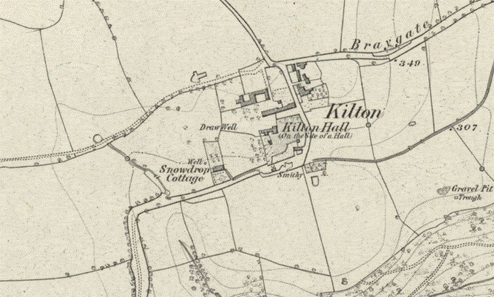
So it seems likely that the village fell into
decline in the 1843-53 period when the new owner of Skelton estate, John Thomas
Wharton, took over. That said, the 1841 census records only 10 houses in the
village so it seems it was declining even then.
By the time the next census was taken in 1851, there were about seven
buildings left, so the village’s decline seems to have been slow and organic.
1853-1856
The
Crimean War

John George Farndale,
the son of John Farndale, the
author (K1),
the Kilton 1 Line
, and the Founder of the Ontario 1 Line, took part in the Crimean
War and there are letters from him from Sebastopol on his
web page. He served in the 28th of Foot, a Yorkshire Regiment and may have
transferred to that Regiment from the Coldstream Guards. His descriptive
letters show that he took part in the battles of Alma, Balaclava and Inkerman
and was at the Siege of Sebastopol.

September 1854: The Battle of
Alma. The first battle of the War. An Anglo French Force defeated the Russian
opposition. French and British engineers started to build siege lines along the
uplands south of Sebastopol, from their base at Balaklava. By 5 October the
Allies had 120 guns ready to fire and the Russians had about three times as
many. An artillery battle began. The Allied Fleet pounded Russian defences.
October 1854: The Battle of
Balaklava. This gave the Russians a
morale boost and convinced them that the Allied lines were spread too thinly.
On 4 November 1854, John George Farndale wrote: “Heights of
Sebastopol, November 4th, 1854. Dear Father. I received your letter
of 26th of last month, and was glad to hear that you were all well
and in the enjoyment of health. I suppose your papers in England say that
Sebastopol is taken, but I can tell you very differently. It is now seventeen
days since we commenced the attack on the town, and there is no sign of it
being taken yet. I thought we should have had it by now, but I assure you it is
no easy task. Since I wrote last we have had great ravages in the army – the
first by sickness; then the cholera came amongst us and swept a great many
away. We then went on board for Russia, in the latter part of August, and
landed without opposition September 14th, and started for Alma on
the 18th. On the 20th we were before Alma, and commenced the attack
about eleven o’clock against 50,000 Russians, and defeated them after three
hours’ cannonading and musketry; and it took us two days to bury the dead, and
send our wounded on board ship for Scurati. We then started for Sebastopol, and
reached it after eight or nine days’ march; we had to go a great way round. As
soon as we got in front and settled, we commenced throwing up batteries and
breast works, under fire of the enemy. We finished them after about five days
and nights’ hard working, and opened fire on them on the 17th of
last month, and have been battering away ever since, and are likely to continue
doing so for some time to come. We have greater opposition than we expected.
There was a faint attack made on our rear army a few days ago, which cut up our
cavalry fearfully, but were defeated in the end. Our loss is not so great,
considering all the circumstances of the case. I have escaped as yet, thank
God! I have had a narrow escape: one morning, as we were relieving guard, two
privates and a sergeant were shot close by me with one ball. I think I have
given you all particulars up to the present. Next time I write, I hope
Sebastopol will have fallen. Your affectionate son. John George Farndale.”
November 1854: The Battle of
Inkerman. The Russians were defeated, so moved their forces inside the city.
Towards the end of November a winter storm ruined the Allied camp and supply
lines and men and horses starved in the appalling conditions. John Farndale was
promoted to Lance Corporal, in about January 1855.
In February 1855, John George Farndale wrote: “Camp before
Sebastopol. I now take the first opportunity of writing to you hoping you are
in good health as I am at present. I received your letter on the 5th
of this month and also the newspaper and was glad to hear from you. You are in
great haste to hear from me again, you hardly will give time to write! I have
been for writing all this month but had not the ink. I had to send to Balaclava
for it. I have been laid up in my tent with frost bitten feet nearly all this
month, but I am better again and fit for duty. I have had capitol health ever
since I landed in the Crimea, thank God for it. I can assure you there is very
few of the old hands left now of what came out with us from England. The
Colonel received your letter and thinks that I never write to you by the way
you write. As to the promotion you were talking about, I received the Lance
Stripe about a month ago. The Colonel promised to push me forward if I minded
myself, but he was afraid to promote me sooner on account of being so very
young. You also mention in your last that you heard from DW Waldy that I was
slightly wounded. I never received any wound more than a slight cut on the nose
from a stone that was sent up from a ball. The siege is progressing very slowly
but I think we will soon open a new siege. Things begin to look a little
better. We have received the winter clothing and are getting provisions a
little better. We want the wooden houses next, although I think as we have done
so long without, we could manage without them altogether. However I hope that
before you get this, Sebastopol will be ours and then we will be thinking about
returning to old England again. I think I have given you all the news I can at
present. The Colonel will send you a few lines in this letter of mine. I am
getting tired and want to go to bed, so I must conclude with kind love to
brothers and sisters and all enquiring friends. I accept the same yourself.
Your affectionate son. J G Farndale.”
There was an Ensign Waldy who
was promoted to Lieutenant on 8 February 1855, who served with the 28th
Regiment in Crimea.
Later in February 1855, John George Farndale wrote: “Camp before
Sebastopol. Dear Sir. I now hasten to answer your letter which I received this
morning. I was glad to hear from I assume you! My father oft mentions you in
his letters. I have had a letter written these two or three days waiting for
the mail to send to father. I have to say you have had all particulars from him
about the war. You ask when will we get into Sebastopol? I can tell you we are
making great preparations. We are getting a great many more guns than we had
before, and mortars which will fire 112 pounders, which will shake Sebastopol.
And if they do not give up then, we will storm it by force. English, French and
Turks. There will be a great many lives lost in taking it, we have lost all our
army we have brought with us. They are all young soldiers who have come out
last. If I live to see it over and get back to old England again, which by the
blessing of God I hope to do, I will tell you takes that will make your hair
stand on end! You ask if all accounts were true about what I sent you. I can
assure you it was but too true. Now the weather is a great deal warmer and
better provisions. When the main army has gone to the grave, any man who has
got …”
On 24 August 1855 the Allies
started their most severe bombardment. The Battle of Tchernaya. On 28 August
1855 the Russians abandoned the southern side of Sebastopol.
September 1855: The Battle of
Redan. The British assault on the Great Redan failed. The Battle of Malakoff.
The French seized the Malakoff redoubt, making the Russian defence untenable.
The fall of Sebastopol led to Russia’s defeat in the Crimean War, but cost
heavy Allied casualties.
The Crimean War was one of
the first campaigns which used techniques of modern warfare including explosive
naval shells, railways and telegraphs. But the War showed significant
logistical, medical and tactical failures and led to the professionalism of
medicine led by Florence Nightingale. The Imperial Russian Army would take
decades to recover and the defeat would be a catalyst for social reforms and
the abolition of serfdom in Russia.
…Was there a man dismayed? Not though the soldier knew, Someone had
blundered. Theirs not to make reply, Theirs not to reason why, Theirs but to do
and die. Into the valley of Death ….
…Cannon to right of them, Cannon to left of them, Cannon behind them,
Volleyed and thundered; Stormed at with shot and shell, While horse and hero
fell. They that had fought so well, Came through the jaws of Death, Back from
the mouth of hell, All that was left of them, …
(From The Charge of the Light Brigade by Alfred, Lord Tennyson)
You will also find a detailed chronology of the Crimean War, as it may
have impacted on John, on the page of the Ontario 1 Line.
A London cholera epidemic killed more then 10,000
people.
Records for naval ratings began to give details of
birth, physical appearance, occupation and ships where served.
Vaccination against smallpox, administered through
workhouses, became compulsory and registers of those vaccinated were kept from
1862.
1854
The Great Fire of Newcastle and Gateshead.
In 1854, Anna Philips (nee Farndale),
daughter of William and Mary Farndale
(K1),
the Kilton 1 Line,
raised a suit successfully disputing the will of her father in law, William
Philips.
1856
The
Second War with China
The County and Borough Police Act 1856 required the
compulsory establishment of county forces.
By
1856, John Christopher Farndale the
Younger, son of John Christopher Farndale
the Elder, (W1),
the Whitby 4 Line,
was Captain of the Caspian headed for Nyman in Norway. See the mercantile adventures of John
Christopher Farndale the Younger. John the Younger was the most gallant
of the family of Master Mariners of Whitby and sailed widely, particularly to
ports in the Baltic.
On
18 November 1856, William Masterman Farndale,
the eldest son of John Farndale, the
author (and described as a merchant at the time of William’s wedding)(K1), the Kilton 1 Line married Jane Browbridge at
the Parish Church in Middlesbrough. William was an officer of HM Customs.
1857-1858
The Indian Mutiny

1857
The East India Company passed control of India to the
British government (“the Raj”), which lasted from 1858 to 1947.
The Matrimonial Causes Act allowed divorce on grounds
of adultery.
On 3 July 1857, John Christopher Farndale the
Younger, son of John Christopher Farndale
the Elder, (W1),
the Whitby 4 Line,
the gallant ship’s captain, married Christiana Ainslie at Wisbech in
Cambridgeshire. Although well inland, Wisbech was a port at the end of as long
shipping canal and John would make a second home there, along with Whitby. The
main family home was in Whitby until Christiana died in 1859.
By 1861, William Masterman Farndale,
the eldest son of John Farndale,
the author (K1),
the Kilton 1 Line
, the officer of HM Customs, was described as a tide
waiter at Cleveland port. A tide waiter was a preventative customs officer who
boarded ships and watched the landing of goods. In April 1857, he discovered a
fire on the ship Hydrus in Middlesbrough and caused the fire to be
extinguished to save the vessel, though the captain was found ‘burnt to a
cinder’ in his cabin.

1858
The Great Stink in London accelerated the construction
of sewers.
1859
Disraeli's Reform Bill.
Diphtheria epidemic.
Charles Darwin’s On the Origin of Species was
published.
Medical registers began to record medical
practitioners.

The property where William Farndale,
son of William Farndale
(A1),
the Bishop Wilton Line,
a shepherd, was staying in Bishop Wilton was sold at auction in 1859 and
another in 1862. He had married Mary Leppington in 1846. By 1881, they had
moved to Barwick in Elmet near Tadcaster and the family lived at Black Fern
Lodge.
Elizabeth Farndale,
younger daughter of Matthew and Hannah Farndale,
(K1), the Australia 1 Line
married William Darby of Ely in Birregurra, Victoria, Australia in 1859. They
later lived at Colac. The Colac Reformer on 26 October 1918 wrote: Mrs Wm.
Darby, an old and well known resident of Colac for the past 65 years, passed
away on Thursday morning, at the advanced age of 84 years. The deceased lady
arrived in the town in 1853, in company with her parents (Mr and Mrs Farndale)
and her sister (Mrs W Martin) and a few years later married the late Mr W.
Darby, who for many years carried on a general store at Colac east. Mrs Darby
was of a kindly and genial disposition, and endeared herself to a large circle
of friends. For a considerable time past she suffered from partial blindness,
but she bore this affliction with more than ordinary resignation. Nothing
delighted her more than for some relative or friend to drop in and read to her
the news of the day, the changing fortunes of the war being followed with keen
interest. Even up to the last, though suffering intense bodily pain, her bright
and cheerful temperament still remained with her, Christian fortitude and
endurance being fully exemplified. The funeral of deceased is timed to leave
her late residence at half past ten o'clock this (Saturday) morning, for the
Colac cemetery.



Elizabeth Farndale who married William Darby William Darby of Ely who married
Elizabeth Farndale in Victoria, Australia Elizabeth Darby, nee Farndale.
1861
Population of UK was 29 million.
By 1861, William Farndale
(A1),
son of, Jethro Farndale
and Alice nee Clarke of Coxwold, the Ampleforth 1 Line,
was a licensed hawker. He had married Bessie Langdale in Barton le Street on 24
July 1847. He became a licensed hawker and letter carrier by 1871, and later
sub post master at Hutton Ambo.
In
1861, Ann Farndale,
daughter of John and Dinah Farndale,
(W1),
the Whitby 4 Line
was a dressmaker living on her own in Brotton.
On
21 December 1861, John Christopher Farndale the Younger, son of John Christopher Farndale
the Elder, (W1),
the Whitby 4 Line,
the gallant ship’s captain, married Jane Barnett Telford at Wisbech in
Cambridgeshire. Although well inland, Wisbech was a port at the end of as long
shipping canal and John would make a second home there, along with Whitby.
By
1861 John Farndale,
son of John and Ann Farndale,
(K1),
the Whitby 5 Line
who had married Margaret Dawson in 1838 was a quarry waggoner in Eskdaleside.
By 1900, he was a carrier. The country carrier features in the works of Thomas
Hardy and undertook local deliveries linking villages and their trades. They
would operate on a humble scale, setting out in the morning and returning at
night. John and Margaret had a remarkable family. John’s eldest son, Thomas Farndale,
was a successful innkeeper in Wakefield, whose son was Joseph Farndale CBE KPM,
Chief Constable of Margate, York and Durham and his younger son was Joseph Farndale,
Chief Constable of Leicester, Chesterfield and Birmingham.
1861 to
1865
The American Civil War

The American Civil War led to a blockade of cotton
exports which had a devastating effect on the English textile industry. This
led to riots in 1863.
In Russia, Alexander II emancipated serfs.
By 1861 John Farndale,
the second son of William Farndale
(K1),
the Kilton 1 Line
had started his career as an author. He wrote prolifically
about the age of Victorian innovation, Saltburn, Kilton
and the wider Farndale family. His works are transcribed on their
own webpage. He provides a remarkable witness to the excitement of
the Victorian Age as well as to the Farndale family and area where they lived.

John Farndale
He wrote:
·
A Guide to Saltburn by the Sea and the
Surrounding District, With remarks on its picturesque scenery,
Fifth Edition, Dedicated to John Thomas Wharton Esq of Skelton, By John
Farndale, Late of Skelton Castle Farm, Darlington, Printed by Charles W Hird,
1864
·
The History of Kilton, With a Sketch of
the Neighbouring Villages, By the Returned Emigrant,
Dedicated to the Rev William Jolley, Toronto, Canada, America, Middlesbrough,
Burnett & Hood, “Exchange” Printing Offices, 1870
·
The History of the Ancient Hamlet of
Kilton-in-Cleveland, printed by W Rapp, Dundas Street,
Saltburn 1870;
·
Memoirs, 1874.
1862
The Land Registry Act 1862 led to recording of the
conveyance of land. The system was improved in further Acts in 1875, 1897 and
1925.
The last recorded slaving voyage left from Liverpool.
Prince Albert died of Typhus.
John Christopher Farndale the
Younger, son of John Christopher Farndale
the Elder, (W1),
the Whitby 4 Line
had
to deal with an assault on the high seas, on his ship the Ada. See the mercantile adventures of John
Christopher Farndale the Younger for details of the incident.
On 12 July 1862, Martin Farndale
(my own direct ancestor), the second son of George Farndale
(K1),
the Kilton 1 Line,
died of empyema after being kicked by a horse. He is buried at
Skelton church.
On
20 April 1862, Thomas Farndale, son of
John and Margaret Farndale,
(K1),
the Whitby 5 Line
married
Sarah Bell in Wakefield. Thomas and Sarah founded the Wakefield 1 Line.
Thomas was a successful innkeeper of the Smith Arms in Wakefield. Thomas and
Sarah’s son was Joseph Farndale CBE KPM
the Younger, a renown Chief Constable of Bradford. We have plenty of records on
Thomas Farndale’s webpage, including his regular attendance at the Wakefield
Licensed Victuallers’ Annual Ball.
By
1862, Joseph Farndale the Older,
son of John and Margaret Farndale,
(K1),
the Whitby 5 Line
formerly
a drainer, was a police constable in Middlesbrough. There are extensive records
of his time at Middlesbrough, rising to police sergeant. On 6 November 1865, he
married Jane Newton there and was an Inspector in Middlesbrough by November
1867.
1863
The first urban underground railway opened from
Paddington to Farringdon.
The Confederates defeated at the Battle of Gettysburg.
1864
A
flood in Sheffield left 270 dead.
1865
In April 1865 John Farndale, the author (K1), the Kilton 1 Line suffered
an assault in Stockton over a row with William White Collins Seymour over an
allegation of libel regarding an unpublished publication, Goliah is Dead. “EXTRAORDINARY
ASSAULT CASE AT STOCKTON. Yesterday, at Stockton, before J Byers, Esq. (mayor),
W Richardson, P Romyn and R Craggs, Esqs., Mr W W C Seymour, a gentleman of
considerable celebrity, was charged by Mr John Farndale, of Stockton, with
assault. The plaintiff, in narrating his complaint said that the defendant, a
person whom he had never spoke to in his life, and with whom he had no
connection whatever, assailed him on the previous day in the Market Place. He used the most abusive language to him,
charged him with being the author of a certain handbill entitled “Shortly will
be published the Life of the Notorious Seymour”; alleged also that he had been
actively employed in circulating copies of that bill. Exasperated by the
language which the defendant had used he (the plaintiff) did call him a “wicked
brute”, when he (defendant) lifted his foot and kicked him behind. (Laughter).
Had been labouring in great pain ever since and was almost unable to sit in
consequence. Never gave the man any offence. To the bench: The kick was a
severe one. In fact it had inflicted a wound. (Great laughter). He had
undergone a medical examination that morning, and intended to be examined
again. (Roars of laughter). Defendant charged him with writing some kind of
circular but he (the plaintiff) knew nothing about it. The assault took place
at the Shambles ed. The plaintiff was further subjected to a severe examination
by the defendant, the cross fire kept up between the two creating considerable
merriment in court. Two witnesses, William Artian and George M’Naster, were
called as witnesses by the plaintiff, and from their evidence it appeared that
an assault had been committed. Defendant, in addressing the Bench, enumerated
several grievances, mentioning inter alia the fact that he (plaintiff) had
called him a liar, a monosyllable he would not take from any man in the
country, and he held that the assault, not nearly so severe as had been
alleged, was in some sort excusable. The Bench, after consulting for a short
time, said they were of the opinion that the assault had been committed,
although doubtless there had been some provocation, therefore they fined
defendant 5s and costs.”
1866
A cholera epidemic killed 5,500 people in London’s East
End.
On 9 March 1866 John Henry Farndale,
son of Henry and Elizabeth (nee
Appleton) Farndale (K1)
the Great Ayton 3
Line, was killed by a fall or ironstone at the Poston Mines, Ormesby, Middlesbrough. An Inquest was held on 10
March 1866. The accident seems to have been an isolated incident. Ormesby mine
was short-lived (1865 to 1892), mining an outlying deposit under Ormesby Bank.
The seam occured quite near to the surface, and roof falls at the site of the
mine had been commonplace.

1867
The Second Great Reform Act enfranchised male town
dwellers and widened eligibility for men in rural areas.
Bill passed for the Confederation of North American
Colonies - united under the name, the Dominion of Canada
The Abyssinian Expedition
The Agricultural Gangs Act 1867 regulated the
employment of women and children and required licences for gang masters.
1868
The abolition of public executions.
The transportation of convicts to Australia ended.
On 22 January 1868, John Christopher Farndale the
Younger, son of John Christopher Farndale
the Elder, (W1),
the Whitby 4 Line,
the gallant ship’s captain, was lost at sea in the Bay of Biscay. See the mercantile adventures of John
Christopher Farndale the Younger for extensive reports of the
tragedy.
1869
The Debtor’s Act 1869 ended imprisonment for debt.
The completion of the Suez Canal. This led to a strong
presence by Britain in Egypt, Sudan and East Africa.
On 16 August 1869, Robert Farndale (A1), son of William and Margaret Farndale
of the Bishop Wilton
Line, had left Yorkshire for London and married Caroline
Lester in Putney. He became a carpenter, and they lived around Cooper’s Lane in
Putney. Robert and Caroline’s descendants continued to live at Putney and
Bethnal Green.

The Cooper’s Arms, Putney
There was a John Farndale who
served with the Grenadier Guards for three years until he was discharged on 25
July 1872. He may have been related to the Bishop Wilton Line
(A1). He was the son of William Farndale, a market
gardener and her later became a clerk at Clerkenwell, London.
Between 1869 and 1871, Joseph Farndale the Older,
son of John and Margaret Farndale,
(K1),
the Whitby 5 Line
was
Chief Constable of Chesterfield Police in Derbyshire. There are extensive
records of his time there.
1870
The Married Women‘s Property Act 1870 gave married
women the right to keep their own earnings and property inherited after
marriage.
Women now admitted to Oxford and Cambridge
Universities.
The Agricultural Depression – land values dropped and
extensive bankruptcies amongst farmers.
The Franco Prussian War 1870 to 1871.
Teachers were required to keep attendance lists and log
books of events on a weekly basis.

By 1870, John Farndale, the
author (K1),
the Kilton 1 Line,
looked
back nostalgically on Kilton
which he felt had become a victim not only of the "Monstre farm"
but also of the Industrial Revolution. He lamented:"And now dear
Farndale, the best of friends must part, I bid you and your little Kilton a
long and final farewell. Time was on to all our precious boon, Time is passing
away so soon, Time know more about his vast eternity, World without end oceans
without shore."
In about 1870 (though it is possible he
was still in the Grenadier Guards in 1872, being discharged that year) John George Farndale, the son of John Farndale,
the author (K1),
the Kilton 1 Line
, veteran of the Crimean war, emigrated to Canada. He was unmarried at this
stage. There is an unsubstantiated story that he went to Australia first. He is
the Founder of the Ontario 1 Line.
1870-1871
The Franco-Prussian War.
On 8 February 1870, William Farndale, son
of, William Farndale and
Bessie nee Langdale, (A1),
the Ampleforth 1
Line, married Jane Gale at Bedale Church. William worked in
the iron works and steam engine works in Stockton and William and Jane had a
family of seven. William is Founder of the Stockton 3 Line.
1871
Population of UK was 31.6 million
Bank holidays were introduced for bank workers and soon
were practised more widely.
The
Great Gale hit the north east coast of England.
The Trades Union Act
The Regulation of the Forces Act 1871 (“the Cardwell
Reforms”) created a regimental structure for the army.
By 1871, Thomas Olijah Farndale Junior,
son of Thomas Olijah and Mary Farndale
(or Farndell) the Carlisle Line, was a printer’s boy aged 14
at Botchergate, Carlisle. Later he became a coach painter in Toxteth Park,
Lancashire.
By 1871, Martin Farndale, the
sixth child of William and Mary Farndale
(K1),
the Kilton 1 Line,
was farming 600 acres at Kilton Hall Farm with 16 employees. He had married
Elizabeth Hours in 1833. There are extensive records about his life from
newspaper articles and the like, which you will find on his webpage. He gave
witness in court to damage to his property. He suffered an outbreak of pleuro
pneumonia on the farm. Martin and Elizabeth had no children and Kilton Hall
Farm passed down to John Farndale’s son Charles Farndale who
farmed with Martin.
By 1871, George Farndale, the
third son of George Farndale (my own
direct ancestor) (K1),
the Kilton 1 Line,
was a bricklayer in Middlesbrough. He had also worked in the ironstone mines.
By 1871 Matthew Farndale,
son of George Farndale
(my own direct ancestor) (K1),
the Kilton 1 Line,
was a foreman at Sand Banks, Coatham He had married
Ann Readman in 1885. Ann ran a temperance hotel in Saltburn. Matthew and Ann
were founders of the Coatham Line.
In 1871 Joseph Farndale,
son of John Farndale,
(K1),
the Whitby 5 Line
was a carter of bricks living in Brick Yard Lane in St
Nicholas, York.
By 1871, William Farndale, son of William and Sarah Ann Farndale (K1), the Whitby 5 Line
was an ironstone miner
in Loftus.
He was founder of the Loftus 3 Line.
Between 1871 and 1882 (11 years), Joseph Farndale the Older,
son of John and Margaret Farndale,
(K1),
the Whitby 5 Line
was
Chief Constable of Leicester Police. There are very extensive records of his
time there.

Joseph Farndale probably from his time with the
Leicester Police Force (kindly provided by the West Midlands Police Museum).
By 1871, Robert Farndale, son of
Henry and Elizabeth (nee
Appleton) Farndale (K1)
the Great Ayton 3
Line, was shoemaker in Hartlepool. He had married
Mary Butterworth in 1862 in Hartlepool. He became involved in liberal politics
in Hartlepool and he became a master boot and shoe maker. Robert and Mary
founded the Hartlepool 1 Line.

1872
The Ballot Act (secret ballot)
1873
The Second Ashanti War
The Panic of 1873 was the start of an economic
depression from 1873 to 1877.
The Returns of Owners of Land listed those with more
then one acre in England and Wales.
In 1873, Joseph Farndale the Older,
son of John and Margaret Farndale,
(K1),
the Whitby 5 Line
Chief
Constable of Leicester Police formed the Leicester Borough Police Band and they
gave concerts in the town’s public parks.

1874
The Public Worship Regulation Act
The Factory Act 1874 introduced a 56 hour week.
The Births and Deaths registration Act made
registration compulsory, within 42 days.
Massive
storms hit the Yorkshire coast.
On 14 May 1874 a Council meeting was held at the
Temperance Hall in Saltburn of Matthew and Ann Farndale,
son of George Farndale (my own
direct ancestor) (K1),
the Kilton 1 Line.
A resolution was passed which caused the ironstone miners of Cleveland to cease
work and threaten the whole iron industry of the north. Regular meetings were
held at the Temperance Hotel over the coming months. By 1881, Matthew was
working as an agricultural labourer and the family lived at Allerton Terrace,
Coatham. Matthew and Ann were founders of the Coatham Line.
John Farndale, son of Joseph and Margaret Farndale, (K1), the Whitby 5 Line
had married Elizabeth Walker in York
in 1871, and was a carter there in York 1874.
1876
Alexander Graham Bell patented the telephone.
The Battle of Little Big Horn in USA.
Queen Victoria proclaimed Empress of India.
One of the sons of George Farndale (K2), of the Stockton 1 Line
was William Leng Farndale (K2), born in 1876. William moved
to Rothbury in Northumberland and became a Sergeant in the Northumberland
Hussars by 1902. That Regiment served in the Boer War, so he may have served
there. He ran a distillery business, continuing the business of Geo Storey and
Company. We know a lot about him. His son, George Patrick Farndale
(K2),
and his descendants continued to live at Rothbury, and comprise the Northumberland
Line.
In April 1876, William Farndale son of, Joseph and Mary Farndale,
(K1),
the Great Ayton 2
Line, a joiner in Great Ayton was awarded
£5 and costs to be paid at 8s per month by Thomas Hogg, a nineteen year old
clerk who had wantonly shot William’s dog, a ‘quiet, docile and harmless’
black and tan retriever.
1877-1878
The Russo-Turkish War.
1877
Britain annexed the Transvaal.
On 7 July 1877, Martin Farndale (my great grandfather), the son of, Martin Farndale and grandson of George Farndale (K1), the Kilton 1 Line,
married Catherine Lindsay at
St Cuthbert’s Church, Darlington. The Lindsay family were of Scottish origin, and
Catherine was born in Alnwick, the daughter of a shoemaker, of Queen’s Head
Yard, Alnwick. Martin and Catherine were the founders of the Tidkinhow Line.
It
appears that the newly wedded couple moved to a cottage at Kilton-Thorpe where
their eldest son John Farndale was born
on 22 December 1877, Elizabeth Lindsay (“Lynn”)
Farndale (later Barker) was born on 11 December 1879 and Martin Farndale was
born on 8 June 1881.
Martin had been born on Fogga Farm (the farm of his
maternal grandfather) on 19 September 1845.


Martin Farndale aged
32, about the time of his wedding
Catherine Lindsay on 29 October 1875,
shortly before her marriage
1878-1879
The Second War with Afghanistan
In October 1878, Peter Farndale (K2), in his capacity as a legal
clerk, confronted a ‘desperado’ threatening a women with a knife and “seized
the infuriated man and prevented him from carrying out his rash intention”.
1878
The Factory and Workshop Act 1878 consolidated previous
legislation and applied it to all trades. The minimum working age was raised to
10 years old and children under 10 were to attend school. The age was later raised
to 11 in 1891 and 12 in 1901.
On 22 June 1878, the Whitby Gazette reported the
accidental death by burning of Ada Patton, the domestic servant of William Farndale (W1), the Whitby 4 Line, the Master Mariner. Ann
Farndale had tried to extinguish the fire.
1879
The Zulu War
A public telephone service was introduced in Britain.
1880
The First Anglo-Boer War.
The Elementary Education Act 1880 made schooling
compulsory for 5 to 10 year olds and children under 13 in work had to
demonstrate a certain standard.
Greenwich Meantime (“GMT”) was introduced across
Great Britain.
The first British telephone directory.

On 24 March 1880, John George Farndale,
the son of John Farndale,
the author (K1),
the Kilton 1 Line
, veteran of the Crimean war, who had emigrated to Canada, founder of the Ontario 1 Line married
Elizabeth Sanderson aged 27, a Methodist, daughter of Richard and Martha Sanderson
of Vaughan, Ontario, at Etobicoke, Ontario, Canada.
1881
The UK population was 35 million.
By 1881, John Farndale,
son of William Farndale,
(A1),
the Bishop Wilton Line was a groom at Clayton, west of Bradford. He died in
1893 at South Lodge, Bramham Park, as a result of an accident.
By 1881, Thomas Farndale, son of
William Farndale, (A1), the Bishop Wilton Line
was
a shepherd at Barwick in Elmet, near Tadcaster, like his father. He had married
Mary Weighill in 1880. Their son, George Weighill Farndale,
was killed at the Battle of the Scarpe in 1917. He was later a cattleman and
farm labourer.
In 1881, James Farndale (A1), the Ampleforth 1 Line,
was a gardener in Huttons Ambo. He married Elizabeth Shepherdson in 1890.
In 1881, George Farndale (A1), the Ampleforth 1 Line,
was domestic footman, working at 34 Belgrave Square, London.
By 1881, William Farndale,
the eldest son of George Farndale
(my own direct ancestor) (K1),
the Kilton 1 Line,
was working in the mines at Margrove
Park, Stanghow. He also worked on farms and as a gardener during his life.
By 1881, Teresa Featherstone (nee
Farndale), the daughter of John Farndale, the author (K1), the Kilton 1 Line
, was a widow and a lodging housekeeper who ‘lets apartments
to gentlemen’ in Middlesbrough.
By 1881 Annie Marie Hall (nee Farndale),
the daughter of John Farndale, the
author (K1),
the Kilton 1 Line
, had married Thomas Hall, a farmer of 200 acres near Stokesley. By 1901, Annie
was a widow and running the farm herself, with her son by then 38.
Charles
Farndale was the son of John
Farndale, the author (K1), the Kilton 1 Line.
Charles took over Kilton from Martin
Farndale, his uncle, since Martin had no children of his own.
Martin was a farmer at Kilton of 207 acres by 1851, with 9 employees.
By then Charles his nephew was also living at Kilton. By 1871, Martin was
farming 600 acres at Kilton at the age of 73, with 16 employees. By 1881 Martin
had retired and Charles was shown as a farmer of 577 acres with 9 employees.
There are very extensive records of Charles and his family, and many
photographs, on his webpage.

By late 1881 Martin Farndale (my
great grandfather) and Catherine nee Lindsay (K1), the Kilton 1 Line, had moved to Tranmire Farm
near Whitby where George Farndale was
born on 9 January 1882 and Catherine Jane (“Kate”) Farndale
(later Kinsey) was born on 16 June 1884. There is a family story
that Martin Farndale asked
his younger brother Matthew Farndale to go
to make a bid for Craggs Hall Farm near Brotton. The story goes that Matthew
returned saying that he'd taken the farm - for himself! True or not that is
where Matthew went and Martin went to Tranmire, a farm some ten miles along the
road to Whitby - a moor farm near Ugthorpe situated on Roxby Moor.

Tranmire Farm, near Ugthorpe
On 8 October 1881, John Farndale, aged 33,
the son of, Martin Farndale and
grandson of George Farndale (K1), the Kilton 1 Line, married Elizabeth
Featherstone at the Parish Church, Hinderwell. John and Elizabeth founded the
John Farndale section of the Loftus 2 Line.


John Farndale A later photograph of
Elizabeth Farndale (nee Featherstone)
On 10 September 1881, Charles Masterman Farndale,
son of William Masterman Farndale,
and grandson of John Farndale, the
author (K1),
the Kilton 1 Line
, a shipbroker’s clerk and later a weigher in Runcorn near Liverpool, faced
serious charges, but the case was thrown out. In 1892, his brother William Henry Farndale,
a rail clerk was also in trouble with the law. Each died at the young ages of 31
and 27 respectively.
By 1881, Samuel Saunders Farndale,
son of William and Sarah Ann (nee
Saunders) Farndale (K1),
the Whitby 5 Line
was an ironstone miner in the mines at Egton.
In 1881, William Farndale, son
of Joseph and Margaret Farndale, (K1),
the Whitby 5 Line
who had married Mary Jane Peacock in York in 1871, was a goods porter and
local methodist preacher. By 1891, he was a town missionary in Macclesfield,
Cheshire. In 1901 William was a baker and confectioner. William and Mary’s son
was Rev Dr William Edward Farndale,
who was a leading methodist and President of the Methodist Conference who
sounded the Call of the Countryside and ‘back to the soil’ campaign.
In that same year, Henry Farndale, brother
of William Farndale, son
of Joseph and Margaret Farndale, and uncle of Rev Dr William Edward Farndale
(albeit he was only born that year!) (K1),
the Whitby 5 Line
was in the York Union Workhouse.
By 1881, Richard Farndale, son
of Joseph and Mary Farndale,
(K1),
the Great Ayton 2
Line was cartwright in Great Ayton like his
father, having worked as an agricultural labourer in previous years. By 1911 he
had moved to Harrogate, where he became a bootmaker.
By 1881 Joseph Farndale,
son of Joseph and Mary Farndale,
(K1),
the Great Ayton 2
Line after many years as a joiner in Middlesbrough, had become
a contractor builder in Barrow in Furness. He married Margaret Robson in Great
Ayton in 1856, and they had a large family in Barrow imn Furness, Cockermouth
and Ulverston, but many of the children sadly died young. His son John Willie Farndale,
would leave Barrow for South Shields and founded the South Shields 2 Line.
In 1881, Sarah Maria Farndale,
daughter of Matthew
and Ann (nee Readman) Farndale, (K1), the Coatham Line, the foreman at Sand Banks,
Coatham was a laundress at Kirkleatham. She married Samuel White in Marske in
1888.
1882
The Married Women’s Property Act 1882 gave married
women in England, Wales and Ireland the same rights as single women to control
their financial affairs, including ownership of property, running a business,
being liable for debts and making wills.
Between 1882 and 1899 (17 years), Joseph Farndale the Older, son of John and Margaret Farndale, (K1), the Whitby 5 Line was
Chief Constable of Birmingham City Police. There are very extensive
records of his time there.

Joseph Farndale the Older
was involved in the Fenian Dynamite Conspiracy with a
peak of activity in 1883. You can read extensively about this on his webpage,
including the trials of Daly, Egan and McDonell, debates in Parliament and
Joseph’s later doubts about some of the evidence.


1883
On 27
January 1883, Thomas Farndale (A1), the Ampleforth 1 Line, was a farm worker but only for a
short time: The Yorkshire Gazette, 27 January 1883 reported: Malton. Norton
Police. Mr Jno Southwell, farmer, of Ganton Wold, claimed £1 compensation from
Thomas Farndale, of Leavening, for leaving his service without just cause,
whereby he had suffered damage to the amount claimed. Mr Southwell’s agent hired
the youth at Malton on the 23rd of December. He entered service on the 26th,
and ran away on the 7th of January. He now alleges that he “could not settle”.
The Bench ordered him to pay the £1 claimed and 4s 6d costs.
By 1883, John Farndale, the son
of, Martin Farndale (K1), the Kilton 1 Line, and now the Loftus 2 Line
was a railway porter at Loftus. The Whitby Gazette, 24 February 1883: WHITBY
COUNTY COURT. The monthly sitting of this Court took place on Wednesday before
Mr Bedwell, judge,. John Farndale, railway porter, Loftus, and Elizabeth, his
wife, sued Charles Hodgson, groom at the Black Horse, for £12 5s, amount due
for maintenance of a child. Mr Woodwark appeared for the plaintiffs, for whom a
verdict was given for the full amount with costs.

John Farndale worked
with the London North Eastern Railway as a signalman. He used to bathe in the
sea at Skinningrove every Sunday morning in Summer or Winter.
1884
Gordon reaches Khartoum
The Berlin Conference divided Africa among the European
colonial powers.
The Third Reform Act 1884 gave the vote to most male
householders in the countryside.
Joseph Farndale the
Younger, son of Thomas and Sarah nee Bell
Farndale, (K1),
the Wakefield 1 Line
and nephew of Joseph Farndale the Elder,
the Chief Constable of Birmingham, joined the police in Halifax at the age of
twenty. By 1893, he was a Detective Inspector.
1885
By the
time James Farndale (later
to emigrate to USA where he was a Senator for Nevada) was born on 22 December
1885, the family of Martin Farndale (my
great grandfather) and Catherine nee Lindsay (K1), the Kilton 1 Line, had moved to Tidkinhow farm on Stranghow
Moor near Guisborough. Martin and Catherne were the founders of the Tidkinhow Line.
They
would have twelve children. The young family were brought up at Tidkinhow and
the other six children were born there. William Farndale was
born on 22 June 1887, but died only two years later on 19 July 1889. By this
time Mary Frances Farndale (later
Brown) had been born on 22 January 1889 and another son also to be
called William Farndale, in
January 1891. Two and a half years later came Grace Alice Farndale (later
Holmes), named after her mother's sister and her mother's mother,
Alice Lindsay. Then two years later Dorothy Annie Farndale (later Ross
and then Drake) was born on 24 May 1895 to be followed by the last
and youngest child, my grandfather, Alfred Farndale on 5
July 1897.
In May 1885, William Farndale, son of William and Sarah Ann Farndale (K1), the Whitby 5 Line
an ironstone miner
in Loftus,
and founder of the Loftus 3 Line,
witnessed the death of his colleague, Henry Durham, in the Loftus mines.
During the day they had not found a fault and had just finished work, and
William was discussing where a hole should be fired next morning with Henry
Durham and another called Wallace. Henry Durham was then struck by a falling
stone and killed – they couldn’t later say whether the stone had come from the
roof or the sides. They decided that the roof was not good since the last shot
had been fired, but didn’t think it was about to fall imminently, but they then
‘kept from underneath’ as much as possible. The Inquiry returned a verdict of
‘accidental death’.
1886
Gladstone's Home Rule Bill for Ireland.
In 1886, William
Farndale (A1), the Ampleforth 1 Line,
by then the sub
post master at Hutton Ambo, near Malton, heroically saved a child from drowning
in the river at Hutton Ambo, but tragically the mother
and other child were drowned. Read the newspaper articles about the incident on
his webpage.
In 1886, George Farndale, son of
Matthew
and Ann (nee Readman) Farndale, (K1), the Coatham Line, the foreman at Sand Banks, Coatham
was the goalkeeper for the Redcar Crusaders football team. He married Mary
Lawson at the Parish Church in Coatham in 1890. He was later a pipe layer for
the water board in Coatham. His brother John Thomas Farndale remained
single and was an estate land drainer and woodman.
1887

Queen Victoria's Golden Jubilee
Joseph Farndale the Older,
Chief Constable of Birmingham, was very involved in the
Queen’s visit to Birmingham. Yorkshire Post and Leeds Intelligencer, 24 March
1887: Her Majesty’s first official visit to the provinces in her Jubilee
year has been an unqualified success – the weather splendid for the season of
the year, the crowds of her subjects in the streets large, orderly and
enthusiastic, and the arrangements for her reception, progress, and departure
perfect in every particular … The police arrangements, carried out under the
superintendence of Chief Constable Farndale, were admirable so far as they
went; but it would have been impossible for the police to keep the streets
clear if they had not had the assistance of 400 firemen and several battalions
of volunteers, who lined the route. ..

1888
The first Kodak camera.
Jack the Ripper murders began in Whitechapel.
The start of professional football.
In 1888, Joseph Farndale the Older,
Chief Constable of Birmingham, was not deceived by a Jack the Ripper hoax by
Alfred Napier Blanchard and you can read the details on his webpage.
1889
First moving pictures recorded on celluloid.
The Prevention of Cruelty to and Protection of,
Children Act 1889.
Charles Booth began a detailed survey of the London Poor
including a map (The Life and Labour of the People).
On 5
December 1889, Thomas Farndale (A1), the Ampleforth 1 Line, then a letter carrier, married
Sarah Hannah Pugh in Stockton. He was later a stockman.


Thomas
Farndale Sarah Hannah Farndale (nee
Pugh)
The
comedian of the Farndale family:
Samuel Farndale,
son of Thomas and Sarah nee Bell Farndale,
(K1),
the Wakefield 1 Line, and
brother of Joseph Farndale the Younger,
later the Chief Constable of Bradford, was a humourist appearing at soirees in Wakefield
in 1889. He was a clerk of works at the time.
1890
By 1890, John Thomas Farndale, son of William Farndale the Master Mariner, (W1), the Whitby 4 Line,
was manager of the Thirsk Branch of the York Union Bank. We have extensive
records about his life. He was a free mason. He was a member of the naturalists
society of Thirsk. He was involved with the Church. He was involved in the
cycling club. He was a member of the Thirsk chess club. He was involved with
the National Society for the Prevention of Cruelty to Children (“NSPCC”). He
was involved with a historic pageant and play.
He continued to take an interest in Whitby, where he exported his
pageant ideas to. He was a member of the National Service League (campaigning
by 1911 to introduce compulsory military training).
He became a Commissioner of the Peace for North Riding in 1916. John was single
and he lived with his sister, Jane Farndale.

Four sisters of Charles Farndale’s
family at Kilton Lodge about 1890
1891
The population of the United Kingdon was 37.8 million.

200 lost their lives in the Great Blizzard.
By 1891, Hannah Elizabeth Farndale,
daughter of Robert Edward Farndale
(K2)
of the Stockton 2 Line
was a school mistress in Guisborough.
By 1891, John Farndale, the son
of John Farndale and Kate
(A1),
the Bishop Wilton
Line. still only 15, and his brother James Arthur Farndale
(only 13) were worsted spinner in Bradford. John married Hannah Bartle in
Bradford, and they had nine children. There is more about James Farndale below.
Worsted
is a high quality type of wool yarn (its name deriving from Worstead in
Norfolk). Worsted spinning was a big industry in Bradford by this time.
By 1891, Mark Farndale, son of William Farndale and
Mary nee Leppington, (A1),
the Bishop Wilton
Line was the gas stoker, responsible for the gas lights of
Barwick in Elmet.
By 1891, Tom Farndale (A1), the Stockton 3 Line,
was a furnace boy, aged 15. He got into trouble that year for stealing eggs and
was ordered to receive six strokes with a birch rod. He later worked in the
steam engine works at Stockton and as a fitter’s labourer.
In 1891, Robert Farndale
(A1),
the Ampleforth 1 Line was
a domestic servant, possibly the main butler, to the Piercy family
at Marchwell in Wales.
Marchwiel
Hall was a seat of the Broughton family and by 1837 was occupied by Townshend
Mainwaring, who then moved to Galltfaenan Hall on his marriage. The current
1840s-built country house has five main reception rooms, a ballroom, and 12
bedrooms, with adjoining stables and outbuildings set on 150 acres (61 ha) of
estate grounds. In 1883, its then owner, civil engineer Benjamin Piercy laid
out a cricket ground. In 1913, Sir Alfred McAlpine bought the property. Home to
the Marchwiel and Wrexham Cricket Club, Alfred developed it as "one of the
most picturesque settings for playing the game in the country”.
By 1891, Elizabeth Mary Blackburn (nee
Farndale), the daughter of John Farndale, the
author (K1),
the Kilton 1 Line
, was a widow and running her late husband’s bakery and confectionary business
in Middlesbrough. Her daughter was a music teacher.
In 1891, John George Farndale,
the son of John Farndale, the
author (K1),
the Kilton 1 Line
, veteran of the Crimean war, who had emigrated to Canada, founder of the Ontario 1 Line,
and married to Elizabeth Sanderson, was a farm labourer at Etobicoke, Ontario,
Canada. They had six children.

This photograph is of John George Farndale and
his family taken in about 1887 in Canada - his family left to right are George,
Teresa, Mark, Charles and Albert, with Elizabeth seated.
By 1891, Matthew Farndale, the
son of, Martin Farndale (K1), the Kilton 1 Line, was farming at Craggs Hall
Farm. He had married Mary Ann Liverseed in 1884 in Stockton. Matthew and
Elizabeth founded the Craggs Line.

By 1891 Joseph Farndale, son of
Richard Farndale, son
of Joseph and Mary Farndale,
(K1),
the Great Ayton 2
Line was bootmaker in Harrogate, having been a shoe and
boot maker in Great Ayton previously. He was also a pigeon
racer.
1892
On 21 April 1892, Samuel (Kirk) Farndale, son of William and Hannah Farndale,
(K1),
the Loftus 3 Line,
a labourer from Loftus, travelled from Liverpool to Quebec on SS Sardinian. He
seems to have come back home for a while, since he travelled back from
Liverpool to Halifax on the Carthaginian on 16 March 1895. He settled in
Oshawa, Ontario. On 20 March 1906, he married Mary Richardson at Kinsdale,
Ontario. He became a farmer at Brooklin, Pickering, Ontario. The locality in
Ontario was clearly settled from his compatriots from the same area, since the
towns there bore names like Pickering and Whitby Township. Kirk and Mary were
founders of the Ontario 2 Line.
1893
The Elementary Education (School Attendance) Act 1893
raised the school leaving age to 11 (and in 1899, to 12) years.
The Independent Labour Party was founded in Bradford.
Joseph Farndale the
Younger, son of Thomas and Sarah nee Bell
Farndale, (K1),
the Wakefield 1 Line
and nephew of Joseph Farndale the Elder,
the Chief Constable of Birmingham, became Chief Constable of Margate Police
(1893 to 1897).

1894
The Parish Councils Bill
The Royal Mail started to deliver picture postcards.
The Local Government Act 1894 established Urban and
Rural District Councils and Parish Councils elected by rate payers.
On 13 January 1894, William Farndale, the
son of William Farndale and
Jane nee Gale (A1),
the Ampleforth 1
Line, born in Bedale on 3 May 1870, married Mary Ann Carter
at Long Wittenham in Berkshire. The family then moved to Norwich and William
and Mary are the Founders of the Norwich Line.
An article in the Birmingham
Daily Post on 18 April 1942, suggests that the British habit of forming an
orderly queue was down to Joseph Farndale the Older,
Chief Constable of Birmingham. In the autumn of 1894 there was regularly a
terrible commotion at the Prince of Wales Theatre in Birmingham. The theatre
owner collaborated with the Chief Constable to start a system of queuing.
Joseph Farndale agreed to support the experiment and Birmingham gradually grew
accustomed to the habit.
1895
The Factories and Workshops Bill
The notification of infectious diseases became
compulsory.
The first Dictionary of National Biography.
In May 1895, George Farndale (A1), the Ampleforth 1 Line,
was conveying letters in his role as postman at Kirkham, near Malton, when he
was thrown from his horse and dislocated his shoulder.
In 1895, Mary Ann Martin (nee Farndale),
eldest daughter of Matthew and Hannah Farndale,
(K1), the Australia 1 Line ,
made over her husband’s land (William Martin had died in Birregurra on 27 May
1888) to her two sons William John Martin and Alfred Miro Vitericus Martin. You
can read more about the Australian Farndales
and about the Martin family.



![]() Mary
Ann Martin nee Farndale
William Martin
Mary
Ann Martin nee Farndale
William Martin
|
Elizabeth Clarissa Teresa Martin
Born 19 December 1853 (died 26 July
1946) |
Marion Amelia Susanna Martin
Born 15 September 1856 (died 1951) |
Anna Maria Martin
Born 1855 |
William John Matthew Martin
Born 16 May 1860 (died 1942) |
Alfred Miro Vitiricus Martin
Born 13 July 1863 (died 28 June 1953) |
Ada Melinda Martin
Born 2 September 1864 (died 5 November
1947)
|
Mary Matilda Martin
Born 20 April 1867 (died 11 March 1944) |
Martin Edgar Martin
Born 18 September 1869 (died 1952) |
On 25 May 1895 Samuel Farndale, son of
Thomas and Sarah nee Bell
Farndale, (K1),
the Wakefield 1 Line,
and
brother of Joseph Farndale the Younger,
at the time a clerk in Portsea, married Pollie Chesters in Nantwich. They later
moved to Wandsworth and Croydon, where Samuel became Civil Engineer in Chief at
the Admiralty. He founded the London 1 Line.
1896-1899
The Sudan War
1896
The Jamieson Raid in South Africa
The invention of the wireless telegraph invented by
Marconi was first used in England.
On 6 June 1896 John William Farndale MRCS Eng, LRCP Lond,
son of Joseph Farndale the Older, the Chief Constable of Birmingham (K1), the Whitby 5 Line was
registered as a medical practitioner. He worked in Ba in the Fiji Islands in
1901. He married Annie Florence Kate Farndale who came from
Fife and they seemed to have lived there for a while.
1897
Joseph Farndale the
Younger, son of Thomas and Sarah nee Bell
Farndale, (K1),
the Wakefield 1 Line
and nephew of Joseph Farndale the Elder,
the Chief Constable of Birmingham, became Chief Constable of York Police (1897
to 1900).
1898
The Battle of Omdurman
The value of total estate was shown in probate indexes
in England and Wales.
On 8 December 1898 Elias Farndale, son of Elias (Elisha) Farndale
(A1),
the Ampleforth 1
Line, died while sitting in his chair in the kitchen when
suffering a bad cold in Sculcoates, Hull.
By 1898, the health of Joseph Farndale the Older, Chief Constable of Birmingham, was
in decline: Birmingham
Mail, 6 December 1898: THE ILLNESS OF THE CHIEF CONSTABLE Further enquiries
this morning show that the health of the Chief Constable (Mr J Farndale) has
completely broken down, and it is likely that his stay at Bournemouth will
extend up to Christmas. During his absence Superintendent McManus will have a
general supervision of the districts, while Superintendent Morgan will have
control of the inside office work.
In June
1898, John William Farndale, eldest son of William and Hannah Farndale,
(K1),
the Loftus 3 Line,
a farmer at Castleton Farm (this may have been Didderhow
Farm at Castleton), was in a civil dispute over a sheep transaction. Mr Barker
of Great Ayton sued John for delivering only eight sheep when he claimed to
have bought ten. John’s Counsel argued that he had only showed nine sheep for
sale and that the ninth sheep that was not sent was ‘good for nothing’, so they
had ended up bargaining for eight, the other one being called a ‘dowly’ one.
John’s mum, Hannah Farndale, gave evidence in his favour. A lad who had been
living with them previously also gave evidence to support him. The judge held
in favour of John Farndale, concluding that Barker had been mistaken and
awarded costs to John.
Two years earlier in 1896, John William Farndale’s younger brother, Thomas Farndale, third son of William and Hannah Farndale, (K1), the Loftus 3 Line, had a criminal charge for horse theft against him discharged. The allegation had been that, after some time in the Seven Stars Public House, three men including Thomas had left to go and have tea half a mile away at Robert Whitefield’s house. After haggling unsuccessfully over some pigs, Whitefield agreed to buy Farndale’s horse (sometimes referred to as a pony) for £5 20s. John Carnell then allegedly agreed to buy the pony from Whitehead for £12. Some time later, it was alleged that Carnell saw Farndale riding off on the pony and declined to return it, Carnell saying that he had bought it. By 1906, Thomas, perhaps more settled, was showing pigs and produce at the Danby Agricultural show. He married Lizzie Dickenson in 1907. In 1909, the Yorkshire Evening Post found it remarkable enough to report that “a pig of unusually large proportions was killed about a week ago by Mr T Farndale, of High Burrow, Egton, near Whitby, the animal scaling 51 stones 6 lb.” Thomas farmed at Egton.
1899
The Victoria County History
provided detailed commentaries on each county including details of buildings of
historical note. See also British History on line.
On 15 April
1899 Daily Gazette for Middlesbrough, reported Mr Farndale, Chief Constable
of Birmingham, is to be commiserated with on the curiously bad luck which is
dogging him. He recovers from a serious illness, only to be involved in a
carriage accident, which might have had dangerous results. Like Bret Harte’s
miner, the Chief Constable has struck a streak of bad luck. Let us hope it will
soon change. The article refers to the novel by Bret Harte called The
Luck of Roaring Camp.
Joseph Farndale the Older
resigned as Chief Constable of Birmingham in May 1899. He continued to suffer
from ill health and he died aged only 59 on 8 August 1901. There are extensive obituaries
on his webpage. An article in the Leicester Evening Mail on 10 January 1921
described him as a ‘superman’. The Leicester Daily Mercury on 5 September 1921
matched his good looks against another: “The handsomest Chief Constable in
recent times, and distant for that matter, was not Mr Farndale, but Chief
Constable Lumley, particularly when he was in uniform. He was by far the
handsomest Chief Constable Leicester has ever had, and Chief Constable Allen is
the brainiest.”

1899-1902
The Second Anglo-Boer War.
William
Leng Farndale (K2),
of the Stockton 1 Line
became
a Sergeant in the Northumberland Hussars by 1902. That Regiment served in the
Boer War, so he may have served there.

1900
Higher elementary schools provided education from 10 to
15 years old.
In about 1900, George Farndale, son of
William Farndale and
Mary nee Leppington, (A1),
the Bishop Wilton
Line married Minnie in Londonderry, Ireland, where they
lived until about 1901 and then returned to Bramham. He was a farm labourer.
Vincent Grainger worked with the Farndales at Kilton
in the early 1900s. In about 1985 he made a sound recording about Charles
Farndale and his family and Kilton at that time.

Tidkinhow Farm, near Guisborough, about 1900 - Kate, Catherine,
Alfred and Elizabeth (Lynn) - Martin and Catherine moved here in 1887


Matthew Farndale and
Mary Ann Farndale at Craggs Hall, about 1900 The family at Craggs Hall in
about 1900 (William Farndale, Robert Farndale and Ruth Farndale back row,
Matthew Farndale, Herbert Farndale, Mary
Ann and Ernest Farndale middle
row and Edwin Farndale in
front)

Grace Farndale, tenth
child of Martin and Catherine Jane (nee
Lindsay) Farndale (my great grandfather) and Catherine nee Lindsay (K1),
the Tidkinhow Line,
at Boosbeck School in about 1900 (first girl from left in second row)
Joseph Farndale
CBE KPM, son of Thomas and Sarah nee Bell Farndale,
(K1),
the Wakefield 1 Line
and nephew of Joseph Farndale the Elder,
the Chief Constable of Birmingham, became Chief Constable of Bradford City
Police Force (1 August 1900 to 31 December 1930).






Joseph was involved:
·
In a new system for using fingerprints in
1903;
·
In a campaign to supress scurrilous picture
postcards in 1904;
·
In meeting the Prince and Princess of
Wales in 1904;
·
In the earliest use of a speed trap in
1905;
·
In the prohibition of the shocking
‘posings’ of the actress Pansy Montague, ‘La Milo’ in Bradford in 1907;
·
In managing strikes and street violence
in Bradford in 1913;
·
In dealing with an epidemic of ‘bad
language’ by children in Bradford in 1914;
·
In enforcing the control of the
possession of homing pigeons in Bradford during World War 1 under the Defence
of the Realm Act 1914 and in enforcing the Aliens Restriction (Change of Name)
Oreder 1914;
·
In welcoming Belgian refugees in Bradford
in 1914;
·
In making arrangements for public house
licencing during World War 1;
·
In a parade exhibiting a captured 77mm
German field gun lost at the Battle of Los, in 1915;
·
In meeting the King and Queen in Shipley
in 1918;
·
In managing street congestion in 1924.

1901-1910
- Edward VII
1901
The 1901 Census asked for the first time if respondents
worked at home.
Population of the United Kingdom reaches 41.6 million.
By 1901, William Farndale, the
son of John Farndale (A1), the Bishop Wilton Line was a partner with Harry Sutcliffe in a plumbing
business in Bradford.
By 1901, Annie Farndale, and by
1911, Theresa Farndale of the Bishop Wilton
Line (A1),
were domestic cooks in Croydon and Putney.
By 1901, William Farndale,
eldest son of Charles Farndale of
Kilton Hall Farm (K1),
the Kilton 1 Line
was a farmer at Gillingwood Hall, Gilling, Richmond. He had married Ada Fawell
in Bishop Auckland in 1899 and they had spent their honeymoon in Scotland.
William and Ada founded the Richmond Line.
By 1901, John Farndale, son of William and Sarah Ann Farndale
(K1),
the Whitby 5 Line
was mines deputy at Loftus.
Also in 1901, Thomas S Farndale, son
of John Farndale, (K1), the Whitby 5 Line the mines deputy at Loftus, was an ironstone miner below ground
in Loftus.
Also in 1901, John W Farndale, son of
John Farndale, (K1), the Whitby 5 Line the mines deputy at Loftus, was an ironstone miner filler in
Loftus. Later he was a milk seller and by 1921, he was a mixed farmer at
Lamplands Farm near Whitby.
By 1901, William Farndale, son
of Richard Farndale (K1), the Great Ayton 2 Line
was property agent of properties in Great Ayton and many of
his advertisements for sales are on his webpage.
By 1901 John Willie Farndale,
son of Joseph Farndale, (K1), the Great Ayton 2 Line,
a contractor builder in Barrow in Furness was a telephone assistant in Barrow.
He married Elizabeth Todd in 1903 and they moved to Jarow by 1911, where John
worked as a labourer fitter. John and Elizabeth founded the South Shields 2
Line. John was not always on the right side of the law.
Life was hard in Jarrow in the early twentieth century. His son, John William Farndale,
was the youngest member of the Jarrow marchers in 1936.
By 1901 William Farndale and Mary Ann Farndale, son
and daughter of Thomas and Isabella (nee Bowes)
Farndale, (K1),
the Kilton 1 Line,
were living together at Willington, County Durham. Mary was a dressmaker and
excellent needlewoman who was strict but kind and didn’t drink and William was
a colliery labourer and then a caretaker at the church institute and a colliery
coke drawer. They adopted Nora Bovill.
In 1901, Thomas Dawson Farndale,
son of Thomas and Sarah nee Bell
Farndale, (K1),
the Wakefield 1 Line
was a clerk of works in Wakefield and later in Leeds. He was
previously a stone mason and later a civil engineer. He was the brother of Joseph Farndale CBE KPM,
the Chief Constable of Margate, York and Bradford.
In November 1901, John William Farndale,
eldest son of William and Hannah Farndale,
(K1),
the Loftus 3 Line,
sold a horse to the army.
1902
Balfour’s Education Act provided for secondary education.
Buffalo Bill’s Wild West Show toured England.
On Monday Ethel Farndale (daughter
of George and Eliza Farndale
(A1),
the Ampleforth 1
Line,), whose conduct had been most praiseworthy in the
Sunday School, and Ada Johnson, who had achieved the same distinction in the
day school, were crowned with chaplets of beautiful roses in the school yard at
Westow, near Kirkham Abbey, by Mrs Speck, wife of the vicar of Langtoft. Songs
and exercises, which reflected much credit upon the head mistress, Mrs Fisher,
and her assistants, formed part of the proceedings. (Hull Daily, 8 August
1902). Ethel was later a butcher’s clerk in York.
Charles Farndale the
son of John Farndale, the
author (K1),
the Kilton 1 Line
had
taken over Kilton from Martin Farndale, his
uncle, and was a passionate methodist: “For very
many years services have been held in the spacious farm kitchen of Mr C
Farndale, Kilton Lodge, which was also that of his father before him. Methodism
in the neighbourhood, and the cause of righteousness generally, owes much to
the high Christian character and active interest in all good works displayed by
this devoted Methodist family.”
In 1902, William Farndale, son
of Thomas and Mary Ann Farndale
(K1),
the Great Ayton 2
Line, formerly a joiner and builder at Headingly, Leeds,
went missing and was later found in the River Aire at Newlay, Leeds. His
brother Joseph Farndale was a
joiner in Harrogate.
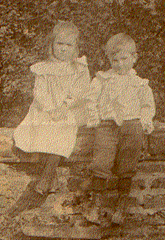
Alfred Farndale (my
grandfather), twelfth child of Martin and Catherine Jane (nee
Lindsay) Farndale and Catherine nee Lindsay (K1), the Tidkinhow Line, in 1902. Alfred later
recalled of his early days: I remember going to school at Charltons near
Tidkinhow. We then went to Standard 1 at Boosbeck. We stayed there until we
were 14. It was a two mile walk each day. The headmaster was Mr Ranson. I
remember Jim, my elder brother catching me fishing and playing truant. He just
said "Get in" (he was in a pony and trap) and he took me to a day’s
marketing at Stokesley. I remember the second masters name was Ackroyd. I got a
fork through my leg and he sucked it out. We were always inspected as we
arrived at school. We had to walk past the Bainbridge place and people used to
say that he had more sheep on the moor than he was allowed. I remember William
looking after me at mother's funeral. I was crying and very upset.
1903

The first flight by Orville Wright made on 17 December 1903
Emmeline Pankhurst founded the Women’s Social and
Political Union in Manchester.
Elizabeth Lindsay (“Lynn”)
Farndale, second child of Martin and Catherine Jane (nee
Lindsay) Farndale (my great grandfather) and Catherine nee Lindsay (K1),
the Tidkinhow Line,
married George Barker of Tancred Grange on 22 August 1903. Just after their
marriage, her mother wrote: Aug 24 1903, My Dear Daughter, I received your
letter and was glad to hear you arrived all right. I hope you and your husband
are enjoying yourselves and that you are having fine weather. It is raining
here today. John will take your luggage and leave it at Darlington tomorrow as
he is going back to Newcastle. I posted all the boxes on Saturday night that
were addressed and I will send the others to you with the cake. I gave the
postman 2/6 this morning and he was very pleased. We have to wish you much joy
& happiness for him. You must write after you get home and let me know if
you get the luggage all right. I now conclude with kind regards to you both. I
remain your affect mother C J Farndale"




Tancred Grange, Scorton, Near Richmond in about 1924,
John Barker, Margaret Barker, Grace Farndale, George Barker The Barkers of Tancred Grange
Lynn Barker (nee Farndale)
1904
By 1904, William Edward Farndale,
son of William Farndale,
a local methodist preacher and later a town missionary in Macclesfield,
Cheshire (K1),
the Whitby 5 Line
entered the Primitive Methodist ministry in 1904
after training at Hartley College.
Primitive
Methodism
The
Primitive Methodists were a major offshoot of the principal stream of Methodism
- the Wesleyan Methodists - in 19th Century Britain. Also known as ‘Ranters’, for their
enthusiastic preaching, ‘Primitive’ Methodists were so called because they
wanted a return to an earlier, purer form of Methodism, as founded by John
Wesley, based on the early church. In 1932 Primitive Methodists joined with
Wesleyan and United Methodists to form the Methodist Church, which continues to
promote faith and justice in contemporary society.

1905

Albert Einstein published is theory of relativity.
Harry Farndale, son of William Farndale, the Carlisle Line,
was a cleaner with the United States Cotton Company in Rhode Island. However he
returned to join the army in the First World War. Harry was Founder of the Stockport 1 Line.
Martin Farndale, third
child of Martin and Catherine Jane (nee
Lindsay) Farndale (my great grandfather) and Catherine nee Lindsay (K1),
the Tidkinhow Line,
emigrated to Alberta, Canada, the first of the family to go. When
he decided to go to Canada, he could not bring himself to tell his mother so he
simply left home and wrote to his sister Lynn from Liverpool: June 16th
1905, Friday morning , Dear Sister, Just a few more lines. I left Liverpool on
Thursday night for Canada on SS Tunisian. I have had a good night's sleep. I
have booked second class on board and is very comfortable. We are passing by
the north of Ireland this [ ]. The ship makes a call here to take on more
passengers. This letter will be sent on from here. I shall not be able to post
any more letters till I land at yond side. I am enjoying the trip well so far. I
hope mother will not fret is she get to know before I write. I will send a
letter to her as soon as we land. I am going to do best . I am going a long way
up the country. I am to Calgary in Alberta. It is chiefly cattle farming there.
There is several more young men on ship that are going out from there can
catch. But I have not meet any lady that is my way yet. You must try and cheer
mother up. There is nothing for her to trouble about. I am as safe here as
riding on the railways in England. I shall be about other 7 days on the water.
I will send a few letters off before I start my land journey. I have not time
write more. I want to up on deck. We are just about to land at Londonderry I
believe. I must leave hoping you are all well. M Farndale." There are
other letters on his webpage.
Martin homesteaded on Trochu town line, but
in 1929 he bought a farm at Paulson and raised cattle. In 1930, he married Ruth Farndale, his
cousin, daughter of Matthew and Mary (nee
Liverseed) Farndale, (K1),
the Craggs Line,
and also from Yorkshire. There is a story that Ruth
travelled to Canada and wouldn’t take ‘no’ for an answer. Ruth had travelled
unaccompanied via Montreal in 1929. They had no children. He became well known
on the Trochu council and took a great deal of interest in education. He did
much for the Trochu community. Martin died, aged 62, in 1943, and is buried at
Trochu. His wife, Ruth, returned to England and lived for many years with her
family. There is a record of her crossing into USA at Buffalo, which may have
been when she returned home. Martin was remembered as an upright, intelligent
man who was very interested in people and very good with children. Ruth later
lived at Harrogate and Ripon and died in Northallerton District.




Martin Farndale – photograph taken in Calgary on 28
August 1908 Martin Farndale in about
1920 The house built by
Martin, where he lived, taken when it was still standing in 1981 Ruth Farndale (nee
Farndale)
1906
Robert Farndale, son
of Robert and Mary Farndale,
the Hartlepool 1
Line was a hotel manager in Hartlepool and married
Ethel Barrett on 25 April 1906.
1907
Midwives and parents were now required to notify the
local health ministry of births, to prevent missed registration.
The Deceased Wife’s Sister’s Marriage Act 1907 allowed
a man to marry his dead wife’s sister.
New Zealand became self-governing within the British
Empire.
William George Farndale,
born on 20 September 1868, was the son of George Farndale (K2) of the Loftus 2 Line. He emigrated to New York on
5 April 1907 and travelled back and forth thereafter. He became an accountant.
He re-married to Rose Cunningham in Iowa, but they had no family.
1908
The London Olympics.
Mass production of the Model T Ford in USA.


Picnic at Kilton Lodge about 1908. Vincent Grainger, Ann and Charles Farndale,
George Farndale, Grace Farndale, ? and Mary or Sophie Farndale Grace Farndale,
daughter of Charles Farndale of
Kilton Hall Farm (K1),
the Kilton 1 Line,
in about 1908.
On 22 September 1908, Robert William Farndale,
son of Matthew
and Ann (nee Readman) Farndale, (K1), the Coatham Line, the foreman at Sand Banks, Coatham
was found hanged in Coatham and there was an Inquest.
In May 1908 John William Farndale,
eldest son of William and Hannah Farndale,
(K1),
the Loftus 3 Line,
moved from Didderholm Farnm in Castleton to the Plough Inn, at Egton, where he
seems to have set up business, selling best spirits and wines and ale, with
aerated waters; stabling; and refreshments and dinner on notice. He seems to
have been a bit of a wheeler dealer, selling a fat pig in 1911, ‘valuable
farming stock; in 1912. He then seems to have moved to Whitby from where he
sold baking powder in 1913 and then Whitebread’s ale, London, Oatmeal and
Invalid Stout in bottle, Combes’ Stingo Ale, nourishing stout, Worthington’s
Mild, beet bitter, special ale on draught, minerals, flour, groceries, fresh
eggs and butter and Slater’s baking powder, which he would deliver. He seems to
have run a beer house in Whitby since in 1912 he sued the previous tenant for
six months licence duty of £1 16s 8d which he had been obliged to pay. By 1915,
he was a pork butcher in Baxtergate, Whitby. By 1921, he was described as a
butcher and huckster.
1909
Lloyd George introduced old age pensions to alleviate
fear of entering the workhouse.
In 1909 James Farndale
(A1),
of the Stockton 3 Line
was a Druid in Stockton. He worked in Stockton in the iron and steam engine
works.
George
V (1910 to 1936)
1910
Start of a survey of land ownership (“Lloyd George’s
Doomsday”) to support the Finance Act.

Kilton Tea Party about 1910 - Mrs Ann
Farndale, Charles Farndale, visiting vicar (The Rev W Slader, O Wardley or W
Nicholson perhaps?), Vincent Grainger (who worked on the farm) and Grace
Farndale


The boys of Tidkinhow
in about 1910 - John, James, Alfred, William, George, Martin (inset) The girl Farndales of Tidkinhow
with Barker children - Willie Barker, Dorothy F, Mary F, Mary B, Kate F, Grace
F, Margaret B, John B - about 1910


Catherine Jane Farndale
(she died in 1911 at Tidkinhow) Martin Farndale
On 1 September 1910, Robert Farndale, eldest
son of, Matthew and Mary (nee
Liverseed) Farndale, (K1),
the Craggs Line
married Sarah Jane Alcock at Ingleby Greenhow. They moved to Wakefield where
Robert was a horseman on a farm. Robert and Sarah Farndale founded the Wakefield 1 Line.
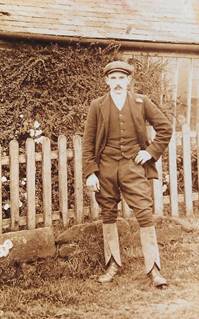
In 1910 John Martin Farndale, son of John and Elizabeth Farndale, (K1), the John Farndale section of the Loftus 2 Line,
who had lived at Loftus and was a grocery store manager at Guisborough
married Bessie Stainthorpe and they went to Newfoundland just
after they were married. John was a grocery store manager in St John’s,
Newfoundland. John and Bessie were founders of the Newfoundland Line.
He later returned to live at 29 Church Street, Guisborough in the
1950s and then went to live near his son at Southampton.

John Martin Farndale,
with his brothers George Farndale, Albert Farndale and William Farndale in
about 1910
1911
The Parliament Act
Population of the UK at 42.1 million.
The National Insurance Act 1911 with some sickness
benefits and access to a doctor.
Unemployment benefits introduced.
Mother’s maiden names added to GRO indexes.
The Society of Genealogists was established.
George Farndale, fourth child of Martin and Catherine Jane (nee Lindsay) Farndale (my great grandfather) and Catherine nee Lindsay (K1), the Tidkinhow Line, went to Canada in 1911, and lived at Three Hills, Alberta. He never married. He is shown on the passenger list of the SS Halifax (Dominion Line) sailing from Liverpool to Halifax on 1 April 1911, with James Farndale who wrote a diary of the journey. George was a tall, broad man of few words, shy and a bit moody. There is a story that before he left home, he was out around the farm at Tidkinhow when they met some poachers. They threatened his father and one went up to George and told him to take his coat off and fight. George said "I don't need my coat off to you". He banged two of them together and they all went off. George took a homestead near Three Hills, not far from Trochu and lived there all his life until he retired, when he went to live in Calgary. He lived alone all his life, remaining reserved and shy. There are many stories about him. Once he came to help his younger brother, Alfred, to drill corn. He arrived and started and then, with the job only half done, he drove himself and the drill home. Something said had annoyed him; so he left. He was known as a very upright and honest man. His bank manager used to say he was one hundred per cent reliable. There is also a story that he cared for a local girl, a nurse, who also liked him. She knew he was shy and tried to help him propose. He thought she was trying to pressurise him, so he never spoke to her again!
![]()
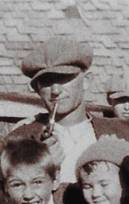
James (“Jim”) Farndale,
sixth child of Martin and Catherine Jane (nee
Lindsay) Farndale (my great grandfather) and Catherine
nee Lindsay (K1), the Tidkinhow Line,
also went to Canada in 1911, the year before the Titanic Sank. There is a transcript of Jim’s diary recording his emigration to Canada. In
1911 James arrived to stay with Martin Farndale. He did not stay long in Canada before he went to America for the
rest of his life.

Arthur Edwin Farndale,
born on 10 May 1875, was the son of George Farndale (K2) of the Loftus 2 Line. By 1911,
he was a clerk at Battersby Railway Junction, working for London North Eastern
Railways. He was later involved with the Skelton Cooperative Society. Arthur
and his wife Elizabeth, retired to Robin Hood’s Bay.
By 1911, Herbert Arthur Farndale (A1), son of William Farndale,
and Mary nee Carter, the Norwich Line,
was a mustard packer in Norwich.
By 1911, Robert Farndale
(A1),
the Ampleforth 1 Line formerly
butler to the Piercy family, was an inmate at the workhouse near Wrexham. But
he seems to have recovered from his ill luck and married Sarah Samuels in 1913 and
they had a large family in the Wrexham and Chester area.
In 1911, William Farndale, son
of Thomas Olijah Farndale Junior,
the Carlisle Line,
was a ‘jobber for anybody’ in Stockport.
In 1911, Ethel Farndale,
daughter of Henry Farndale, the Hartlepool 1
Line was a fish dealer’s assistant in West Hartlepool.
By 1911, Joseph Farndale, son of
William Farndale, (K1), the Kilton 1 Line, who had been a bricklayer
in 1901, was a ‘hind mainly in charge of horses’.
By 1911, George Farndale, second
son of Charles and Ann Farndale
of Kilton Hall Farm (K1),
the Kilton 1 Line
was a partner with his father Charles in the farm at Kilton Hall. There are
extensive records about George on his webpage. By 1939, George was living at
Stank House in Kilton with his sister Grace Farndale. They
both retired to Saltburn in about 1940 when Kilton finally lost its
association with the Farndale family after over three centuries.


A photograph of George Farndale on
horseback at Kilton Lodge (written on the back of the first photograph was:
"Cadbury Bournville, employees 11000, ground space 35 acres, estate 72
acres, gardeners 35, commenced with small grocery store") - the photograph
is marked as taken about 1925, but was probably earlier.
In 1911, Annie Farndale,
daughter of John Farndale, (K1), the Whitby 5 Line the mines deputy at Loftus, was a
dressmaker in Loftus. By 1921, she was living with her Dad in Guisborough, by
then a widower, and keeping house for him.
By 1911, Thomas Farndale, the
son of, Joseph and Mary Farndale,
(K1),
the Great Ayton 2
Line, was a master joiner in Great Ouseburn, having left
Great Ayton to live in York, Leeds, Knaresborough, Harrogate and Great
Ouseburn.
In 1911, Beatrice Farndale,
daughter of William Farndale, (K1), the Richmond Line, was successful in mixed
doubles in Gilling, Richmond.
In 1911, Albert Edward Farndale,
son of John and Elizabeth Farndale,
(K1),
the John Farndale section of the Loftus 2 Line, who had married Rose
Lavinia Hastings in 1919, was manager of the Co-op store in Loftus.
He was associated with the East Cleveland Cooperative Society’s drapery
department for twenty years and was later drapery manager for Skelton
Cooperative Society.
In 1911, William Farndale, son
of Robert and Mary Farndale,
the Hartlepool 1
Line was working in a poultry farm in Darlington.
He had married Elizabeth Shackleton in 1902 and they had four children.
Ethel Margaret Farndale (K1), the Wakefield 1 Line,
was
a shorthand clerk in Leeds in 1911. By 1939 she was a secretary in the machine
trade.
1912
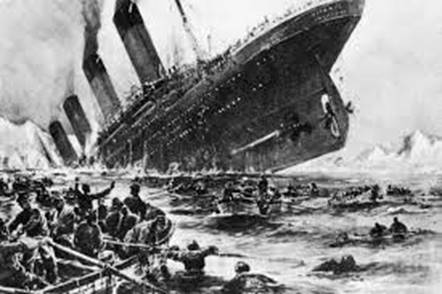
14 April 1912 - the sinking of the Titanic
Scott's Expedition to Antarctica
In 1912, Annie Eliza Farndale, the daughter of John Farndale (A1), the Bishop Wilton Line sailed
for USA on the SS Cymrie, emigrating to
Massachusetts. She travelled with her daughter Hilda Robinson, and lived joined
her husband Frank Robinson, a joiner, there. Frank later became a colour maker
in a paper mill in the City of Chicopee.
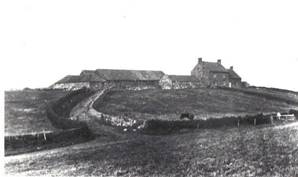
Buck Rush Farm about 1912 (it was part of Kilton Lodge
Farm under Charles Farndale)
On 26 April 1912, George Farndale, son of John George and Elizabeth (nee Sanderson) Farndale,
veteran of the Crimean war, and grandson son of John
Farndale, the author (K1),
the Ontario 1 Line married Elisa Erikson at Victoria, Manitoba. George
became a grain buyer.
1913
Suffragette demonstrations in London
Catherine Jane (“Kate”) Farndale, fifth child of Martin and Catherine Jane (nee Lindsay) Farndale (my great grandfather) and Catherine nee Lindsay (K1), the Tidkinhow Line, followed her brothers to Canada in 1913 and she married William Kinsey in 1913. They lived at Three Hills, Alberta in Alberta, near Trochu where he brothers Martin, George and Alfred and he sister Kate also lived. There is more about the Kinsey family on her webpage.
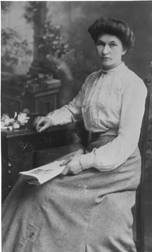

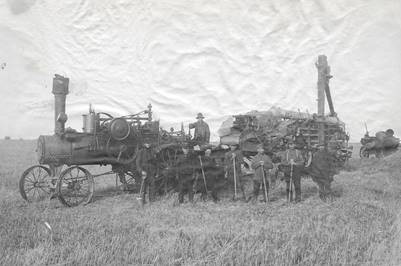
Catherine Jane (“Kate”) Kinsey, nee
Farndale
Bill Kinsey’s threshing set in about 1915 in Alberta, Canada
George Patrick Farndale
(K2), the son of William Leng Farndale (K2), of the Stockton 1 Line
was born on 20 March 1913. He married Mary Freeman in 1941. He was a heavy
worker at roadstone quarries in Northumberland. His descendants are the Northumberland
Line.
William Claude Farndale
(A1), son of William Farndale, and
Mary nee Carter, the Norwich Line, joined the East Anglian
Area Ambulance Company of the Royal Army Medical Corps on 16 September 1913,
aged 17. He served in the Balkans. After the War, he worked in a saw mill in
Norwich and later as a general labourer.
George
William Farndale, son of George
and Mary Farndale, (K1), the Coatham Line,
who had been a road labourer and plumber in Coatham, arrived in USA. He married
Frances Hilton in New York of Chicago in about 1915, but she died from swine
flu in 1918. He saw service in the First World War. He later married Rose
Cunningham in Clinton, Iowa in 1921. He became a naturalised citizen of USA on
16 May 1934. George founded the American 2 Line.
George
was later a teacher in vocational education in Milwaukie, Wisconsin.
Ernest Farndale, son
of Matthew and Mary (nee
Liverseed) Farndale, (K1),
the Craggs Line was
sickly and he died aged only 24 at Craggs Hall.
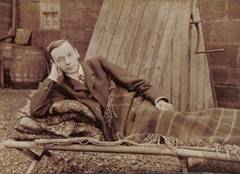
Ernest Farndale of
Craggs Hall
In 1913, John George Farndale, son of Robert and Mary Farndale, (K1), the Hartlepool 1 Line was Treasurer of the Royal Antediluvian Order of
Buffaloes in Hartlepool. He worked as a cement trimmer.
The
Royal Antediluvian Order of Buffaloes (“RAOB”) was one of the largest
fraternal movements in Britain. The order started in 1822 and then spread
around the world. It is known as the "Buffs" to members.
1914
The start of the First World War
The First Battle of Ypres
The Battle of Loos
By 1914 Charles Frederick Farndale,
son of Joseph and Sophia Farndale,
(K1),
the Great Ayton 2
Line, was a
licensed victualler at Bramham, between York and Leeds, having previously been
a farm worker and a clothing shop assistant. He married Gladys Scholes in 1915
in Leeds. Private Charles F Farndale served in the Leicestershire Regiment and
later the 19th London Regiment in the First World War.
On 27 October 1914, Charles Farndale, son
of John George and Elizabeth (nee Sanderson) Farndale,
veteran of the Crimean war, and grandson son of John
Farndale, the author (K1),
the Ontario 1 Line married Mabel Fanny Pugh in Peel, Ontario. Charles
became a farmer there. Charles died in 1928, and his brother Albert Farndale married
his widow, Mabel.

The wedding of Charles Farndale and Mabel Pugh in
Canada in 1914
German
raids on Hartlepool, Whitby and Scarborough
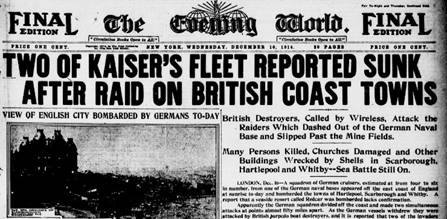
Notice of official changes in name now published in The
London Gazette.
Private William Farndale
(A1),
the Ampleforth 1 Line,
joined the Royal Army Medical Corps and later the Lancashire Volunteers. Later,
he was an agent for Prudential Assurance by 1939.
Private James Farndale,
son of Thomas and Sarah Farndale (A1), the Ampleforth 1 Line, joined the 1st
Devonshire Regiment and later the Wiltshire Regiment in 1914. He served in
Egypt in 1915. I have been told that he worked in animal husbandry in both
World Wars and tended horses in WW1. I am told that his War Service years were
31 August 1914 to 10 March 1919 and then from 1939 to 1941. He married Mary Fairburn and they
had nine children.


Private Charles Farndale,
son of William Farndale, the Carlisle Line,
who had been a ‘doffer’ in Stockport in 1911, joined the 1st Hertfordshire
Regiment.
In April 1914, Florence
Farndale, wife of Rev Dr William
Edward Farndale, (K1), the Whitby 5 Line
was President
of the North Eastern Federation of Suffragettes. She was campaigning for ‘why
women need the vote’.
Private William (“Will”) Jameson
Farndale, son of William Farndale, (K1), the Great Ayton 2 Line,
enlisted into the Royal Army Medical Corps. He may have travelled to USA in
1923, but later returned to the family home of Leeds.
Corporal George William Farndale,
son of Joseph and Sophia Farndale,
(K1),
the Great Ayton 2
Line, later a well known comic actor, a book keeper and pay
clerk, had joined the Royal Amry Ordnance Corps.
Corporal William Farndale,
son of William Appleton Farndale,
(K1)
the Great Ayton 3 Line
enlisted at Stokesley into the Yorkshire Regiment on 12 October 1914 and
arrived in France on 27 August 1915. In a letter home in October 1915, he joked
that since he was in France, he had the Germans on the run. He served in France
and Italy and came home on leave in August 1918. He was 5 feet and 7.5 inches
tall. He was discharged in December 1920 with a 30% disablement from the War.
Albert Edward Farndale,
son of John and Elizabeth Farndale,
(K1),
the John Farndale section of the Loftus 2 Line, was a Gunner in the Royal
Garrison Artillery.
John William Farndale,
son of John William and Louisa nee
Hutchinson Farndale, (K1), the Loftus 3 Line, was an Acting Corporal in
the Lincolnshire Regiment, and later the Labour Corps. By 1939, John was a
locomotive foreman with the London and North Eastern Railway at Rothwell,
Leeds.
Thomas Henry Farndale,
son of Samuel and Pollie nee
Chesters Farndale, (K1),
the London 1 Line
served
in the Royal Navy Reserve in London, working as a telegraphist.
1915
Evacuations from Gallipoli.
First Zeppelin raid on Great Britain.
George William Farndale
was the son of Arthur Edwin Farndale,
(K2)
of the Loftus 2 Line. He
enlisted on 10 December 1915 and became a clerk in the Army Pay Corps at
Blackheath. After the Great War, her was a shipping clerk with George Alder
Limited in Middlesbrough.
Harry Farndale, son of William Farndale, the Carlisle Line,
enlisted into 7th Battalion, the East Lancashire Regiment on 15 February 1915.
He sailed from Plymouth to France on 25 and 26 May 1915 and served in France
and Belgium from May 1915 to July 1916 and from May 1917 to April 1919. A Casualty Form entry
shows him as 577701 Harry Farndale, enlisted 7th Battalion, The East
Lancashire Regiment. The form shows him embarking from Folkstone to Boulogne on
3 May 1917. He was then posted to France and was at Rouen and Etaples. He was
with 225 Company, the Labour Corps, on his discharge. He was transferred to the
Reserve on 5 June 1919. He had enlisted on 15 February 1915, at the age of 19
His mother is listed as Bessie Curley of 467 Broad Street, Central Falls, Rhode
Island, USA. He was wounded in action with shrapnel to his right shoulder in
May 1916 and transferred to England. He was posted to France on 3 May 1917 and
posted to 2nd Battalion, the East Lancashire Regiment. He was later a
painter/railway labourer with 225 Company, the Labour Corps. He served in
France and Belgium between May 1915 to July 1916 and then from May 1917 to
April 1919. He suffered a bullet wound in his left ankle on 1 July 1916. He
later suffered a broken arm when playing football. By 1919 he suffered from
influenza. He has a series of casualty papers describing his conditions. He was
shown as well by May 1919. His conduct card shows a number of entries including
overstaying leave. His last address before joining the army is shown as the
United States Cotton Company at Foundry Street, Central Falls, Rhode Island,
where he was a cleaner. See extensive military records on his webpage. Harry
was Founder of the Stockport 1 Line.
Gunner John Joseph Farndale,
son of William and Mary Farndale
(K1),
the Great Ayton 2
Line, enlisted into the Royal Garrison Artillery on 4
December 1915 and was discharged 14 December 1918. He had married Mary Ingledew
at Great
Ayton on 2 July 1914.

The
Memorial in the Square at Great Ayton to those who served in the First World
War (Photograph taken September 2019)
On
or about 11 August 1915, Herbert Farndale, son of
Matthew and Mary (nee Liverseed) Farndale,
(K1),
the
Craggs Line was enlisted into 2/4th
Battalion, Alexandra, Princess of Wales’s Own (Yorkshire Regiment) and
undertook training.
He was 23, a farmer, 5 feet and 6.5 inches tall and weight 140 lbs, of good
physical development. Later Sergeant Herbert Farndale, 10th Battalion The
Yorkshire Regiment and later the 2nd Battalion the West Yorkshire Regiment, was
awarded the Military Medal for gallantry and the British War Medal and the
Victory Medal. His Military Medal for bravery
arose for service from 11 August 1915 to 30 June 1916 and particularly on 1
July 1916, with the Expeditionary Force in France. He was awarded the Military
Medal for Bravery in the field.
On 1 July 1916, the 10th
Battalion East Yorkshire Regiment was part of the 92nd Infantry Brigade in
support of the 31st Division’s assault on the first day of the Battle of the
Somme. The 10th Battalion had trained at Wareham and was sent to France in July
1915. It saw action in and around the Hooge and Bluff sectors and at Fricourt
on 1 July, suffering enormous casualties on the opening day of the Somme
offensive in 1916. Eleven officers and 299 other ranks were killed in total.
The village of Fricourt lay in a bend in the front line, where it turned
eastwards for 2 mi (3.2 km) before swinging south again to the Somme River. XV
Corps was to avoid a frontal assault and attack either side of the village, to
isolate the defenders. The 20th Brigade of the 7th Division was to capture the
west end of Mametz and swing left, creating a defensive flank along Willow
Stream, facing Fricourt from the south, as the 22nd Brigade waited in the
British front line, ready to exploit a German retirement from the village. The
21st Division advance was to pass north of Fricourt, to reach the north bank of
Willow Stream beyond Fricourt and Fricourt Wood. To protect infantry from
enfilade fire from the village, the triple Tambour mines were blown beneath the
Tambour salient on the western fringe of the village, to raise a lip of earth,
to obscure the view from the village. The 21st Division made some progress and
penetrated to the rear of Fricourt and the 50th Brigade of the 17th (Northern)
Division, held the front line opposite the village. The 10th West Yorkshire
Regiment, was required to advance close by Fricourt and suffered 733
casualties, the worst battalion losses of the day. A company from the 7th Green
Howards made an unplanned attack directly against the village and was annihilated.
Reserve Infantry Regiment 111, opposite the 21st Division, were severely
affected by the bombardment and many dug-outs were blocked by shell explosions.
One company was reduced to 80 men before the British attack and a reinforcement
party failed to get through the British artillery-fire, taking post in Round
Wood, where it was able to repulse the 64th Brigade. The rest of the regimental
reserves were used to block the route to Contalmaison. The loss of Mametz and
the advance of the 21st Division made Fricourt untenable and the garrison was
withdrawn during the night. The 17th Division occupied the village virtually
unopposed early on 2 July and took several prisoners. The 21st Division
suffered 4,256 casualties and the 50th Brigade of the 17th Division 1,155.
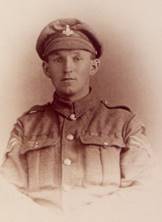
Herbert
Farndale wearing military medal in Green Howards
Herbert Farndale was commissioned in 1918.

Herbert Smith at officer training unit in 1918
In 1915, George Farndale, son of
John and Elizabeth Farndale,
(K1),
the John Farndale section of the Loftus 2 Line, married Nana Mann. George
was a farm worker and an ironstone miner in Loftus and Guisborough
and involved with the Guisborough Quoit and Social Club.
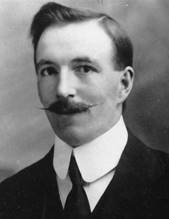
1916
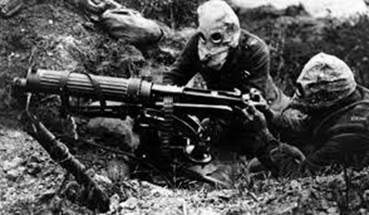
27 January 1916 – The Military Service Act imposed
conscription on all single men aged 18 to 41 with exemptions for medically
unfit, clergymen, teachers and certain industrial classes.
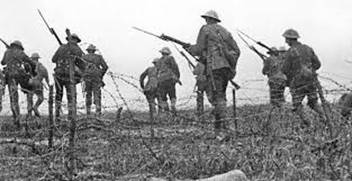
The first Battle of the Somme

The Third Battle of Ypres (Passchendaele).
On 1 March 1916, Private John Farndale,
son of Samuel Saunders and Mary Farndale
(K1),
the Whitby 5 Line
who was born in Egton, a butcher by trade, enlisted into the 385th
(Mechanical Transport) Company, Royal Army Service Corps. There are records of
his service on his webpage. By 1939, he was a master butcher in Lingdale.
In March 1916, Lieutenant Graham Price, a World War 1 Flying Ace, the younger
brother of Florence Farndale, wife of Rev Dr William Edward Farndale,
(K1),
the Whitby 5 Line
was killed in action over the east coast of Scotland in a duel with a German
aeroplane at 8,000 feet.
On 4 June 1916, the brother (it is not clear which
brother) of Driver John William Farndale,
R Battery, Royal Artillery, in France, son of James Farndale and
Elizabeth nee Shepherdson (A1),
the Ampleforth 1
Line, wrote a letter to the Secretary
of State asking for news, as the family had not heard from him for some time.
John was later demobilised in 1920.
On 5 December 1916, Alfred Farndale (my grandfather), twelfth child of Martin and Catherine Jane (nee Lindsay) Farndale
and Catherine nee
Lindsay (K1), the Tidkinhow Line,
enlisted into the Machine Gun Corps. He served in France, Mesopotamia (Iraq)
and India. He served at Ypres. He and Quartermaster Sergeant Zaccarelli had
been galloping up to the Front with an ammunition limber when the Germans
started to shell them. Zaccarelli was killed, along with a horse. Alfred
managed to cut the dead horse free, drag Zaccarelli’s body into a ditch and
carry on up to the Front on one horse with his delivery of ammunition. It amounted
to family legend because there were no witnesses or dates.
Before his formal enlisted he had joined up even though
under age.
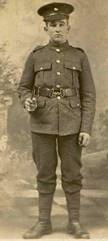
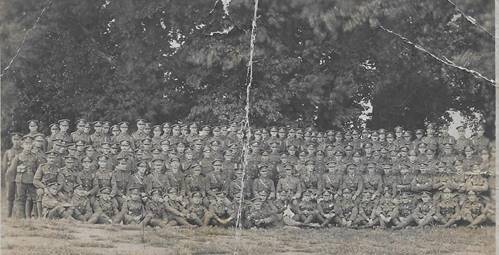

Alfred East Yorks 1914 Machine Gun Corps at Belton Park,
Grantham in 1917 Ypres,
France, 1917 (Alfred centre, rear)
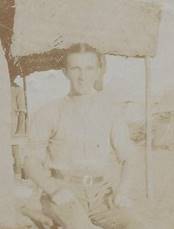

Alfred in
Mesopotamia 1917 to 1918
Alfred
later recalled of his army days: The war came in 1914 and I was just 17. I
wanted to join up so I ran away and joined up at the local recruiting office at
Northallerton, somewhere in South Parade I think. I joined the West Yorks but
my father found out and said I was under age, which I was. The CO wanted me to
stay on the band, but father wouldn't hear of it and I came out. I remember
being very proud of my first leave in uniform. Then one day they called for
volunteers for the Machine-Gun Corps and I stepped forward. We went to Belton
Park, near Grantham for training. I joined 239th Company MGC and we were
attached to the Middlesex Regiment. In 1917 we sailed for Calais and went to
"Dickiebush" Camp. We were first in action at Westbrook and Polygon
Wood. I remember an incident on the Menin Road galloping up with two limbers of
ammunition towards the gun positions at Hooge. I was a Private but I was giving
a lift to Quarter Master Sergeant Zaccarelli. The Germans started to shell us.
They could clearly see us. I had one horse killed and I managed to cut him free
and I then rode the other. Zaccarelli was killed; it was quite a party when I
reported it. My Captain asked if there were any witnesses but there were none,
otherwise I might have got something. I remember an officer coming up to me
when we were under bombardment at Ypres and saying "How would you like to
be in Saltburn now, Farndale?" We saw some action at Zonnebeke,
Ploegstraat and Arras. Then suddenly we were ordered to Marseilles and got on a
troopship for Basra in Mesoptamia. After about 14 days we were in the Suez
Canal and then the Red Sea. We landed at Basra and marched to Kut-el-Amara as
part of a force under General Maud to relieve Townsend. About the middle of
1918 the Turks surrendered. We hung around for quite a while. I cut my thumb on
a bully beef tin and it got poisoned. I was in hospital in Kut when 239th
Company left for England. I eventually got to Mosul where I thought my unit was
and met my platoon commander Lieutenant Pearson. He asked me where I had been
and put me in charge of the officers mess. We had some Punjabi officers at the
time and they used to knock me up to try to get whiskey! Later in 1918 we were
ordered to Bombay. I remember I had to take my stripes down on the troopship.
We were sent up to the Afghan frontier for a while and we had quite a lot of
trouble in the local bazaars. Eventually in early 1919 I think, we got a
troopship to England. We landed at Southampton. I remember we were told that we
could keep our greatcoats or take £1 when we were demobbed on Salisbury Plain.
I took the £1! I remember arriving at Middlesborough station very late at night
and sleeping on the platform. I got the first train next day to Guisborough and
actually arrived at Tidkinhow before they were up! This would be in 1919. I
know that I was clear of the army by the start of 1920. I wish I had stayed in.
I really did like the army life. But I had to come out.
1917
Private (John) Richard Farndale,
son of George and Mary Farndale,
(K1), the Coatham Line,
died at 21st Casualty Clearing Station at La Neuville of pneumonia.
He enlisted at Redcar, and joined the 1/4th (TA) Battalion of the Princess of
Wales’ Own Yorkshire Regiment, also known as the Green Howards. At the time of his death the battalion
was not in the line but in reserve at Proyart. On 31 Dec 1916 it was at
Bazentin le Petit and in reserve at Flers on 7 Jan 1917. On 11 Jan the
battalion moved to the front line ar ‘Hexham Road.’ It was again in the front
line from 30 Jan to 11 Feb at Genercourt. The battalion moved to Proyart on 19
Feb 1917. Richard was awarded the British War Medal and the Victory Medal
posthumously on 21 Jan 1921. He
was presumably badly wounded at Hexham Road or Genercourt or Proyart and
evacuated to No 21 Casualty Clearing Station at La Neuville, where he later
died of pneumonia.
He was buried at La Neuville Communal Cemetery, Corbie,
Somme “3758 Private Richard Farndale, 4th Battalion The Yorkshire Regiment.
Died 26 February aged 19 years. Buried at La Neuville Communal Cemetery,
Corbie. Son of George and Mary Farndale, 6 High Street, Coatham. Memorial:
“Rest in Peace”.”. He is also named on the Coatham Christ Church War Memorial
1914 -1919; Army - Private Richard Farndale.
9 April -16 June 1917: the Arras offensive. Two
members of the family were killed during this battle, and a third, a Canadian,
was wounded.
15/319 Lance Corporal George Weighill Farndale,
the son of Thomas Farndale
and Mary nee Weighill, (A1),
the Bishop Wilton Line, joined
the West Yorkshire Regiment
and was an infantryman in the first world war. He was killed in action at Arras
during the Third Battle of the Scarpe. He had also served in Egypt in 1915. He
is buried at the Arras Memorial, Pas de Calais, France.
The British launched an attack near the Scarpe on 3 May
1917. However, neither prong was able to make any significant advances and the
attack was called off the following day after incurring heavy casualties.
Although this battle was a failure, the British learned important lessons about
the need for close liaison between tanks, infantry and artillery, which they
would use in the Battle of Cambrai, 1917.
Private George Farndale, son of John Farndale,
the mines
deputy in Loftus (K1),
the Whitby 5 Line, was killed
in action on 27 May 1917, during the Battle of Arras, barely one month after
arriving in France. He was serving with the 1st/9th (Territorial Glasgow
Highlanders) Battalion of the Highland Light Infantry in 100th Infantry Brigade
of 33rd Infantry Division in operations against the Hindenburg Line,. He was 26
years old. On his web-page, you will find extensive correspondence and records
about his service and correspondence.
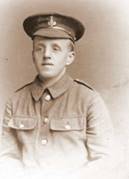
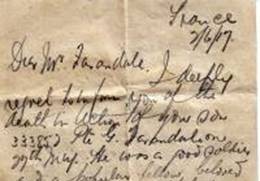
France,
2/6/17
Dear
Mr Farandale
I
deeply regret to inform you of the death in Action of your son 333852 Pte G
Farandale on 27th May. He was a good soldier and a popular fellow, beloved by
us all and our deepest sympathy goes out to you and yours at this time.
Believe
me, Yours truly, D W Greenhulds, 2Lt, 9th HLI.
June
2nd/6/17
Dear
Friend
It
is with deep regret I inform you that your Bro George was killed on the 27th
May. He had just gone into the trenches the previous night and before it was
properly daylight a German trench mortar came over and struck George death
being instantaneous. I have know George for a good long time and he was a fine
pal. He was in the Yorks at Hartlepool when I was, and we were transferred to
2/9th HLI together May 1st/16. It was New Years time when I mist him as he was
sent to Scotland and I was left with Batt. Eventually I came out to France in
Feb and it was there at the base I met him again and we have been together
practically all the time. I was next to him on the 20th/5/17 when we went over
and took the German front line trench, which we held for 2 days and then were
relieved. You have my deepest sympathy in your sad bereavement and hope you
will find consolation in knowing that he died faithfully doing his duty. The
officer got his pay book and pocket wallet which I expect will be sent on to
you.
Yours
Sincerely
R
Sellars
332854
Pte R Sellars 9th H.L.I. Glasgow Highlanders
C.
Company 11 platoon.
B.E.F.
France.
Shingle
Hall, Sawbridgeworth, Herts. Thursday
Dear
Miss Farndale:-
I
am deeply grieved on hearing from you yesterday morning that dear George has been
killed in action, and all at Shingle Hall including myself wish to express our
deepest sympathy with you all in this dark hour of sadness.
It
was an awful blow to me dear, and is one that I shall never forget. He was such
a nice quiet and gentle boy and was very much liked by all who knew him in
Sawbridgeworth, and no fellow could not think so much of a girl as your dear
brother did of me, and had he been spared to come back safely we intended
getting married. I don't know if he ever spoke about it to you.
It
will be awfully kind of you to copy those letters for me and shall be most
pleased to receive them.
Yes
dear, I will see about another doz. p.cs. being copied and will write and let
you know, as I shall be only too pleased to do anything for you, for the sake
of the dear one I have just lost.
He
sent me the Yorkshire badge (as he said no one else should have it but me) also
the cap badge of the H.L.I. and bought me a small regimental brooch of the
H.L.I. so I shall always think of the dear boy.
Now
dear Miss Farndale I will draw to a close trusting you will all accept our
deepest sympathy once more.
With
fondest love hoping to hear from you again soon
I
remain
Your
sincere Friend
Dolly.
The Arras offensive, 1917 (Battle of Arras)
9 April -16 June 1917: the Arras offensive. The British
were called upon to launch an attack in support to a larger French offensive:
the battles of the Chemin des Dames and the hills of Champagne. The opening
Battle of Vimy and the First Battle of the Scarpe were encouraging, but the
offensive, often known as the Battle of Arras, then bogged down into an
attritional slog. Final attempts to outflank the German lines at Bullecourt
proved terribly costly.




The Arras Offensive, 1917
The Battle of Vimy Ridge (part of the Battle of Arras),
9 to 12 April 1917
Prior
to the main battle, William Farndale, ninth child of Martin and Catherine Jane (nee
Lindsay) Farndale (my great grandfather) and Catherine
nee Lindsay (K1), the Tidkinhow Line, served in the Canadian Army in WW1 and was
wounded in action at Vimy Ridge on 13 December 1916. Still weakened from his
wounds, he died of flu epidemic shortly after the War ended. William had
arrived in Canada in 1913, and he went to Early Grey in Saskatchewan where he
was a butcher.
His medical records show:
"Loss of function, right arm ... penetrating gun shot wound at forearm
with compound commimuted fracture of radius ... bullet entered inner surface of
forearm, two inches below elbow, and passed directly through the arm, coming
out on the other side, and splintering the radius in its passage. Severe
inflammation of the arm followed, and inflammation, and sequestrum formed and
was removed. Had erysipilis while in hospital, 23rd CC Station, 24th General
Hospital (British) Etaples from 17 Jan to 23 April 1917, Reading War Hospital
from 23 April to 12 July 1917, MC Hospital Epsom, since 12 July 1917... wounds
all healed. The wound and exit wound shows the remains of a sinus from the
radius not discharging now. Has wrist drop, and is wearing a dorsiflexion
splint. Flexion and extension of elbow are greatly limited and pronation and
supination are absolutely stopped, in a position of partial supination. Is
otherwise normal. (date of report 27 July 1917)".
Alfred, his younger brother,
remembers asking for leave to visit him in hospital in Exeter, but since he was
under orders himself for France, he was not allowed to go. Indeed later William
went on leave to Trochu and Tidkinhow and the family remember questioning him
about France and the fact that Alfred was, by then, in Ypres. He wrote from
hospital, almost certainly in 1917, to his sister Grace: "Left hand of
course, Jan 12, Dear Sister, I will try and write to you. I find I am doing
fairly well but I have got a very bad arm. I was hit with an explosive bullet
which made a hole through two inches wide and broke both bones. They give me
very little hope of my arm being any good but I hope it will not be so bad. I
had an awful hard time in France. I had four operations in two weeks. They
could not get it stopped bleeding and I got so weak that I could not feed
myself. But I am alright now, but not able to get up yet for two weeks or so. I
may have to have another operation. Not sure yet. Going to have my arm x-rayed
shortly. I want you to write a letter for me to Sister Armstrong, 23 CCS, BEF,
France. Give her my address and tell her I am getting along alright. This is
not a very nice hospital, but good doctors. If you send a parcel, send me a
toothbrush and hairbrush. I expect I will be here three months. I tried to get
into Yorkshire so you could come and see me, but this is as far as I could get.
If my arm does not get better it is likely I will get sent back to Canada in
the Spring, but I will never see France any more. I am awful sorry that Alf had
to go. If ever he gets to France I will want to go back again. Your
affectionate brother W.F."
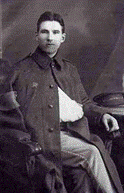


The wounded William Farndale
Private Robert Farndale, son of Robert and Mary Farndale,
(K1)
the Hartlepool 1 Line was
in the King’s Own Yorkshire Light Infantry. He was wounded in 1917 and later
joined the Labour Corps. He was admitted to the Fourth Stationary Hospital and
discharged on 15 April 1918.
Henry Farndale
(K1),
the Wakefield 1 Line,
was a Regimental Quarter Master Sergeant in the Royal Field Artillery who was
gassed in November 1917. Before the War he was a solicitor’s clerk and
engineer’s draughtsman. In 1920 the Army proposed that he transfer to the Corps
of Military Accountants, but he discharged from the army in Woolwich that year.
Lance Corporal Herbert Arthur
Farndale (A1),
son of William Farndale,
and Mary nee Carter, the Norwich Line,
of the Norfolk Yeomanry, the Northamptonshire Regiment and later the Royal
Berkshire Regiment, was wounded in October 1917.

Herbert
Arthur Farndale later in his life

The Russian revolution.
USA joined the First World War.
By 1917 James Arthur Farndale,
the son of John Farndale
and Kate (A1),
the Bishop Wilton Line, was
a drawing foreman at the Saltaire Mills at Shipley now in north Bradford. Due
to the importance of his work, he was excused military duties at consecutive
military tribunal hearings. James became a dominant person in the Saltaire
community. He was later manager of the drawing room until he retired in 1942.
He was a keen cricketer and a life member of the Saltaire cricket club,
voluntarily tending its ground for five seasons. He died in 1952 returning from
a football match.
The Saltaire Mills were a Victorian ‘model
village’ in Shipley to the north of Bradford. The site is now a World Heritage
Site. James Arthur Farndale,
and his descendants (see the Bradford 2 Line) were influential in
its history.
On 25 September 1917, James (“Jim”) Farndale,
sixth child of Martin and Catherine Jane (nee
Lindsay) Farndale (my great grandfather) and Catherine nee Lindsay (K1),
the Tidkinhow Line,
married Edna Adams. Jim and Edna were founders of the American 1 Line.

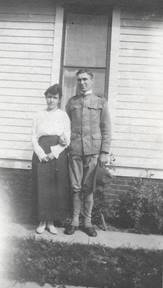
James and Edna after their wedding on 25 September
1917.
James (“Jim”) Farndale
had enlisted into the US Army on 31 August 1917 and he served in France until
1918. He was discharged on 1 August 1919. His younger brother, William Farndale,
had enlisted into the Canadian army. His youngest brother, Alfred Farndale,
had enlisted into the British Army.

James (“Jim”) Farndale in
Plymouth, Indiana in 1917
Edith Farndale,
daughter of William Farndale, (K1), the Richmond Line, died on 25 August 1910,
only 17 days old. She is buried with her wider family at St Agatha Church,
Gilling West.
1918
11 November 1918 - The Armistice.
1918 to 1919 – The ‘Spanish’ Flu killed 228,000.
In May 1918, the King and Queen visited the Saltaire
Mills at Shipley. As Chief Constable of Bradford, the party were met by Joseph Farndale
(K1) and the royal party visited Sir Titus Bart & Sons,
spinners and manufacturers, where James Arthur Farndale,
the son of John Farndale and Kate
(A1),
the Bishop Wilton
Line, was a drawing foreman.
Private W James Farndale,
son of George and Minnie Farndale,
(A1),
the Bishop Wilton
Line and born in Londonderry, Ireland, enlisted in the Army
when he came of age. He was a market gardener and by 1919, had resumed his role
as gardener for the Lane Fox family at Bramham Park.
Gunner John William Farndale (K1),
the Wakefield 1 Line,
was severely wounded by a gas shell explosion and was admitted to a field
hospital in Rouen in 1918 and then to the General Hospital at Leicester. He was
later a leather salesman and founded the Leicester 1 Line.
Albert Farndale,
son of Charles Farndale
of Kilton Hall Farm (K1),
the Kilton 1 Line,
was an architect who tragically shot himself at Kilton in December 1918.
On 29 November 1918 Mark Farndale,
son of John George and Elizabeth (nee
Sanderson) Farndale, veteran of the Crimean war, and
grandson son of John Farndale,
the author (K1),
the Ontario 1 Line, a farmer who had married Mary
Wiltse in 1908,
died on the flu epidemic.
On 26 November 1918, William Farndale, ninth
child of Martin and Catherine Jane (nee
Lindsay) Farndale (my great grandfather) and Catherine nee Lindsay (K1),
the Tidkinhow Line,
weakened from his wounds at Vimy Ridge in 1917, returned to Earl Gray and in
the great flu epidemic of 1918 he drove patients to hospital, caught flu
himself and died. The wording on his memorial situated in Earl Gray says: “Farndale.
28th. In Memory of Pte Wm Farndale, 28th Batt. UEF. Died Nov 26th 1918, aged 25
years. Erected by his fellow Comrades and the citizens of Earl Grey and
district, in grateful recognition of his services to King and Country.”
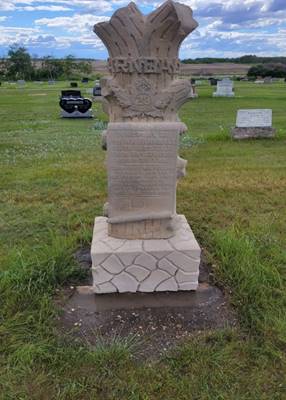
William’s gravestone in 2022 after being restored by B
& B Gravestone Cleaning Services.
Representation of the People Act 1918
In 1918 the Representation of the People Act was passed
which allowed women over the age of 30 who met a property qualification to
vote. Although 8.5 million women met this criteria, it was only about
two-thirds of the total population of women in the UK. The same Act abolished
property and other restrictions for men, and extended the vote to virtually all
men over the age of 21. Additionally, men in the armed forces could vote from
the age of 19. The electorate increased from eight to 21 million, but there was
still huge inequality between women and men.
1919
Soldiers discharged from service after the first world
war.
Britain adopted a 48 hour working week.
The Treaty of Versailles.
By 1919, Joseph Farndale, son of
William and Mary Jane Farndale,
a local methodist preacher and later a town missionary in Macclesfield,
Cheshire (K1),
the Whitby 5 Line
and brother of Rev Dr William Edward Farndale,
was a Temporary Warrant Officer Class 2 in the Army Service Corps. He also
served in the Royal Army Ordnance Corps. He lived at Mobberley in Cheshire, and
there is a book about the Men from Mobberley who served in the Great War.
Before the War he was a clerk. By 1921, he was a manager with the Acid Gas
Company in Newcastle upon Tyne and he eventually settled around Holderness,
Hull.
The
Twenties
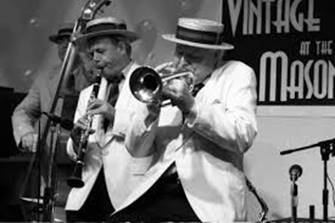
The Roaring Twenties brought about several
novel and highly visible social and cultural trends. These trends, made
possible by sustained economic prosperity, were most visible in major cities
like New York, Chicago, Paris, Berlin and London. "Normalcy" returned to
politics in the wake of hyper-emotional patriotism during World War I, jazz blossomed, and Art Decopeaked. For women, knee-length skirts and dresses
became socially acceptable, as did bobbed hair with a marcel wave. The women who pioneered these trends were
frequently referred to as flappers.
The era saw the large-scale adoption of automobiles,
telephones, motion pictures, radio and household electricity, as well as
unprecedented industrial growth, accelerated consumer demand and aspirations,
and significant changes in lifestyle and culture. The media began to focus on
celebrities, especially sports heroes and movie stars. Large baseball stadiums were built in major U.S. cities, in
addition to palatial cinemas.
Most independent countries passed women's suffrage after 1918, especially as a reward for
women's support of the war effort and endurance of its deaths and hardships

1920
There was a violent attack at the brewery business of William Leng Farndale (K2), of the Stockton 1 Line
where a constable was assaulted in late February 1920.
In 1920, Clara Farndale, daughter of Thomas and Sarah Farndale
(A1), the Ampleforth 1 Line, married Bertie Auton.
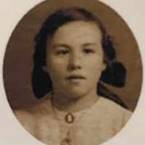
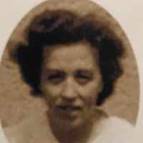
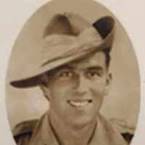
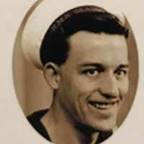
Clara Farndale 1902 to 1961 Olive Auton, 1921 to
1983 Ronald
Auton, 1923 to 1996 Maurice Roy
Auton, 1931 to 2007
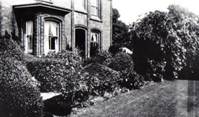
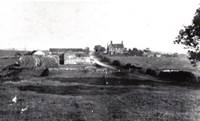
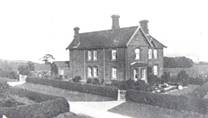
Kilton Lodge Farm in about 1920
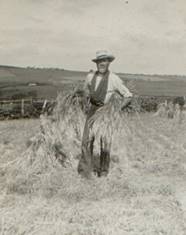
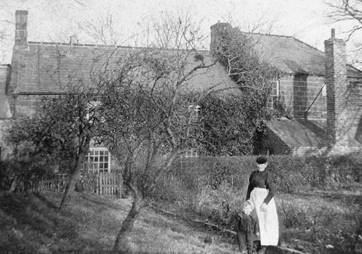
Martin Farndale
harvesting at Tidkinhow about 1920
Mary Ann Farndale in front of Craggs Hall in about 1920

Matthew Farndale, Mary
Ann Farndale, Robert Farndale and Ruth Farndale, in front
of Craggs Hall, about 1920
Mary Ann Farndale,
daughter of Thomas and Isabella Farndale
(K1)
from the Bishop Auckland 1
cousins,
had vivid memories of holidays at Cragg Hall Farm. (she is adamant that she
knew it is Cragg and not Craggs as on your site?) Matthew Farndale
affectionately called Mattha by Mary Ann was an elderly widower by then and he
appeared to enjoy her fussing over him.
Mary Ann remembers a beautiful rose garden hidden at the back of the
farm seen only by those at the farm,
fruit bushes dripping with berries, taking the farmworkers lunches out
to the fields at midday, being allowed to go shopping on her own to Carlin How
or Brotton (an example of the changes in society as she was only 5 or 6 at the
time) and reading Pilgrims Progress in the rarely used ‘front room’ A special treat was to be taken for rides
in the side car of Herbert Farndale’s
motor bike. Herbert, Matthews’ son was
presumably running the farm by this stage. (Recorded from Judith Bremner, Mary
Ann’s great grand daughter)
Annie Maria Farndale,
daughter John George and Elizabeth (nee Sanderson) Farndale,
veteran of the Crimean war, and grand daughter of John
Farndale, the author of Kilton (K1), the Ontario 1 Line, married Thomas Ernest Kirk at
Peel, Ontario and they lived at Huttonville, Ontario and later in Saskatchewan.
In
1920, Mary Frances Farndale,
eighth child of Martin and Catherine Jane (nee
Lindsay) Farndale (my great grandfather) and Catherine nee Lindsay (K1),
the Tidkinhow Line,
married George Brown. Mary had studied confectionary and moved to Horsforth
near Harrogate and Leeds.
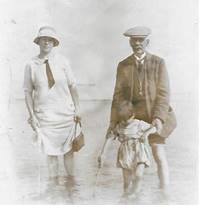
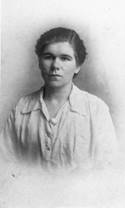
Mary
and George Brown, with their daughter, Ena, at Saltburn in about 1927. Mary Frances Farndale.
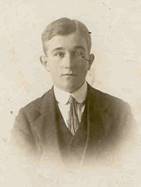
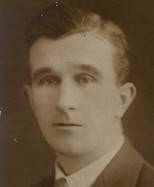
Alfred Farndale (my
grandfather), twelfth child of Martin and Catherine Jane (nee
Lindsay) Farndale and Catherine nee Lindsay (K1), the Tidkinhow Line, in about 1920
In the twenties, Frank Farndale, son of Samuel and Pollie nee
Chesters Farndale, (K1),
the London 1 Line
was
an all round sportsman playing football for Brookside Athletic Reserves and
cricket and later bowls.
1921
Population of the United Kingdom reaches 44 million.
By 1921, William James Farndale
(born in Stockton in 1882) and son of Thomas William Farndale
(K2) of the Stockton 2 Line
was a costing clerk at the Skinningrove Iron Co Ltd. He was later President of
the Liberals Association in Redcar.
By 1921, Edith Annie Farndale
and May Farndale, daughters
of William Farndale, and
Martha Farndale (A1),
the Bishop Wilton
Line were clerk and bookkeeper at Braddford Corporation’s
Infant’s clinic.
By 1921, John W Farndale,
son of William Farndale
and Mary nee Leppington, (A1),
the Bishop Wilton Line was
a gardener for Lord Allerton at the Firs, Wetherby. His daughter with his first
wife Annie Thomspon, Lily Farndale
had been tragically killed when playing ball in 1933. His second wife Jane Wade aroused the neighbourhood
when there was a fire at the village smithy at Walton in 1952. John is the
Founder of the Wetherby 1 Line.
By 1921, Gladys Farndale (A1) aged 13, was a cotton weaver at the commercial mill
in Great Harwood, Lancashire.
In 1921, William Robert Farndale,
son of William and Elizabeth nee
Shackleton Farndale, the Hartlepool 1 Line,
was an oiler with the North Eastern Railway Company at Bank Top Railway
Station, Darlington.
On 6 December 1921, James Neville Farndale (A1),
the Ampleforth 1 Line,
an iron moulder, travelled with his wife Cecelia nee
Bingham to Melbourne, Australia on the Iberia where they
settled.
By 1921, Robert William Farndale,
son of Thomas and Sarah Farndale
(A1), the Ampleforth 1 Line, was a foundry worker in
Middlesbrough, later moving to Thornaby.
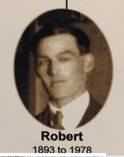
In 1921 Margaret Gwendoline Farndale,
daughter of John William Farndale MRCS Eng,
LRCP Lond, and granddaughter of Joseph Farndale the Older,
the Chief Constable of Birmingham (K1),
the Whitby 5 Line
was
a bank clerk with the London, Joint City and Midland Bank, working in
Willesdon.
In the early 1920s, Ethel Chesters Farndale,
daughter of Samuel and Pollie nee
Chesters Farndale, (K1),
the London 1 Line
was
a clerk in the civil service at the Admiralty.
By 1921, Thomas William Farndale,
son of Samuel Saunders and Mary Farndale
(K1),
the Whitby 5 Line
of Egton, who had been a blast furnace worker in Loftus in 1901, an ironstone
miner (ratchet) in 1911, was the ‘lights on man’ for Loftus urban district
council. By 1939, he was a local authority cartman.
In 1921, Elizabeth Shaw (nee
Farndale), daughter of John and Elizabeth Farndale,
(K1),
the John Farndale section of the Loftus 2 Line, was living in Loftus
with her husband, Robert Shaw, a coal cartman from Manchester.
In 1921, John Armin Farndale,
son of Henry Farndale, the Hartlepool 1 Line
was
a coggie tram driver on plate rolling milks with the South Durham Steel and
Iron Company in Hartlepool. He married Charlotte Georgeson in 1932 in
Bradford and they moved to South Shields
where they founded the South Shields 1 Line.
By 1921, George William Farndale, son of Joseph and Sophia Farndale, (K1), the Great Ayton 2 Line, who
became a well known comic actor, started to be involved in drama. There are
extensive records of his accomplishments on his web page. He regularly
performed with the Yorkshire Mummers and sang comic songs.

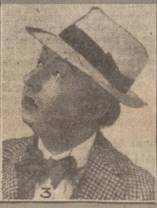
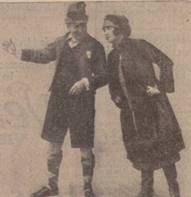
In 1921, Grace Farndale,
tenth child of Martin and Catherine Jane (nee Lindsay) Farndale (my great grandfather) and Catherine nee Lindsay (K1), the Tidkinhow Line, was assistant matron at the Towers
Boarding School for Girls at Saltburn by the
Sea.
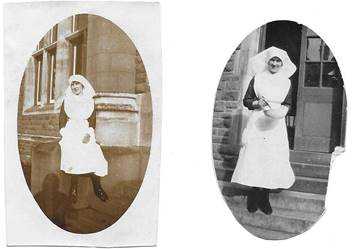
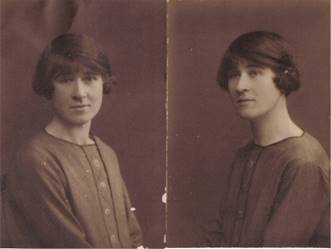
Grace at Malvern in the 1920s
Grace about 1920
William Farndale, son of
Matthew and Mary (nee Liverseed)
Farndale, (K1), the Craggs Line married
Mary Coverdale at Danby in Cleveland on 9 December 1916 and in 1921, they moved
to Plane Tree Farm at Maunby, Thirsk where William and Mary farmed for forty
years. They were founders of the Thirsk Line.
William chaired the Northallerton Branch of the National Farmers Union and had
an active role in negotiations during the Second World War to get the most from
the land.
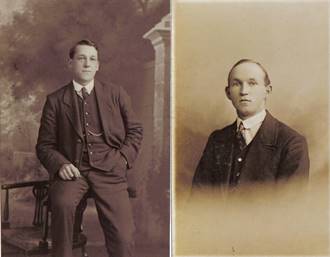
William Farndale in
about 1920 and about 1930.
By 1921, William Farndale,
son
of John and Elizabeth Farndale,
(K1),
the John Farndale section of the Loftus 2 Line,
had married Cecelia Harding and was living at Moorsholm.
He was an ironstone miner at Sir Bernard Samuelson’s
Spawood mine. By 1947, his family lived at Freebrough Farm, Moorsholm where he
farmed.
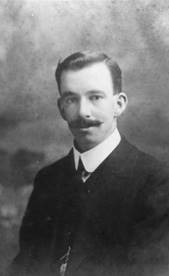
By 1921, Henry Farndale, son
of Robert and Mary Farndale,
the Hartlepool 1
Line was an able seamen in the merchant navy with the Eagle
Oil Transport Company. He had also worked as a barman. He had married Elizabeth
Armin in 1892 and they had eleven children.
In 1921, Josephine Salvatori Farndale,
daughter of John William and Louisa nee
Hutchinson Farndale, (K1), the Loftus 3 Line, was a dressmaker with
Marshall and Marshall at the shop on the pier in Whitby.
1922
Irish Free State gains independence from the
United Kingdom in 1922.
The Union of Soviet Socialist
Republics (Soviet Union) is created in 1922.
Inauguration of the British Broadcasting Corporation (“BBC”).
First public radio broadcasts.
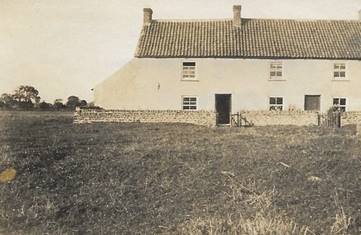
The cottages
at Scorton where Grace Farndale, tenth
child of Martin and Catherine Jane (nee
Lindsay) Farndale (my great grandfather) and Catherine nee Lindsay (K1),
the Tidkinhow Line,
and Margaret Baker who
later married Grace’s brother, Alfred Farndale, had a
poultry farm in 1922
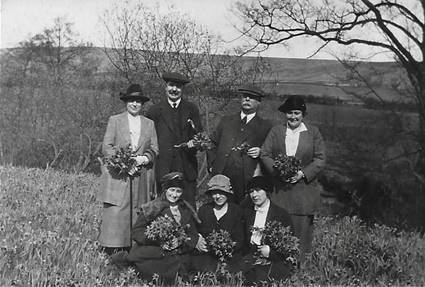
Dorothy Farndale
(centre front) and Grace Farndale (right front) at Farndale in
about 1922
1923
The English Place Name Society was founded.
On 6 January 1923, Sarah Elizabeth Farndale, daughter of Thomas and Sarah Farndale
(A1), the Ampleforth 1 Line, married William Craggs.
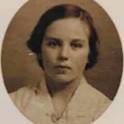
Sarah Elizabeth Farndale,
later Craggs
By 1923, Harry Farndale, son of William Farndale, the Carlisle Line,
was a keen and regular footballer, playing for Stockport FA. Harry was Founder
of the Stockport 1 Line.
1924
On 9 May 1924 Charles Farndale (A1), the Ampleforth 1 Line,
a groom, enlisted into the Royal Tank Corps at Winchester and served with the
13th/18th Hussars and 15th/19th
Hussars in 1924 and 1925.
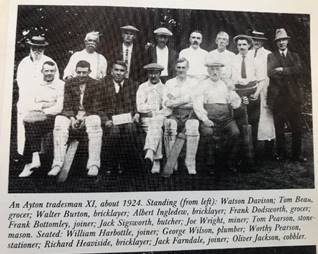

John Joseph Farndale,
son of William and Mary Farndale
(K1),
the Great Ayton 2 Line,
a joiner and part of the Ayton cricket team, front
row second from right, with probably his brother in law Albert Ingledew at the
back.
Ellen Farndale,
daughter of George and Mary Farndale,
(K1), the Coatham Line,
married Baden Powell Chapman in Guisborough in 1924.
1925
Demonstration of the television by James Logie Baird.
By 1925, Wilfred Farndale, the son of James Arthur Farndale
and Florence Edith nee Greenwood(A1),
the Bishop Wilton
Line, was a cricketer for the Shipley side. He had an
outstanding cricketing career which you can read about on his webpage.
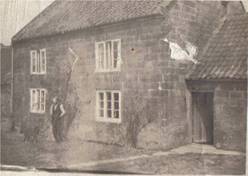
Martin
at Tidkinhow
Farm about 1925
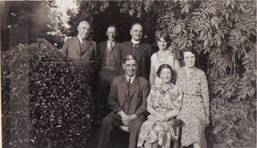
A
photograph of Grace Farndale (sitting), daughter of Charles Farndale of Kilton Hall Farm (K1), the Kilton 1 Line,
in about 1925. Grace lived at Kilton with her father and
later her brother George Farndale until
they both retired to Saltburn in about 1940.
In
April 1925, George Farndale, son of
Richard Farndale, (K1), the Great Ayton 2 Line
(formerly a millwright in Great Ayton and then a mechanic millwright
in Kent) then aged 71, was found dead at his home overcome by gas in Burton on
Trent.
1926

The General Strike of 1926
The Births and Deaths registration Act 1926.
The Legitimacy Act 1926.
In April 1926, Bessie Farndale,
daughter of William Farndale, (K1), the John Farndale section of the Loftus 2 Line,
was ten years old and attending Margrove Park Council School, in Standard IV.
She was fond of reading and had a black and white cat. By 1939, she was a cook.
1927
Kenneth Farndale (K2), the son of William Leng Farndale,
of the Stockton 1 Line
travelled to Canada under the immigration and colonisation scheme of the time,
but later returned.
Mary Elizabeth Farndale,
daughter of of Charles Farndale of Kilton Hall Farm (K1), the Kilton 1 Line
married William Hodge with a reception at Kilton Lodge.
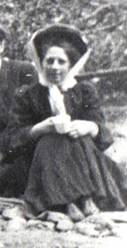
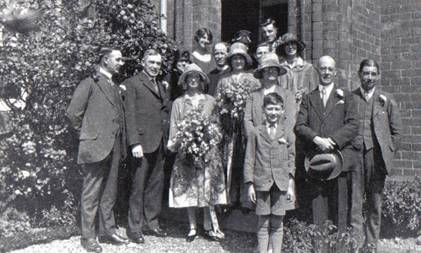
Believed to be Mary Elizabeth Farndale
in about 1908 (it could be Sophie Farndale) It
is believed that this is a photograph of Mary Farndale's wedding at Kilton
Lodge in 1927.
In 1927, Hannah Mary Farndale,
daughter of John and Elizabeth Farndale,
(K1),
the John Farndale section of the Loftus 2 Line, married Herbert Richardson
at Bedale Church and they lived at Canbara House, Romanby, Northallerton,
and later, for a time, in Sheffield.
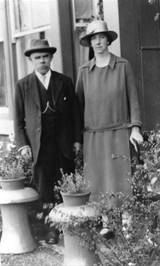
John Farndale, with his
daughter Hannah Mary Farndale
1928
Women over 21 years old received the right to vote.
The discovery of penicillin by Alexander Fleming
leading to the antibiotics revolution.
Martin Farndale (my
great grandfather) (K1),
the Kilton 1 Line
died on 17 January 1928 and is buried at St Aidan, Boosbeck.
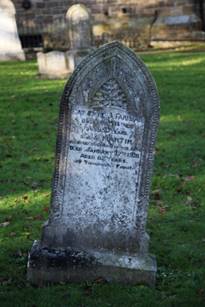
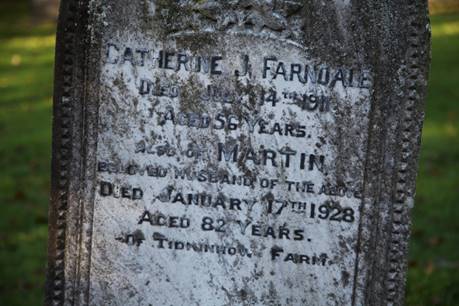
John Farndale, eldest
son of Martin Farndale (my
great grandfather) and Catherine nee Lindsay (K1), the Tidkinhow Line, married Elsie Hammond in
Ripon in 1928. They had no children. In
January 1928, John took over Tidkinhow Farm when his father died. He
farmed there until he retired in the 1960s. His wife, Elsie, became ill soon
after they moved to 14 Walton Terrace at Guisborough. She died
shortly afterwards. John lived at Guisborough and was
looked after by relatives. He spent his last few years in a cottage near
Stapleton where he was nearer to relatives, particularly Margaret Shields,
eldest daughter of his sister Lynn. He died aged 94 in 1971 and was cremated in
Darlington
crematorium. His wife, Elsie, had been cremated at Stockton crematorium.
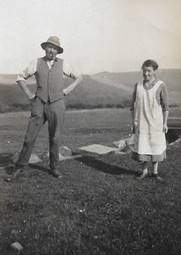
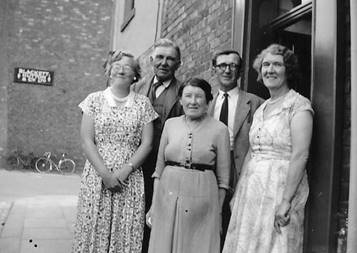
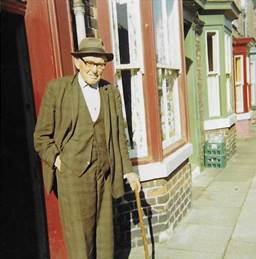
John and Elsie at Tidkinhow
in about 1937 John’s
house in Guisborough in about 1960, with his niece Margot, John, Elsie, brother
Alfred and sister Dorothy
John Farndale in 1967, the last Farndale of Tidkinhow
In March 1928, Dorothy Annie Farndale,
eleventh
child of Martin and Catherine Jane (nee
Lindsay) Farndale (my great grandfather) and Catherine nee Lindsay (K1),
the Tidkinhow Line,
married
Alfred Ross in Guisborough. They lived at Green Farm at Skelton Green. Alfred
died in the 60s, and Dorothy married Robert Drake in 1970 and after he died,
she lived with her sister Grace in Leyburn.
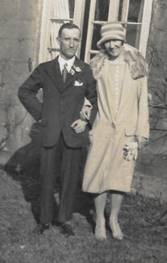
Wedding of Alfred Ross and
Dorothy Farndale in March 1928
On 16 March 1928, Alfred Farndale (my
grandfather), twelfth child of Martin and Catherine Jane (nee
Lindsay) Farndale and Catherine nee Lindsay (K1), the Tidkinhow Line, married Margaret Louisa (“Peggy”) Baker
(my grandmother) at Bedale Church. They immediately embarked from Liverpool to
sail to Canada, to join Alfred’s brothers and sisters in Alberta.
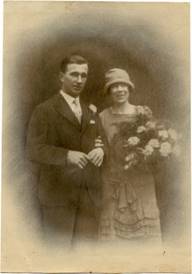
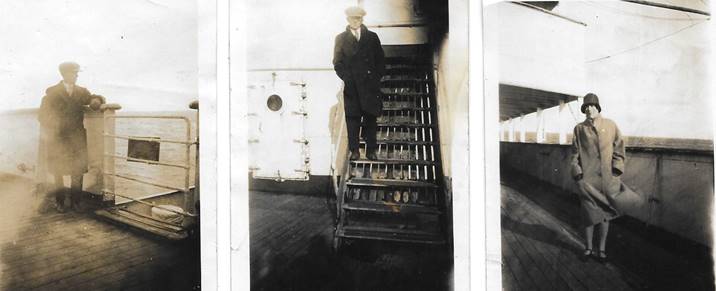
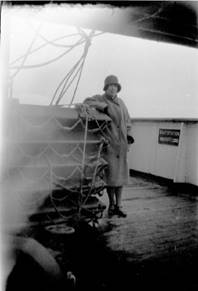
Alfred and Peggy after their
wedding The voyage to Canada
They
settled at Huxley and Alfred built their house there:
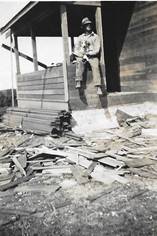
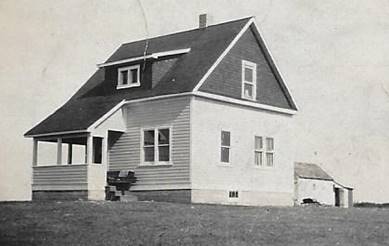

Alfred
building the Farndale House on arrival in Alberta The House that Alfred Built
The house still standing in about 1973
Alfred
later recalled: I married your mother
on 16 March 1928 at Bedale Parish Church. Martin was over from Canada and he
was best man. It was just after my father died in January 1928. My eldest
brother, John took over Tidkinhow. Peggy and I had already decided to join the
'Canadians' [his brothers Jim, Martin and George and his sister Kate] in
Alberta. We went to Huxley and rented a section of the CPR and you three
children were born. However we had bad luck with crops and the slump and we had
to go back to England in 1935.
1929
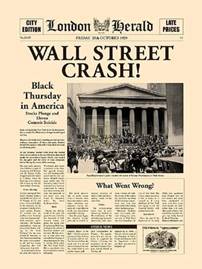
The Local Government Act 1929 abolished workhouses
(though many were renamed Public Assistance Institutions and continued under
local council control).
By 1929, Florence Farndale, wife of Rev Dr William Edward Farndale,
(K1),
the Whitby 5 Line
was very involved with the British Women’s Total
Abstinence Union (“BWTA”).
On 27 April 1929 Albert Farndale, son of John George and Elizabeth (nee Sanderson) Farndale,
veteran of the Crimean war, and grandson son of John
Farndale, the author (K1),
the Ontario 1 Line married Mabel Fanny Pugh in Peel, Ontario, the widow of
his brother Charles Farndale.
The
Thirties
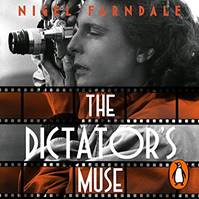
Nigel
Farndale has written about this period in the
Dictator’s Muse.
1930
One fifth of the British male population was employed.
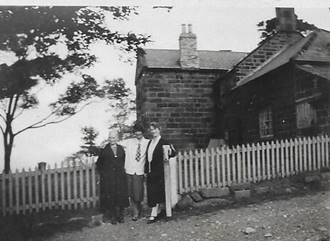
Possibly Polly Farndale,
daughter of Thomas William and Christie Ann (nee
Dixon) Farndale (K1),
the Whitby 5 Line,
with Ruth Farndale (K1), the Craggs Line, and Dorothy Farndale (K1), the Tidkinhow Line, at Craggs Hall in about
1930.
Arthur William Farndale
and Richard (“Dick”) Farndale,
sons of George William and Frances nee
Hilton Farndale, (K1), the American 2 Line
were raised in Prophestown, Illinois until about 1930 and then Arthur moved to
Milwaukie, Wisconsin. Arthur worked with
heavy machinery in Milwaukie. Dick married Marion Johnson in 1946. Marion
worked for many years as a secretary for the former Eclipse Lawnmower Co. in
Prophetstown. She then worked for the former Penberthy Co. in Prophetstown, as
well as a bookkeeper for her husband's business, Richards Texaco. She was a
longtime member of the First Congregational United Church of Christ of
Prophetstown, and also the Prophetstown Country Club. She loved to travel and
golf. She enjoyed shopping, and in her earlier years, bowling. Marion was an
avid reader and belonged to a book club. She was very active in various social
circles, always in touch with her family and friends, volunteering for many
years at the church and nursing home. Most recently, she was helping serve for
Pat's table. Dick owned and operated Dick’s Service Station,
Prophetstown for many years, retiring in 1987. He served in the Army during
World War II, spending more than four years in the Pacific theatre of
Operation.
Joseph Farndale CBE
KPM, son of Thomas and Sarah nee Bell
Farndale, (K1),
the Wakefield 1 Line
and nephew of Joseph Farndale the Elder,
the Chief Constable of Birmingham, following his thirty year term as Chief
Constable of Bradford City Police Force, became a Traffic Commissioner for
Yorkshire (1930 to 1938).
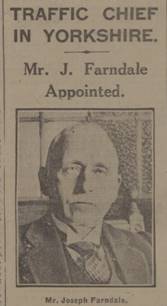
1931
Population of UK reaches 46 million.
26 April 1931, the National Census, but all records for
England and Wales were destroyed in a fire at Hayes in Middlesex.
Westminster recognised the independence of Canada
Australia, the Irish Free State, New Zealand, South Africa and Newfoundland.
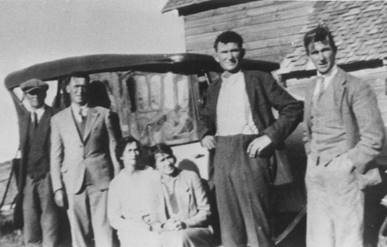
The Canadian Farndales at the Kinseys in about 1931, Martin Farndale, Jim Farndale, Kate Kinsey nee Farndale,
Grace Farndale (later Holmes),
George Farndale, Alfred Farndale.
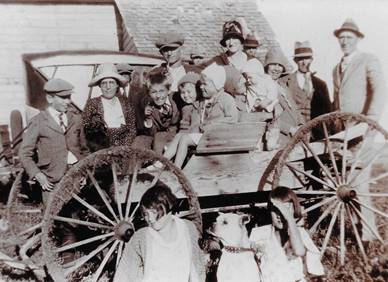
The Kinseys and Farndales in about 1931, back row: Martin Farndale, George Farndale, Ruth Farndale, Will
Kinsey, Alfred Farndale, Jim Farndale, middle
row: Alfred Kinsey, Edna Farndale, Jimmy Farndale, Martin Farndale, Grace Farndale (later Holmes),
Front row: Dorothy Kinsey, Janie Farndale. (Mary
Farndale, Anne Farndale)
Of life on the Prairie, Martin Farndale (my father), son of Alfred Farndale (my grandfather), and Margaret Louisa (“Peggy”) nee Baker
Farndale (K1),
the Wensleydale Line,
wrote: I was born eldest son to Alfred and Margaret
Louise Farndale (nee Baker) on 6 January 1929 at Trochu, Alberta, Canada.
Trochu is about 100 miles north north east of Calgary and 20 miles south south
east of Red Deer. Alfred and Margaret (always known as Peggy) were married at
Bedale Church, Yorkshire on 16 March 1928 and had moved directly to Canada
where Alfred’s older brothers, Martin and George were already living together
with an older sister, Kate. Two other brothers had also been in Canada – James
who had moved to USA in 1913 and William who died of influenza in Winnipeg in
1919. Alfred was soon joined by his sister Grace, who later married Howard
Holmes. Alfred rented a section and a half near Huxley some 10
miles north of Trochu and built a house there. The farm was almost entirely
devoted to wheat but with some cattle. I grew up at the farm and my first
memories are of playing on the prairie and around the slews (a kind of duck
pond) near the farm. I remember all the horses used for farm work, the box
waggons with racks, threshing in the fields and the hot summers. The winters
were cold - well below zero, and I remember the horse drawn sleighs and the
bright sun on the snow. I remember the village of Huxley, the annual sports
day, the Legion parade and buying sweets at Miss Hibbs’ store. I remember
visits to the neighbours, the Hoggs, the Saggers, the Morris’, the Wagstaffs,
the Millers and I remember the postman, Mr Hibbs whistling in his buggy as he
came up the road to what is still today called Farndale’s corner. But above all
I remember the family. Uncle Martin and Aunt Ruth lived near Trochu and he
spoiled me a lot. Uncle George was a bachelor, remote and living alone near
Three Hills. Aunt Kate was strict and austere, but kind and she lived between
Trochu and Three Hills with her husband Bill Kinsey and their children George,
Alfred and Dorothy. I remember evening parties and sitting waiting while the
grown ups played bridge. I remember being well looked after by our nannie,
Gladys Grist who later married Aubrey, the son of our nearest neighbour, Ralph
Hogg. There was a visit by mother’s sister, Aunt Hilda from England and we all
(by this time my sister Marianne Catherine Farndale and brother Alfred Geoffrey
Farndale had been born on 30 October 1930 and 10 April 1932 respectively) went
to Banff and on through the Rockies by train to Vancouver and Victoria Island
where we looked over the new liner, the Empress of Japan. On another occasion
we stayed at the Palliser Hotel in Calgary and went up in a lift for the first
time and we visited the Calgary Stampede. I was playing with Meccano one
afternoon at the farm when a bunch of Indians rode right up to the door in
search of work. I also remember Uncle Jim and Aunt Edna with their family Hazel
Jae, Jimmy, Mary, Doris and Gordon, visiting from USA. I can remember their
arrival in a large open car with luggage tied all around it. Sergeant
Hammond of the Royal North West Mounted Police often visited the farm. One
event I can remember clearly was when my father promised to take me the 5 miles
or so to the other half section – the Wickizer Place – to see the horses.
Towards evening I was playing around the threshing set at the farm when I saw a
Chevrolet car like the one my father owned drive past the red gate at the
entrance to the farm and was convinced that I had been left behind. I therefore
set off to walk. I was about 6 years old and the corn was high and it was
getting dark. There was consternation when I could not be found later on, for
once into the corn I would be very difficult to find. Search parties were
called out from neighbours and from Huxley but apparently I had got into a
ditch beside the road and could not be seen. However the ditch took me to
Huxley and though I can remember nothing about my 3 mile walk, I do remember
being picked up by two men who worked in the Huxley garage and being taken home
to a mixture of relief and scolding. I remember my sister Anne
falling down the cellar steps, and, on another occasion, while visiting Aunt
Grace and Uncle Howard, throwing his best spanner down his well. I also
remember learning to ride our horse, Chubb and I remember our Colley dog, Scot,
who slept beside my bed.
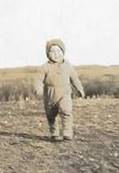
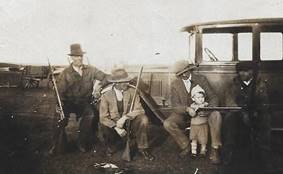
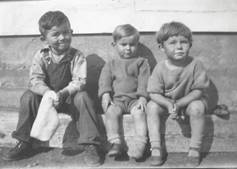
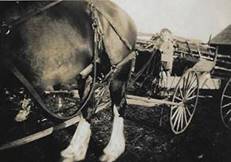
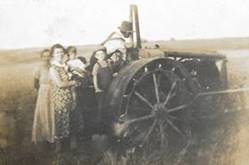
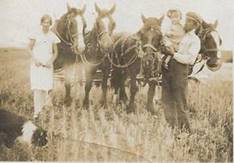
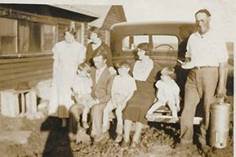
Life on the Prairie
By 1932, , James (“Jim”) Farndale,
sixth child of Martin and Catherine Jane (nee
Lindsay) Farndale (my great grandfather) and Catherine nee Lindsay (K1),
the American 1 Line
was a finish carpenter and had become a Business Agent for thbe Carpenter’s
Union, working on the Boulder Dam project.
In 1931, Joseph Farndale, a
painter, son of John Willie Farndale, (K1), the South Shields 2 Line
married Margaret Lakin in Hammersmith and founded the London 4 Line.
1933
Lily Farndale, daughter
of John W Farndale, and
Anne nee Thompson (A1),
the Bishop Wilton
Line, a domestic servant of the Saffer family at Moortown,
was tragically killed in an accident when a ball thrown by the six year old son
of the family caused her to over balance onto a fire.
In 1933, Rev William Edward Farndale, son of William Farndale, (K1), the Whitby 5 Line
was appointed District Missionary and Chairman of the
Lincoln and Grimsby District, a task which occupied the remaining nineteen
years of his active ministry.
1934
By 1934, Wilfred
Farndale, the son of James
Arthur Farndale and Florence Edith nee
Greenwood(A1),
the Bishop Wilton Line, was the Sanitary Inspector for Shipley.
Quiet and unassuming, and a successful cricketer in the Shipley team, he was a
very popular member of the community. He gave lectures and wrote about his
work, which is all recorded on his webpage. He was also elected President of
the Shipley Branch of the National and Local Government Association (“NALGO”)
and President of the Shipley Rotary Club. He married Kathleen Dawson. Wilfred
is the Founder of the Bradford 2 Line.
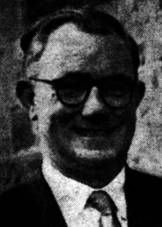
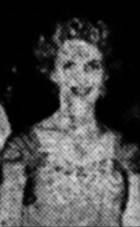
Wilfred Farndale Kathleen Farndale
On 3 April 1934, Grace Farndale, tenth child of Martin and Catherine Jane (nee Lindsay) Farndale
(my great grandfather) and Catherine nee Lindsay (K1), the Tidkinhow Line,
married Howard
Holmes in Calgary.

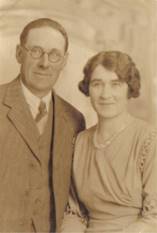
Wedding
of Grace Farndale and Howard Holmes in Calgary in 1934, back row: Kate Kinsey,
Peggy Farndale, Grace Farndale, Howard Holmes, Dorothy Kinsey, Alfred Farndale; front row: Anne
Farndale, Geoffrey
Farndale, Martin
Farndale
Howard
and Grace had a ranch in Alberta.
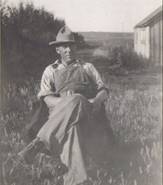
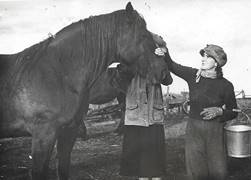
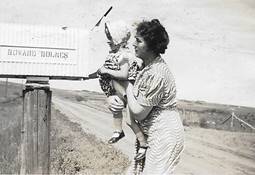
Grace’s
diary recalls her emigration to Canada with some details of life at Tidkinhow.
On
11 August 1934 Robert George Farndale,
son of Henry and Elizabeth nee
Armin Farndale, the Hartlepool 1 Line,
a French polisher, married Winifred Sibley at St Augustine, Bradford. He
enjoyed table tennis and dominoes. He founded the Bradford 1 Line.
1935
After the Great Depression, Alfred Farndale (my grandfather), twelfth child of Martin and Catherine Jane (nee Lindsay) Farndale
and Catherine nee
Lindsay (K1), the Tidkinhow Line,
Margaret Louisa (“Peggy”) Baker
and family returned to Yorkshire from Alberta. As Martin Farndale
later wrote: things were not well on the farm.
Prices were bad in the slump years of the early 30s and the weather was unkind
so that my father, along with many others, soon lost all his savings, and in
1935, he decided to return to England. I remember well the excitement of the
farm sale by our white house with a black roof, on the hill overlooking Huxley.
It was early April and it was cold with snow still on the ground. We spent our
last few days in Alberta with Aunt Grace and Uncle Howard at their Ranch near
Huxley and finally caught the train at Huxley for Edmonton on 9 April 1935. At
Edmonton we changed onto a CNR train for the four day journey to Montreal. I
remember my brother Geoffrey having his third birthday on the train and having
a cake. I remember the train, and the porter turning the seats and the roof
rack into beds at night and the small carriage at the end of each carriage for
cooking. I remember the observation car and passing endless forests and lakes
as we crossed Canada. We changed trains at Montreal to a train entirely staffed
by French speakers for the two day trip to Halifax where I can remember my
father saying, as we boarded the ship, that we had now come half way! The
voyage across the Atlantic was on the Duchess of Bedford. We sailed on about 17
April 1935. The weather was cold and foggy and we saw icebergs through the fog.
Later across the Atlantic it was pretty rough and I was sea sick until I was
taken on a walk around the deck by my father. I can recall the meals and the
huge excitement of the voyage. I saw the north of Ireland and we sailed into
Liverpool on about 23 April 1935. There at the quayside we were met by mother’s
brother, Geoffrey Baker and her sister, Hilda Baker. We were taken to stay with
cousins at Conway in North Wales while my father went off to Yorkshire to sort
out our future back in England.
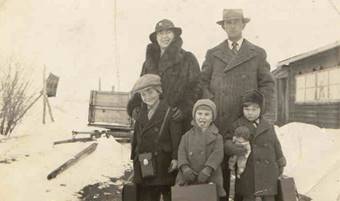
The return from Canada
1936
King
Edward VIII, January to December 1936
The
Abdication
George
VI, 1936 to 1952
The Spanish Civil War
The Battle of Cable Street, London
A series of clashes that took place at several
locations in the inner East End, most notably Cable Street, on Sunday 4 October
1936 related to a march by the British Union of Fascists.
In 1936 , James (“Jim”) Farndale,
sixth child of Martin and Catherine Jane (nee
Lindsay) Farndale (my great grandfather) and Catherine nee Lindsay (K1),
the American 1 Line
was elected to the Nevada State Assembly. This now gave him a very full life
where at last he could exercise his ability and knowledge, even though he was
still troubled by ill health. After a four year period, he was re-elected for a
second term, in 1940; a great honour and he was by then a recognised leader of
Nevada State. In 1942, he was elected to serve in the Nevada State Senate and
was to complete a four year term, until 1946.
Between 5 and 31 October 1936, John William Farndale, son of John Willie Farndale, (K1), the
South Shields 2 Line was the youngest member of the 185 men
who set off on the Jarrow marches. See his webpage for more
about the Jarrow marches and John’s involvement.
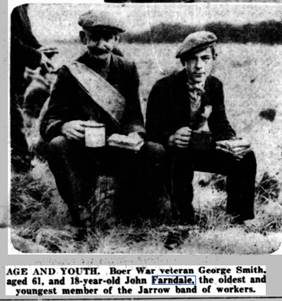
(Leicester Evening Mail 21 October 1936)
The
Jarrow March
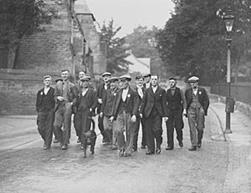
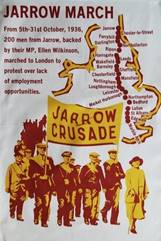
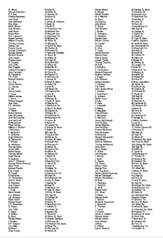

The
Jarrow March too place between 5 to 31 October 1936, also known as the Jarrow
Crusade. The march was an organised protest against the unemployment and
poverty suffered in the English town of Jarrow during the 1930s. Around 200 men
(or "Crusaders") marched from Jarrow to London, carrying a petition
to the British government requesting the re-establishment of industry in the
town following the closure in 1934 of its main employer, Palmer's shipyard. The
petition was received by the House of Commons but not debated, and the march
produced few immediate results.
In 1936, George Farndale, son of
John Willie Farndale, (K1), the South Shields 2 Line,
a member of the Jarrow Boys Brigade spotted a drowned person from a cliff and
ran to drag him out. He later moved to Fulham and Croydon and founded the London 3 Line.
Having been forced back from Canada due to the Great
Depression, Alfred Farndale (my grandfather), twelfth child of Martin and Catherine Jane (nee Lindsay) Farndale
and Catherine nee
Lindsay (K1), the Tidkinhow Line,
settled near Northallerton. He later recalled: “We
had a farm in Middleton-One-Row in 1936 and then we moved to Sycamore Lodge at
Thornton-le-Moor near Northallerton in 1937. That was where Margot was born. It
was too small though and we left it in 1940 after the war had started. We then
lived at 117 Crosby Road, Northallerton. I was a farm contractor doing
ploughing and threshing. It was very hard work and very long hours. I was
Special Constable as well. Then, in January 1943, we moved to Gale
Bank Farm at Wensley. We had been looking for farms for years and
this was easily the best, so our luck had changed. It was then about 400 acres,
but now it is more. Peggy and I retired in 1972 and we are now living at
"Highfields", Eller Close Road, Leyburn."
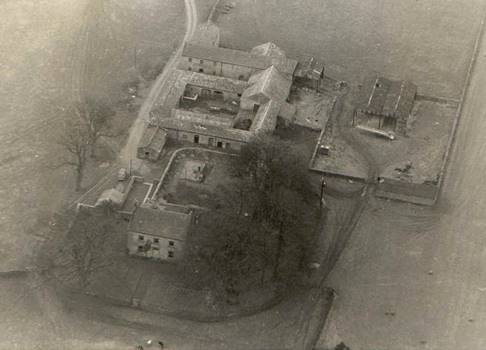
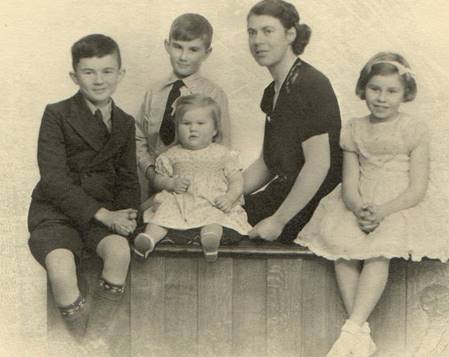
Gale Bank Farm which Alfred Farndale (my
grandfather), and later his son Geoffrey Farndale farmed
until the 1990s. Alfred’s family, Martin Farndale, Geoffrey Farndale, Margot Farndale, Peggy Farndale and Anne Farndale at
Thornton-le-Moor.
Of life at that time, Martin Farndale (my
father), son of Alfred Farndale (my
grandfather), and Margaret Louisa (“Peggy”) nee
Baker Farndale (K1),
the Wensleydale Line,
recalled: I remember our stay in Conway. King George V’s silver jubilee was
in June 1935 and there were parades and illuminations at Conway Castle. We
visited Snowden and Betsy Coed and later drove to “The Upwoods” in Derbyshire
near Utoxeter where Uncle Geoff and Aunt Hilda lived. Meanwhile my father was
negotiating the purchase of a farm at Middleton-One-Row near Darlington and we
moved north to stay with my father’s sister, Dorothy and her husband Alfred
Ross who lived at Green Farm, Skelton Green, Skelton in Cleveland.
Eventually in about September 1935, we moved to the 100 acre farm at
Middleton-One-Row on the River Tees and just inside County Durham. But it was
not a success and my father was already looking for something better. I don’t
remember too much about this period except visiting new relations. In
particular my sister Anne and I went to stay at Tancred Grange at Scorton near
Richmond to stay with yet another of my father’s sisters. Lynn, whose husband
George Baker had died many year before, but living there were their children,
Margaret, William, John, George and Dorothy. I particularly remember their
gooseberry pies! Another first visit was to my father’s eldest brother John who lived with his
wife Elsie at Tidkinhow Farm near Guisborough where all the Farndale
family had been born. I have memories of my uncle John clipping sheep near the
house. Then in Spring of 1936 we moved again to Sycamore Lodge Farm,
Thornton-Le-Moor, near Northallerton which was a much better and slightly
bigger farm, but still not really big enough for my father’s plans. I was seven
and my sister Anne was six and we had not yet been to school. So mother fixed
us up at a small private school called Wensley House School in South parade,
Northallerton which was run by an old fried of hers, Mrs Harriet Lord. I have a
lot of memories about Thornton -Le-Moor and Wensley House school and holidays
by the sea with Aunt Dorothy at Skelton or Aunt Hilda in Derbyshire at the
“Upwoods”. I thoroughly enjoyed working with my father about the farm. Most of
the work was done by horses and at threshing time great steam engines arrived
with great gags of men who worked through the threshing days. Huge meals were
cooked by my mother for up to twenty men at a time. Again we had a Nanny,
Betty, who married the son of the farmer opposite (history repeating itself!),
but he was tragically electrocuted by his new electric milking machine only a
year or so later. Every day Anne and I, and later Geoffrey as well, were driven
into Northallerton, which was five miles away, to school and we were collected
in the evening. School was a very new adventure and not easy going for me. Mrs
Lord was a hard but far task master, insisting on high standards. Much was
learnt by heart – poems, hymns and tables. Mr Lord taught history ad geography
and these quickly became my favourite subjects. On Friday afternoons the school
walked in a long crocodile to the village of Romanby, there to sit and watch
lantern slides given by a Mr and Mrs Linton about their travels to the Holy
Land and Egypt. These were wonderful, hazy black and a browny colour and white,
but they opened up the idea of travel and excitement. They also taught us a
great deal and left a deep impression on me. It was at Wensley House school
that I made my first friends. Richard Sawfell was the son of the county
surveyor whose mother knew my mother before they were both married. David
Ramsden was the son of a farmer near Northallerton. Jack Errington came with
his mother during the school holidays to stay with his Grandmother in
Thornton-Le-Moor. About this time I became aware of the world situation and
listening to the BBC radio news became a feature. There were press pictures of
a man called Adolf Hitler and another called Mussolini. My father talked about
his army days and our games in the woods were always as soldiers fighting the
Germans. Once, it must have been in about 1938, I remember seeing a colour film
about Rogers Rangers in Canada and for months afterwards we were Roger Rangers
in all our games. About this time I was given a bicycle. We used a cycle
everywhere with Betty and it was all exiting. On Sundays we went to the village
Sunday School and on Saturdays we each had 6d (sixpence) and spent it at the
village shop seeing how many different items we could get. One stick of
liquorice and a small paper sachet of Sherbert were about 1/4d each, a small
packet of sugar cigarettes a penny and a bar of chocolate 2d. I was pretty
bossy at that time and I had the advantages of ‘supervising’ the expenditure of
all our money, which together was 1/6d. I collected tin soldiers at 1d or 2d
each. This normally meant going to Northallerton or exceptionally to Woolworths
at Darlington. I also collected Meccano and Hornby trains, but had to rely on
Father Christmas for these more expensive items. My parents both worked very hard and times
were not easy. My mother looked after us wonderfully well and set very high
standards. She taught us all how to behave, how to talk, to dress and conduct
ourselves in company. There were quarrels, which I remember worried me, but I
realise they were never very serious. In 1937, on 8 October, my sister Margaret
Susan was born. The idea was that the three of us should go and stay with Aunt
Dorothy for a few days during the confinement, which was of course at home. My
father took us half was and at the Tontine Hotel near Stokesley we met my aunt
who would take us on. However Geoffrey, who was five at the time, screamed and
yelled and refused to go and had to be taken back home. We were all very
excited about the new baby and took it in turns to help. Life was suddenly very
busy.
In February 1936, Ernest William Farndale,
son of William Farndale, (K1), the John Farndale section of the Loftus 2 Line,
was a performer of humorous ditties and stories at the
Shipley Unionist Club annual dinner. He was also a farm manager at Fubro Farm,
Brotton. By 1950, he was at Freeborough Farm, Moorsholm.
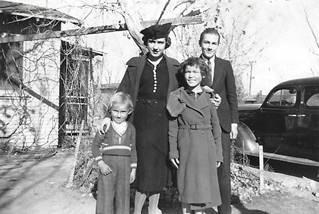
Hazel Jane Farndale (“Janie”),
Jimmy Farndale, Gordon Farndale and Mary Farndale, children
of James (“Jim”) and Edna nee Adams
Farndale, the Nevada Senator (K1),
the American 1 Line
in 1937
Joseph Farndale CBE
KPM, son of Thomas and Sarah nee Bell Farndale,
(K1),
the Wakefield 1 Line
previously Chief Constable of Bradford City Police Force and now a Traffic
Commissioner for Yorkshire had married Emma Selby in 1883. Emma died in 1936.
Joseph later married Maggie Emmott.
1938
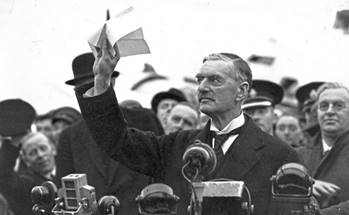
“Peace in our time”
On 19 August 1938 Audrey Celina McKelvie (nee Farndale), daughter of Mark and Mary (nee Wiltz) Farndale,
granddaughter of John George and Elizabeth (nee
Sanderson) Farndale, veteran of the Crimean war, and great
grand daughter of John Farndale,
the author (K1),
the Ontario 1 Line married
Ernest Stewart McKelvie in Manitoba. Audrey was later employed as a comptometer
operator with the Hudson Bay Company.
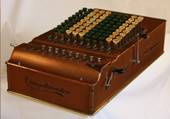
The comptometer was the first commercially successful
key-driven mechanical calculator, patented in the United States by Dorr E. Felt
in 1887.
In 1938, Charles (“Charley”) Farndale, son of William Farndale, (K1), the Richmond Line,
married
Harriet Raw at Richmond Centenary Methodist Church.
Harriet wore an ivory satin dress, with a veil and coronet of orange blossom,
and carried red roses. Charley was active with the young farmers and he farmed
at Gillingwood.
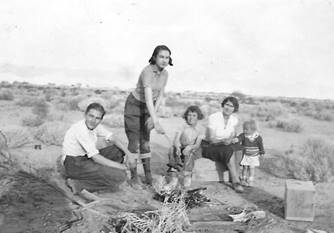
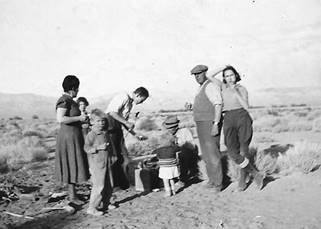
Jimmy Farndale, Hazel Jane Farndale (“Janie”),
Doris Farndale,
children of James (“Jim”) and Edna nee Adams
Farndale, the Nevada Senator (K1),
the American 1 Line
with their aunt Grace Holmes nee Farndale,
the Tidkinhow Line
in California August 1938
By 1938 Thomas Henry Farndale,
son of Samuel and Pollie nee Chesters
Farndale, (K1), the London 1 Line was
a detective sergeant. Later an Inspector, a real life ‘Foyle’s War’, he solved
crimes during the Second World War in Surrey. He was involved investigating a
serious crime involving the murder of a maid by three soldiers. He continued to
solve crimes until he retired in 1955. His experiences are well recorded in the
media and in a record of his service in the Surrey Mirror on 4 November 1955.
After he retired from the police, he was a licensee of the Plough Inn at
Dormansland and later President of the Caterham Licensed Victuallers
Association.
1939
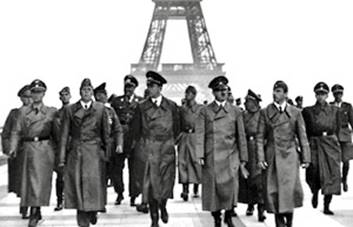
1 September Start of World War 2
29 September 1939 – mini census and issue of identity
cards
Evacuation of women and children from London.
Martin Farndale (my
father), son of Alfred Farndale (my
grandfather), and Margaret Louisa (“Peggy”) nee
Baker Farndale (K1),
the Wensleydale Line,
later recalled: By 1939 Margot (as she was always called) became our
casualty in games and was regularly carried about in a stretcher. It can’t have
been very safe. Over Christmas, 1938 I think, I was given an air rifle. This
was a truly prize possession and gave me a huge advantage over everyone. One
evening, Jack Errington and myself decided to ambush cars as they came along
the road into the village. We were certainly not firing pellets, but the
village Bobby did not know that and he cycled up to us and made a great point
of entering our names into a book and saying ow dangerous air rifles were and
that he would speak to my father. I was terrified, but nothing ever happened.
I’m sure that he never did speak to my father, but he taught me a lesson early
in my life which I’ve never forgotten, about the dangers of weapons. About this
time there was much going on that I didn’t understand. My
mother would come and sit with me as I went to sleep at night and these moments
became highlights of those days. I adored her, she seemed to
understand everything and she never failed to set my mid at rest whatever my
problems. I owe her a great deal indeed. She ensured that we grew up with balance
and understanding of other people. My father, who I worshiped, represented
all that was strong, good and upright in life. He was direct, outspoken and
reliable. I always felt nothing could happen to us if he was there. We were
unbelievably lucky with our parents. Almost without knowing it they gave us all
an ideal upbringing, treating us all the same, insisting on standards, respect
for them, and for the law, yet with love and understanding which gave us great
confidence. By 1938 I realised that I was to go to Northallerton Grammar School
if I could pass the entrance exam. It was clear that I had a chance, but that
my maths was weak. I remember that three times a week a retired school mater,
Mr Archer, came in to teach me maths. I didn’t enjoy it but it did help. Anyway
in 1939 I passed the exam, though not with the scholarship which would have
helped my parents so much. I was to start in September 1940. By 1939 it was
arranged that Anne and I should go to school by train. This meant cycling to
Thornton-Le-Moor station and then walking from Northallerton station to the
school in Smith Parade. I remember pre war Christmases both in Canada and
Yorkshire. It all started at Halloween on 30 October, which was Anne’s
birthday. We hollowed out turnips and cut faces in them, putting candles inside
and suspended them rom sticks and walked through the village after dark making
howling noises. Then came Guy Fawkes day on 5 November with its bonfire and
guy, baked potatoes and a few fireworks. Next was writing letters to Father
Christmas, a major event, which was supervised by Mother. They had to be just
right and not asking for too much. School broke up on about 15 or 16 December
and soon we were out carol singing. The excitement was almost unbearable. On
Christmas Eve we left a glass of sherry, a biscuit and a florin on the kitchen
table for Santa Claus, which had always been consumed next day. Somehow Santa
Claus’ crumbs on the plate on Christmas morning were magic! I remember the fire
in the bedroom on Christmas Eve and its flickering flames. It all seemed very
strange, but we never questioned it. I was eight when I discovered the truth
and was bitterly disappointed, but my mother told me not to worry as there was
o reason for it to stop. Christmas 1939 produced a clockwork model of the
Flying Scotsman, which was a dream come true. I remember at this time realising
that war might happen. We were all on holiday at Lymington in Hampshire,
staying with Great Aunt Catherine playing with trains in an upstairs bedroom with
Jack Errington when on Sunday 3rd September 1939 my mother called us down at 11
o’clock to listen to the radio. I can clearly remember hearing the Prime
Minister, Mr Neville Chamberlain, saying “… we are therefore at war with
Germany”. Things then happened very quickly. Gas masks arrived and we stuck
paper strips on our windows to prevent them shattering. Evacuees arrived from
the big cities. Our farm was used as an assembly point for them and I was
shocked at their poor dress and how without shame they ‘made water’ against our
house. They had never seen a cow or hose and they had bugs in their hair. They
didn’t stay long. They could not take the country and soon they all went back
home. As the eldest, I had a few privileges and one was to be allowed back downstairs
at 7.30pm to listen to Arthur Askey and Stinker Murdock in Band-waggon on the
radio and once to go to the cinema in Thirsk in the evening to see “Enid Bob”
with my parents. We all always went to bed at 7pm until we were about ten. Non
nonsense, no arguments. However we were always tired and were asleep in
minutes. Our birthdays were always made into great days, but without
ostentation. We all had to save up to buy each other presets, not much, but
enough to make the point. We used to get together and make or buy something for
our parents and watch the huge pleasure which they always showed when we woke
them up. Times were never easy in those days. We never had much but we learned
early how to use it, save it, and how to think of others. At this time my
father felt that we must move and that he must get a bigger farm. Rightly or
wrongly in 1940, he sold Sycamore Lodge ad we moved to 117 Crosby Road,
Northallerton. My father became a thrashing and ploughing contractor until he
could get another farm. To his dismay this period turned out to be some three
years. I started at Northallerton Grammar School in September. I was sorry to
leave Wensley House, which had given me a wide background in life. The Grammar
School was big and frightening, particularly the head master, Mr H J Palmer.
Competition entered my life and I was pushed to keep up. I managed well in
arts, but struggled with French, maths and French. It was while at school that
I joined the Boy Scouts and was very proud of my uniform. I took it all very
seriously as a patrol leader of the Woodpeckers. I became keen on woodwork and
model making, using tools and odd scraps of wood to make ships and aeroplanes.
Identifying aircraft was an absolute requirement and most of us could identify
both British and German planes by sound alone. My scouting led me to do duties
on the air raid warning communications in the Town Hall when I was thirteen.
This seemed most important particularly when we got waring of enemy aircraft
approaching. About this time I joined D Company of the Northallerton Army Cadet
Force battalion, which involved drill nights twice a week at the new
Allertonshire Secondary School. There were Saturday morning parades and
exercises. We were attached to the Green Howards and wore their cap badge. I
was proud of my battledress and Green Howards uniform and my first guard duty
was at Gallowgate Camp, Richmond, outside our tented camp. By about 1942
I got a Saturday job as an errand boy working for the local grocer’s shop and I
often helped to serve in the shop too. This gave me 2/6d for a morning’s work
and together with my now 1/- pocket money on a Saturday, this gave me untold
riches. We went off on visits much less now, but somehow we still got away on
holidays to Skelton and occasionally to the Upwoods. On many occasions at
Skelton we could hear the bombing and the anti aircraft guns on Teeside. This
happened in Northallerton too. One night a stick of bombs fell right across the
town with a terrific crash as we huddled under the stairs. My father made a dug
out in the garden, but it filled with water and I never remember us using it.
One afternoon, with Aunt Lynn with us for tea, a German bomber flew overhead
with two spitfires attacking it, machine guns blazing. On another occasion,
while playing in a field on David Ramsden’s father’s farm, a Heinkel bomber
came low overhead and we stood mesmerised looking straight at the German pilot,
but nothing happened. My father was a special constable and went out nightly
helping the police. My father was
working very hard indeed at this time. It was hard physical graft and very long
hours, but there was plenty of work as farmers grew all they could. Sometimes I
went with him and I learnt how to plough on his Massy-Harris tractor. We once
ploughed in one of the fields from our old farm at Thornton-Le-Moor where I
remembered doing some ploughing with a pair of horses some year before.
Frequently on Thursdays I would cycle out to an agreed point and await my
father with his threshing crew to bring the men their wages. But all this time my father was trying to get
another farm. He went to many, was short listed for some, and turned others
down. I went to some with him at weekends and I remember sharing is hopes and
disappointments. It was a difficult but exhilarating time. There was not much
money, and a lot of hard work. We had always had a car at this time. We had a
1937 Morris 12 which, in 1942, my father exchanged for a Standard 12 which he
got from our doctor, Doctor Milne.
By 1939, Alfred Farndale, son of
Arthur Edwin Farndale,
(K2)
of the Loftus 2 Line
was
a railway engine fireman.
In 1939, Ethel Farndale (later Hall),
daughter of Joseph and Elizabeth Farndale,
(K1),
the Kilton 1 Line,
was a conductress on an omnibus in Barnard Castle.
By 1939, John Farndale, son of, John W Farndale and
Jane nee Wade, (A1),
the Bishop Wilton
Line was a bus conductor in York.
By 1939, Tom Farndale (A1), the Founder of the Uxbridge Line, was an engineer and metal
and sheet turner in Ruislip, Middlesex.
In 1939, Clara Steinmetz (nee Farndale)(A1), the Stockton 3 Line,
was living in Stockton, the wife of John Steinmetz, a foundry worker. Steinmetz
is a German surname, meaning stonemason.
In 1939, Julia Irene Farndale (A1), the Ampleforth 1 Line,
was a house parlourmaid with the family of Captain Brian Williams of the Life
Guards.
In 1939, Richard Farndale, son
of John William and Louisa nee
Hutchinson Farndale, (K1), the Loftus 3 Line, was a master meat retailer
in Whitby.
In 1939, Reginald Arthur Farndale,
son of Robert and Sarah Farndale
(A1),
the Ampleforth 1
Line (formerly butler to the Piercy family, but also a
workhouse inmate for a time) was a patient at the Cranage Institution at
Congleton, Cheshire where he was suffering mental illness.
In 1939, Rubina Farndale,
daughter of James and Mary Farndale,
(A1), the Ampleforth 1 Line was a hospital ward maid at Eston
Hospital, Middlesbrough.
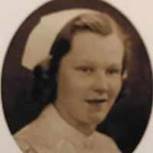
In 1939, Sophia Foster (nee Farndale),
daughter of Charles Farndale of
Kilton Hall Farm (K1),
the Kilton 1 Line,
who had married Maxwell Foster in 1909, was living at a house called ‘Kilton’
in Stockton.
In 1939, Edith Farndale,
daughter of John Farndale, (K1), the Whitby 5 Line the mines deputy at Loftus, was an inmate in the Poor Law
Institution in Stokesley.
In 1939, William Farndale, son
of Henry and Elizabeth nee Armin
Farndale, the Hartlepool 1
Line, was an engineer in Bradford.
In 1939, Thomas Farndale, son of
Thomas William and Christie Ann (nee
Dixon) Farndale (K1),
the Whitby 5 Line,
was an underground mines horse driver. He
was also a pigeon racer around Loftus.
In 1939, William Barnes Farndale,
son of Mary Elizabeth Farndale
(K1),
the Great Ayton 2
Line was a hotel manager at the White Horse Hotel in Ripon,
working with his cousin Charles Frederick Farndale,
son of Joseph and Sophia Farndale,
(K1),
the Great Ayton 2
Line, a licensed victualler.
On 30 August 1939, Cyril Ernest Farndale,
son of William Farndale, a
veteran of the First World War (K1)
the Great Ayton 3
Line enlisted into the Royal Artillery and served in 100
Anti Tank Regiment Royal Artillery. He was discharged on 12 July 1942. From
1944, he was a postman in Leeds.
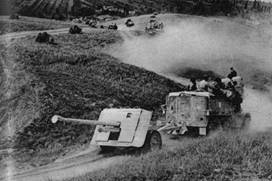
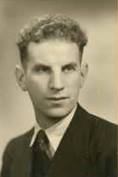
100
(The Gordon Highlanders) Anti-Tank Regiment RA (TA) was formed in November 1941
from 8th Battalion The Gordon Highlanders with four batteries at Buckie, Banff.
It was re-designated 100 Light Anti-Aircraft/Anti-Tank Regiment in January 1944
and reverted to 100 (The Gordon Highlanders) Anti-Tank Regiment RA (TA) in the
September. The Regiment disbanded in January 1947.
In 1939 Ronald Farndale, son of
William Farndale, (K1) the Great Ayton 3 Line
was disabled and in the care of the Claypenny Colony, Easingwold.
In 1939, Edwin Farndale, son
of Matthew and Mary (nee
Liverseed) Farndale, (K1),
the Craggs Line was
a bank manager in Middleton in Teeside, Barnard Castle. He had married Mary
Rogers in 1922 and they later moved to Northumberland and their daughter, Julia May Parnall (nee Farndale)
lived at Hexham.
In 1939 Doris Farndale,
daughter of Henry Farndale, the Hartlepool 1 Line
was
a fly frame spinner in Bradford.
In
1760 England, yarn production from wool, flax and cotton was still a cottage industry
in which fibres were carded and spun by hand using a spinning wheel. As the
textile industry expanded its markets and adopted faster machines, yarn
supplies became scarce especially due to innovations such as the doubling of
the loom speed after the invention of the flying shuttle. High demand for yarn
spurred invention of the spinning jenny in 1764, followed closely by the
invention of the spinning frame, later developed into the water frame (patented
in 1769). Mechanisms had increased production of yarn so dramatically that by
1830 the yarn cottage industry in England could no longer compete and all
spinning was carried out in factories.
Joseph William Farndale
and Sidney George Farndale,
sons of Joseph and Margaret Farndale,
(K1),
the London 4 Line
were evacuated as children to Eton during the War.
In 1939, Walter Reginald Farndale,
son of Samuel and Pollie nee
Chesters Farndale, (K1),
the London 1 Line
was
an administrative clerk with Imperial Airways. He benefitted from financial
adjustments under the Liabilities War Time Adjustment Act 1941 and 1944, which
made adjustments for circumstances impacted by the War.
In 1939, Robert Edwin Farndale
and Maurice Farndale, both
sons of Robert and Sarah Jane nee
Alcock Farndale, (K1),
the Wakefield 1 Line
married Florence Cooper and Lena Stanley in a joint wedding. Maurice was a
dairy farmer and the family later lived in Lancashire. Robert was also a dairy
and mixed farmer and they lived near Skipton, North Yorkshire.
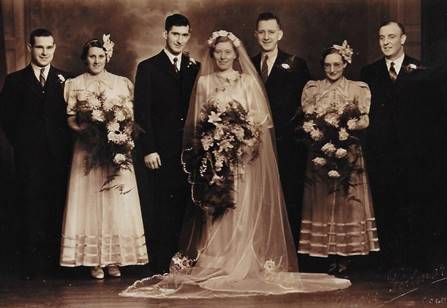
Joint Wedding , Maurice Farndale and Lena Stanley,
Robert Farndale and Florence Cooper and others unknown
1940

May 1940 - Winston Churchill, in his first address as
Prime Minister, tells the House of Commons
of the United Kingdom, "I have nothing to offer you
but blood, toil, tears, and sweat."
Dunkirk Evacuation – May to June 1940

The Battle of Britain was a military campaign of the Second World War, in which
the Royal Air Force (RAF)
defended the United Kingdom (UK)
against large-scale attacks by Nazi Germany's air force, the Luftwaffe. It has been described as the first major military
campaign fought entirely by air forces. The British officially recognise
the battle's duration as being from 10 July until 31 October 1940, which
overlaps the period of large-scale night attacks known as The Blitz, that lasted from 7 September 1940 to 11 May
1941.
Blitz over Swansea
By 1940, Wilfred (or “Wilf”) Farndale,
son of Tom Farndale
(A1),
the Stockton 3 Line,
lived at Filton, near Bristol, with his wife Doris Eveyln nee Howard. Wilf later worked with the Bristol Aircraft
Company making aircraft jigs, the framework on which aircraft were built. He
was Founder of the New Zealand 2 Line.
In 1940, an article appeared in the Middlesbrough Daily
Gazette, in relation to George Farndale, second
son of Charles Farndale of
Kilton Hall Farm (K1),
the Kilton 1 Line:
THE THIRD GENERATION. For over a century the Farndale family have been
associated with the Loftus and Staithes ex Wesleyan circuit, a connection which
is soon to be severed by the removal of Mr George Farndale from Kilton Lodge to
Saltburn. A member of the third generation of the well known family, Mr
Farndale has been a circuit official for over 20 years, and a steward for
seven. His grandfather was a local preacher in the circuit for a number of
years, and the late Charles Farndale upheld the family tradition by serving for
the major period of his life as circuit official and steward. In the outlying
districts of the circuit Mr George Farndale has worked equally hard and still
stands as a trustee for many of the circuit chapels.
George Farndale and his
sister Grace Farndale lived in
Saltburn from this time when Kilton finally lost its association with the
Farndale family after over three centuries.
In May 1940, Ethel Farndale,
daughter of Annie Farndale, who was
single, a dressmaker in Loftus (K1),
the Whitby 5 Line,
was killed when her clothes went aflame in a kitchen in Middlesbrough, where
she was a domestic servant.
Herbert Farndale, son
of Matthew and Mary (nee
Liverseed) Farndale, (K1),
the Craggs Line lived at Craggs Hall Farm and on 3 September 1940 the
farmhouse received a direct hit by a German bomb. The house was rebuilt. He
retired to live at 10, The Avenue, Brotton.
Herbert was an independent Councillor, a member of Skelton and Brotton urban
council.
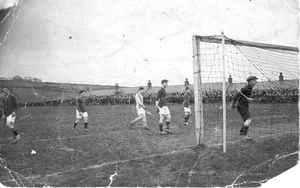
This
is Carlin How football field. The goal is the Kilton Lane end of the pitch and
in the distance at the left end of the houses can be seen Lower Cragg Hall
farm. To the left of that and higher can be seen Upper Cragg Hall farm buildings
and house among the trees. Herbert Farndale owned this when we were youngsters.
I believe one of the teams was a Skinningrove works team. Derek Pearson lived
in that left hand house in the late 1940s and could watch the matches over our
garden fence. This was what was fondly known as Bells Huts and is behind what
is now the Bullet and Bayonet on Kilton lane. The foundry now stands exactly
where that row of houses was.
Bertram George Farndale
son of John Martin Farndale, (K1), the Newfoundland Line
served as a Sergeant in the Royal Army Ordnance Corps between 1940 and 1945. He
later worked in insurance and lived in Harrogate.
In December 1940, Enid Florence Farndale,
daughter of Rev William Edward and Florence
Farndale (K1),
the William Line,
married
Ralph Cartwright in Lincoln. Enid was a dressing gown cutter and served in the
Air Raid Patrol (“ARP”) service at the start of the War.
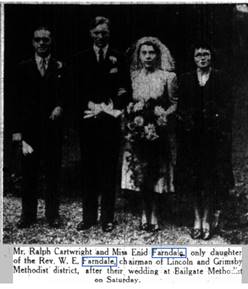
1941
Private James Farndale, son of James Farndale
and Margaret nee Murray (A1),
of the Stockton 3 Line,
was born in 1916 in Stockton on Tees. Aged 24 of the West Yorkshire
Regiment, James died of wounds on 16th March 1941 in Eritrea. James is buried
at Keren War Cemetery, Grave Reference 3.A.3, inscribed Beloved
Son of James and the Late Margaret Farndale, God Grant him eternal rest.
Operation APPEARANCE was a British landing in British
Somaliland on 16 March 1941 against troops of the Italian Army. In August 1940,
seven months previous, the British had withdrawn from British Somaliland, after
it had been invaded by the Italian army. The British and Empire forces from the
United Kingdom, British India, Australia and South Africa conducting APPEARANCE
made the first successful Allied beach landing of the war and retook the
colony. Keren was the last Italian stronghold in Eritrea and the scene of the
most decisive battle of the war in East Africa in February and March 1941.
Guarding the entrance from the western plains to the Eritrean plateau, the only
road passing through a deep gorge with precipitous and well fortified mountains
on either side, Keren formed a perfect defensive position. On these heights the
Italians concentrated some 23,000 riflemen, together with a large number of
well sited guns and mortars. A preliminary assault by United Kingdom and Indian
troops was repulsed after a week of bitter fighting, although they gained and
held a valuable position on Cameron's Ridge, on the left of the road. The final
battle began a month later. After ten days of gruelling combat the Commonwealth
troops succeeded in forcing their way through the seemingly impregnable
defences on the ridge and finally through the 200 metre long road block which
the Italians had blasted at the narrowest point in the pass. Keren was taken on
27 March. The defeated Italian force retreated in some disarray to Asmara,
which fell to Commonwealth forces on 1 April, and the Italian surrender was
taken at the port of Massawa on 8 April. KEREN WAR CEMETERY contains 440
Commonwealth burials of the Second World War, 35 of them unidentified. The
KEREN CREMATION MEMORIAL stands within the cemetery and commemorates 285 Sikh
and Hindu soldiers from India and Pakistan killed on the Keren battlefield
during the Second World War, whose remains were cremated in accordance with
their faith. Three East African soldiers are also commemorated on the memorial.
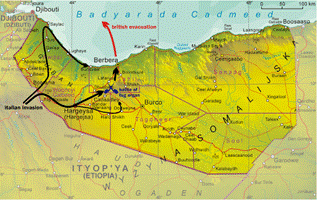

December 1941 – The Japanese attack on Pearl Harbour.
Private Richard (“Dick”) Farndale,
son of George William and Frances nee
Hilton Farndale, (K1), the American 2 Line
attested into the army on 28 March 1941 at Chicago, Illinois and served in the
US Army during World War II, spending more than four years in the Pacific
theatre of Operation. He was a mechanic with the 43rd Division.
On 20 December 1941, Hazel Jane Farndale (“Janie”), daughter
of James (“Jim”) and Edna nee Adams Farndale,
the Nevada Senator (K1),
the American 1 Line
married John Elif Rydell. John was a Master Sergeant in the US Air Force during
WW2 and Korea. Janey later lived in Austin, Texas and was a regular visitor to
the family in Yorkshire.
Ronald Martin Farndale,
son of Robert and Sarah Jane nee Alcock
Farndale, (K1), the Wakefield 1 Line
had emigrated to New Zealand and served in 6th Field Ambulance,
Royal Army Medical Corps in Greece and Crete, before he was captured at the
Battle of Sidi Rezegh in 1941. He later became a builder and carpenter in
Masterton, near Auckland, New Zealand.
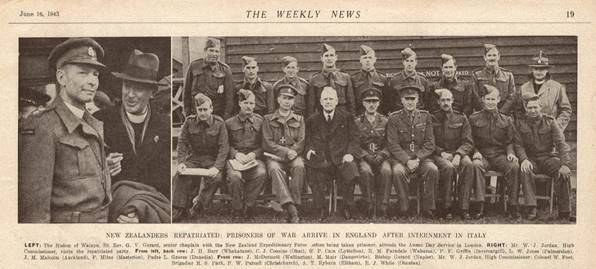
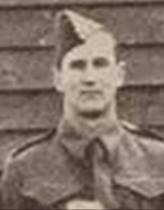
Private William Arthur James Farndale,
son of Rev William Edward and Florence
Farndale (K1),
the William Line,
served
in the Royal Army Ordnance Corps and was later commissioned and reached the
rank of Major. He clearly studied in the later years of the War and by 1945,
was awarded the Degree of Bachelor of Commerce at London University. He must
have served in Egypt, since he gave lectures after the War about his experience
of the risks of water borne diseases in Egypt.
1942
2 December 1942 – The Manhattan Project:
Below the bleachers of Stagg Field at the University of Chicago, a team
led by Enrico Fermi initiates the first self-sustaining nuclear
chain reaction

HMS Farndale was ordered on 4 September 1939
under the 1939 War Emergency Build Programme. She was completed in April
1941. She was adopted by the civil community of Southgate, then in Middlesex,
as part of Warship Week in 1942.
She earned eleven battle honours for extensive service during the Second World
War. This included service in the Mediterranean where she was severely damaged
in February 1942, and resulted in extensive repairs in the UK that year. She
then saw service with Russian convoys, followed by work to support the allied
landings in Italy. Towards the end of the war she was nominated for service in
the Far East in support of Operation Zipper for landings in Malaya, which was
cancelled with the end of the War.
Sergeant William Derrick Farndale,
son of Joseph and Minnie (nee Hughes)
Farndale, and grandson of William and Mary Jane Farndale,
a local methodist preacher and later a town missionary in Macclesfield,
Cheshire (K1),
the Whitby 5 Line,
a motor fitter and tractor driver, was a patrol member in the Withernsea Patrol
on the East Yorkshire Coast from 1942 until 3 December 1944. The
Patrol's Operational Base was a square type shelter built out of pit props and
with a corrugated iron sheet roof. It was built on a hill near Little England
Farm to the west of the town. The higher ground gave a good all round view of
the coast and inland fields. The Patrol targets were the landing
beaches on the east side of Withernsea, Tunstall beach was an expected German
target, along with the road from the coast inland, Spurn Point Coastal Battery,
Channel Farm Search Light battery and the land drainage system to the west.
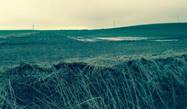
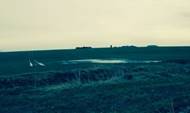
Patrol
view to the South
Patrol view to the East
William
married Lily Peck in 1942 in Holderness and William and Lily founded the Holderness Line.
Jimmy Farndale,
son of James (“Jim”) and Edna nee Adams Farndale,
the Nevada Senator (K1),
the American 1 Line
enlisted into the US Army on 15 December 1942 and was discharged on 18 January
1946. He served in the US Army Air Corps.
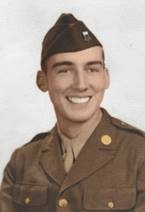
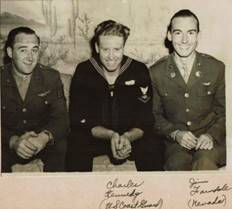

Jimmy Farndale Taken at the Derby Club, San
Francisco in April 1945
Martin Farndale (my
father), son of Alfred Farndale (my
grandfather), and Margaret Louisa (“Peggy”) nee
Baker Farndale (K1),
the Wensleydale Line,
later recalled: Towards the end of 1942, I came home from school one day to
be told by mother that it looked as if we had got a farm near Wensley in
Wensleydale. I had never been there, but I knew some children at school who
came from up there. It had always seemed a strange a remote land to me.
However, I was to cycle out to quickly give the message to my father as he was
wanted for an interview. Apparently, the existing farmer was not up to the
standard demanded in war time by the War Agricultural Committee and he was
being turned off the farm. My father was to be interviewed by the “War Ag” and
by the Bolton estate on which the farm lay. I remember to this day the
excitement he showed saying in his quiet way, “that’s splendid news”. It was
indeed the best farm he had bid for and the one he wanted most, some 450 acres
between Wensley and Middleton, called Gale Bank Farm. He knew it well and had
already done some work on it. A few days later we heard that he had got it,
which was indeed wonderful news. It meant a lot of changes. Anne and I were
both at Northallerton Grammar School aged 13 and 212 respectively, Geoff was at
Welsey House School aged ten, and Margot at home but about to start school.
We moved to Gale Bank on 28 January 1943. I remember it all very well. The
furniture van came and everything was backed up. The rest of us went in our
heavily overloaded Standard 12. I remember it over heating just outside Bedale
and my father going into a farm and helping himself to a bucket of water! I
remember our arrival well, the house, and the buildings were quite empty and we
children raced throughout the empty house. There were strange smells
everywhere, particularly that of smoked bacon, which our predecessors had done
for years. We raced through all the farm buildings which were big and extensive
compared to anything we had known before. It must have been cold in January and
apart from a fire in the drawing room and kitchen in daytime only there was o
heat. But I don’t remember it being cold. With great excitement e all chose our
bedrooms and then the furniture van arrived and we all helped move our things
into the house. The beds were made – the same ones we had got out of that
morning in Crosby Road, and we were ready for bed in our new house. Little did
we know what a major step in our lives this day was to be for us all. Gale Bank
was to become our home, and a firm base for us all, for many years to come.
Geoff and Margot started at Wensley school. Anne and I started at Yorebridge
Grammar School straight away. This meant a three mile walk or cycle across the
fields and roads to Wensley station, a 15 mile train journey, and then s short
walk to the school, then a return in the evening. It meant an early rise,
leaving the house in the dark at 7.15am and getting home about 5.15pm.
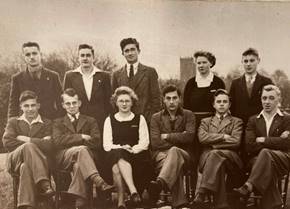
Yorebridge
Grammar School (Martin Farndale centre
rear row)
1943
Conclusion of the two year National Farm Survey.
In 1943 Kenneth (“Ken”) Farndale,
son of William Farndale, (K1) the Great Ayton 3 Line
married Edna Walker. He was a farmer and founder of the Wetherby 2 Line.
Raymond W S Farndale,
son of John Martin Farndale,
(K1),
the Newfoundland Line
served in 59th (Newfoundland) Heavy Regiment Royal Artillery as 970929 Gunner
RWS Farndale in England. He left Halifax on 6 Jun 1940 and went to 23 OCTU at
Catterick in March 1943 and was commissioned into the Royal Artillery in
September 1943. He was posted to 23rd Heavy Battery, 59th (Newfoundland) Heavy
Regiment RA at Ashford Kent. 20th and 23rd Heavy Batteries were given 155mm
guns and 21st and 22nd Heavy Batteries were given 7.2-inch guns. The regiment
trained in Northumberland but by July1944 it was at Worthing in Sussex. It went
to France and took part in the battles for Caen. By VE-Day it was at Hamburg.
Lieutenant RWS Farndale RA went back to Canada in September 1945 with the
Defence Medal, the 1939-45 Star and War Medal with a Mention in Dispatches. He
joined 166th (Newfoundland) Field Regiment RCA (Reserve) and was with them
until 1954, retiring as a Major, earning the Canadian Forces decoration (CD).
He became an accountant and lived at St Johns, Corner Brook, Toronto and
Halifax.
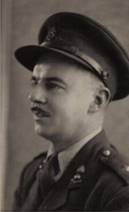
Ray, a true gentleman, was kind and generous of spirit.
He was passionate about inclusion, notably those with special or medical needs and
those marginalized by poverty or life circumstances. He adopted many local and
international causes, always adapting with the times. He loved his Blue Jays,
mystery novels, choir singing, politics, good jokes and live music. A life-long
learner, he conquered the computer and worked well into his 90's, as an
accountant. He always enjoyed "doing his books", gardening, walking,
swimming, skating, ballroom dancing and amateur acting. While a man of few
words, he demonstrated deep emotion and always had a twinkle in his eye. Ray
was a proud veteran of World War II, serving as Lieutenant in the 23rd Battery
of the 59th Regiment of Royal Artillery and was awarded the Canadian Forces
Decoration (CD). He was a devoted husband to Ellie Tipple, with whom he shared many
adventures, until her passing in 2010. He was a dear father to Keith (Sue)
Farndale, and Denise (Jack) Watson and was a special Poppy to Emily and
Christopher Watson and granddog Molly, who adored him. Ray was pre-deceased by
his British parents, John and Bessie, and his younger brother Bertram. He was a
loyal friend to many and had strong relationships, most recently with those at
Wellington Park Retirement Residence. All who knew Ray agree that his teachers
and peers got it right when they awarded him the Knowling Scholarship numerous
times, as "Best All Round Boy"! There is a full record of his
life on his webpage.
1944

6 June 1944 – D Day landings
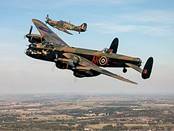
1824896 Sergeant Bernard Farndale (K2), 115th
Squadron RAF, was killed in action over Denmark on 30 August 1944. On the night
before 30 August 1944 nearly 600 RAF bombers flew over Denmark on bombing raids
to Königsberg and Stettin. Particularly the planes for Stettin were attacked by
German night fighters, when they were passing the northern part of Jutland and
the Kattegat. Avro Lancaster Bomber LAN ME718 was hit and flew for a moment
through the air before it crashed like a burning torch at Oue (about 400 m west
of Rinddalsvej in Denmark). All of the bomb load exploded on impact. All of the
crew were killed. The Germans did not want to collect the bodies and left them
in the field. The locals were appalled by this behaviour and collected the
remains in wickerwork baskets. The Wehrmacht ordered the Danes to hand the
baskets over, and these were thrown in the crater at the crash site and
covered. When the Germans had left the area, the locals together with members
of the Civil Air Defence opened the crater and placed the remains in a coffin
which was driven to Ove church. A memorial still stands to the dead airmen at
Oue.
Bernards younger brother, Albert Farndale (K2), was a Corporal in the Royal
Air Force during the Second World War. He was Founder of the Surrey 1 Line.
Education Act 1944 (The Butler Act) established
tripartite education system of grammar schools, secondary modern schools and
technical schools.
Swindonia Farndale, daughter of Harry Farndale, the Stockport 1 Line
married Garland White in Stockport.
In 1944, William Farndale, son
of Joseph Farndale, (K1), the Kilton 1 Line, a nurseryman, married Doris
Denyer in Sunderland, County Durham.
Wilfred Gordon Farndale,
son of Charles and Mabel (nee
Pugh) Farndale, grandson of John George and Elizabeth (nee Sanderson) Farndale,
veteran of the Crimean war, and great grandson son of John
Farndale, the author (K1),
the Ontario 1 Line was a Flight Lieutenant in the Royal Canadian Airforce
in Europe. He married Vivien May Gordon on 4 May 1944 and later became an
accountant.
Clarence Edward Farndale,
Wilfred’s brother, (K1),
the Ontario 1 Line,
served in the Royal Canadian Navy from 15 March 1939 to 17 August 1945 and then
from 256 February 1947 to 12 August 1966.
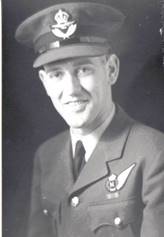
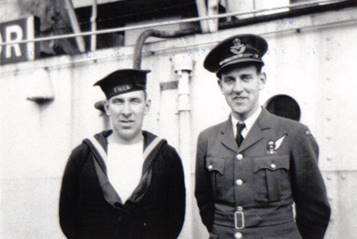
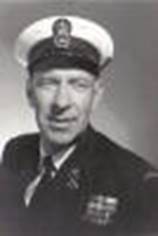
Gordon Farndale RCAF 1944 Clarence Farndale and Gordon Farndale
RCAF in 1944 on board Clarence Edward’s corvette Clarence Farndale, 1960
1945
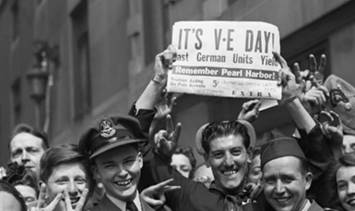
8 May 1945 - Victory in Europe Day
On 11 May 1945, three days
after VE day, Henry Stewart Farndale
(K1),
the Wakefield 1 Line died
as a pilot in training in a Tiger Moth over Leeds. He had married Maria
Pratchett in 1940, and they had twins born in 1940 but they both died at birth.
See also the Bradford 3 Line.
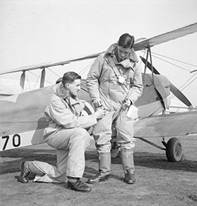
Instructor
and pupil in front of a de Havilland Tiger Moth at No. 7 EFTS, Desford. Both
wear 1930 Pattern flying suits
The National register of Archives was established to
collect manuscript information outside public records.
From 1945, the Australian government encouraged British
citizens to emigrate to Australia under an assisted passage scheme.
6 to 9 August 1945 - Atomic bombing of Nagasaki and
Hiroshima.
15 August 1945, Victory in Japan Day.
George Orwell’s Animal Farm published.
1946
The New Towns Act led to 27 new towns.
Family Census carried out for the Royal Commission on
Population.
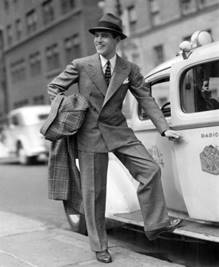
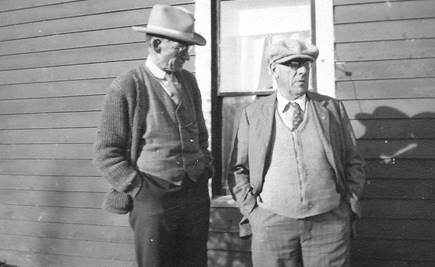
Martin Farndale and
Howard Holmes, husband of Grace Holmes, nee Farndale,
at the Holmes Ranch in Alberta in about 1946.
Martin Farndale
(my father), son of Alfred Farndale
(my grandfather), and Margaret Louisa (“Peggy”) nee Baker
Farndale (K1),
the Wensleydale Line
joined the Indian Army on 3 September 1946, transferred to the British Army in
1947 and went to the Royal Military Academy Sandhurst where he was commissioned
into the Royal Artillery. Served in Egypt, Germany, Malaya, South Arabia,
Ireland. He commanded The Chestnut Troop, 1st Regiment RHA, 7th Armoured
Brigade, 2nd Armoured Division, 1st British Corps and Northern Army Group. He
became Commander-in-Chief British Army of the Rhine and Master Gunner St
James’s Park. Awarded General Service Medal with clasps for Malaya, South
Arabia and Northern Ireland. Awarded Silver Jubilee Medal in 1977, Commander of
the Order of the Bath in 1980 and Knight Commander of the Order of the Bath in
1983. Awarded 125th Anniversary of Canada Medal for services to Canada. Hon
Degree Literature at Greenwich University.
In July 1946, Major William Arthur James Farndale,
son of Rev William Edward and Florence
Farndale (K1),
the William Line,
gave
a lecture to the Lincoln Rotarians on the risks of bilharzia in Egypt. He had
clearly served there in the War.
1947
The Royal Military Academy Sandhurst opens.
Education now compulsory up to age 15.
In April 1947, in a tragic incident, Derrick Farndale, the
thirteen year old son of Harry Farndale, the Stockport 1 Line
hanged himself after watching a horror film in Stockport.
As President of the Primitive
Methodist Conference in 1947 Rev Dr William
Edward Farndale,
son of William Farndale,
(K1),
the Whitby 5 Line, and
founder of the William Line,
sounded the Call of the Countryside and launched a “Back to the Soil” campaign.
He showed authoritative leadership in the Lincolnshire area, where his
administrative gifts were matched by pastoral care and a love for country
Methodism and the farming community.
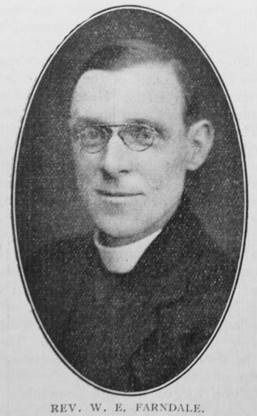
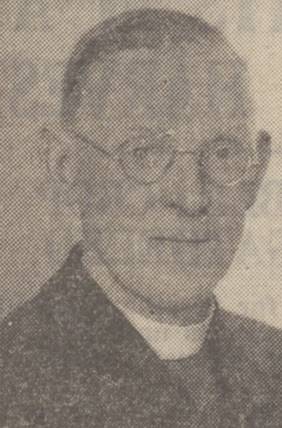
Rev Dr William Edward Farndale
wrote a number of publications including The Secret of Mow Cop. A new
appraisal of the origins of Primitive Methodism (Wesley Historical Society
Lectures. no. 16.); The Psalms in new light; Mow Cop after 150 years
: its spiritual significance.
On 15 March 1947, John Farndale, son of William Farndale, (K1), the John Farndale section of the Loftus 2 Line,
married Mary Gill. By then he was B Sc (ag). He seems to have been regional
livestock officer in Derbyshire by 1966 and involved with the church.
In November 1947, Major William Arthur James Farndale, son of Rev
William Edward and Florence Farndale
(K1),
the
William Line, was called to the bar by the Middle
Temple. He was later a Chairman of the Governors of Dovedale Manor School in
Camberwell. He regularly gave lectures and became involved later in residential
care.
1948
The National Health Service started.
Summer Olympics in London.
The Poor Law abolished.
In 1948, James Armin Farndale,
son of Henry and Elizabeth nee
Armin Farndale, the Hartlepool 1 Line,
married Elizabeth Gurney in Bradford.
Martin Farndale
(my father), son of Alfred Farndale
(my grandfather), and Margaret Louisa (“Peggy”) nee Baker
Farndale (K1),
the Wensleydale Line
went to the Royal Military Academy Sandhurst
where he joined Intake 1A of the newly formed Officer training school and was
in his company's boxing and motor-cycle team. He won the Brian Philpotts
Memorial Prize for Military History. He was Intake 1A, Dettingen Company and
passed out on 20 October 1948.
1949
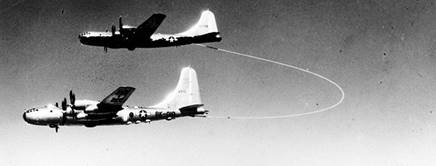
February 1949 - First round-the-world nonstop flight.
Capt. James Gallagher and USAF crew of 13 flew a Boeing B-50A Superfortress
around the world nonstop from Ft. Worth, returning to same point: 23,452 mi in
94 hr., 1 min., with four aerial refuelings en route

Formation of NATO
1950

Korean War (1950–1953)
John Alan Farndale,
the American 3 Line
(K2)
saw service during the Korean War in the Royal Air Force. Hazel Jane Rydell nee Farndale
(“Janie”)’s husband (K1),
the American 1 Line
John Elif Rydell also saw service in Korea.
In 1950 Leslie Farndale, son of
Thomas William and Christie Ann (nee Dixon) Farndale
of Egton, who had been the ‘lights on man’ for Loftus urban district council (K1), the Whitby 5 Line was a Regular Army Sergeant
in the Sherwood Foresters. He married Ellen Sanders in 1943 and Irene Marriot
in 1950 and they are founders of the Nottingham 1 Line.
In 1950 Mary Ellen Farndale (later
Mentzer) daughter of James (“Jim”) and Edna nee Adams
Farndale, the Nevada Senator (K1),
the American 1 Line
was a laboratory worker in a chemical laboratory in Los Angeles.
1951
Population of UK reached 50.2 million
8 April 1951 – the first full census since World War 2.
The first volume of Nikolaus Pevsner’s The Buildings
of England published with detailed surveys of all significant historical
buildings
Wilfred (or “Wilf”) Farndale,
son of Tom Farndale (A1), the Stockton 3 Line,
still lived at Filton, near Bristol, with his wife Doris Eveyln nee
Howard. He was
involved with the Brabazon, Britannia and early stage of Concorde designs. He
was a football referee. He was Founder of the New Zealand 2 Line.

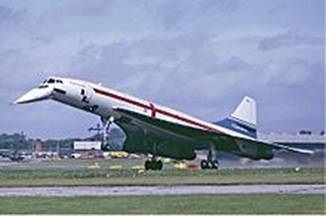
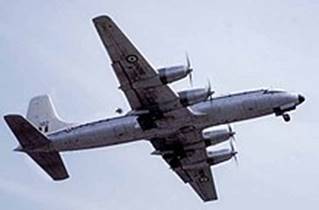
Bristol Brabazon
Concorde, originated from
the Bristol 223 project study
The Bristol Britannia
The Bristol Type 167 Brabazon was a large British
piston-engined propeller-driven airliner designed by the Bristol Aeroplane
Company to fly transatlantic routes between the UK and the United States. The
type was named Brabazon after the Brabazon Committee and its chairman, Lord
Brabazon of Tara, who had developed the specification to which the airliner was
designed.

The Bristol
Aeroplane Company, originally the British and Colonial Aeroplane Company, was
both one of the first and one of the most important British aviation companies,
designing and manufacturing both airframes and aircraft engines. Notable
aircraft produced by the company include the 'Boxkite', the Bristol Fighter,
the Bulldog, the Blenheim, the Beaufighter, and the Britannia, and much of the
preliminary work which led to Concorde was carried out by the company. In 1956
its major operations were split into Bristol Aircraft and Bristol Aero Engines.
In 1959, Bristol Aircraft merged with several major British aircraft companies
to form the British Aircraft Corporation (“BAC”) and Bristol Aero
Engines merged with Armstrong Siddeley to form Bristol Siddeley.
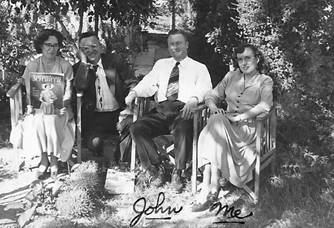
John Rydell and Hazel Jane Rydell nee
Farndale (“Janie”), daughter of James (“Jim”) and Edna nee Adams
Farndale, the Nevada Senator (K1),
the American 1 Line
1952
Elizabeth
II, 1952 to 2022
The
Second Elizabethan Age
The great smog of London.
In March 1952 Florence Farndale, wife of Rev Dr William Edward Farndale,
(K1),
the Whitby 5 Line
recovered from an accident in which her nightgown caught fire.
In 1952, Jimmy Farndale, son of James (“Jim”) and Edna nee Adams
Farndale, the Nevada Senator (K1),
the American 1 Line
flew around the world.

1953
29 May 1953 - Hilary and Tenzing reach the suit of
Everest.
2 June 1953 - Elizabeth II’s Coronation
Francis Crick and James Watson discover
the double-helix structure of DNA.
In January 1953, James Farndale, son of John Willie Farndale, (K1), the South Shields 2 Line
became a labour councillor in Hammersmith. He was married to Emily Podmore and
founded the London 2 Line.
1954
By 1954, Rosamund Farndale,
daughter of Albert Edward Farndale,
(K1),
the John Farndale section of the Loftus 2 Line, was a librarian in
Hampstead, inspiring children. In 1973, she married Singleton Jones Kwalker
Pomeyie. She later became a headmistress. An inspiring children’s librarian
who went onto enjoy a 20-year career as headteacher of a Kentish Town primary
school has died at the age of 81. Rosamund Pomeyie worked at Heath Library, now
called Keats Community Library in Belsize Park, for six years in the 1950s –
inspiring a multitude of children into the world of books, including a young
Julia Donaldson, author of The Gruffalo and many other children’s books. Having
re-trained as an infant school teacher in the 1960s, Ms Pomeyie became
headteacher of Torriano Junior School, in Kentish Town, in 1975. She was also
celebrated for her 30 years of volunteer work at Camden Victim Support, dealing
with victims of all manner of crimes, from fraud to murder. Ms Pomeyie’s
younger son Selom, a teacher at William Ellis School in Kentish Town, said: “My
mother was a people person. Wherever she went she seemed to engage in
conversation with almost anyone. Growing up in Yorkshire during the war had
given my mother an inner resilience and an ability to keep calm and carry on.
She was able to listen to others when times were hard, and say exactly the
right thing to make them see there was light at the end of the tunnel.” Born
just a stone’s throw from the Yorkshire Moors in the town of Northallerton in
1931, Ms Pomeyie was an only child who qualified as a librarian in 1951 and
soon after moved to London, where she took up the role of children’s librarian
at Heath Library in 1953. In 1959, she moved to Nigeria with her first husband
Bradford Martin, a professor of Arabic manuscripts, where she lived and worked
teaching English for three years. On her return from Africa, she re-trained as
an infant school teacher and later married second husband Jones Pomeyie, after
earlier splitting with Mr Martin. In 1975, she became headteacher of Torriano
Junior School, two years after the birth of her first child Jonathan, which was
followed by the arrival of Selom in 1976. After a burglary at the family home
in 1980 and a visit from Camden Victim Support, Ms Pomeyie started volunteering
for the organisation – a role which she continued for 30 years. Regarded as one
of Torriano’s most revered headteachers, a governor at the school was once
quoted in a newspaper article as saying: “If we could put Mrs Pomeyie in a cast
of iron and keep her forever, we would.”
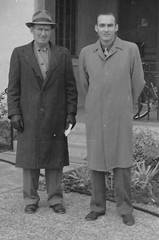
James (“Jim”) and Edna nee Adams
Farndale, the Nevada Senator and his son Jimmy Farndale, (K1), the American 1 Line
just before leaving for the UK in April 1954
1955
The Vietnam War began.
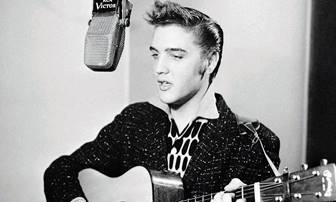
On 3 September 1955, Doris Farndale,
daughter of James (“Jim”) and Edna nee Adams
Farndale, the Nevada Senator (K1),
the American 1 Line
was tragically killed in a road accident at San Bernadino.
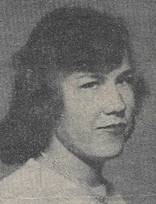
1957
John Alan Farndale (K2) emigrated to USA on the Queen Elizabeth, at
25. John saw service during the Korean War in the Royal Air Force. He became a
general sales manager in California. He is Founder of the American 3 Line.
1958
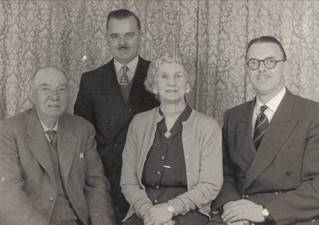
John Martin Farndale,
son of John and Elizabeth Farndale,
(K1),
the John Farndale section of the Loftus 2 Line, with his wife Bessie
Farndale (nee Stainthorpe) and sons Raymond Farndale (back)
and Bertram Farndale
(right) taken in 1958
1959
On 4 July 1959 Stuart Alan Farndale,
son of Tom Farndale (A1), the Uxbridge Line, was a pantryman working on the
Oronsay, a British vessel bound for Honolulu.
On 25 July 1959, Keith Farndale, son of James and Mary Farndale,
(A1), the Ampleforth 1 Line
married Doreen
Delmer. Keith and Doreen Farndale were Founders of the Thornaby Line.
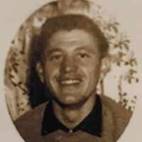
Ronald Martin Farndale,
son of Robert and Sarah Jane nee
Alcock Farndale, (K1),
the Wakefield 1 Line
had emigrated to New Zealand and served in 6th Field Ambulance,
Royal Army Medical Corps in Greece and Crete, before he was captured at the
Battle of Sidi Rezegh in 1941. He later became a builder amnd carpenter in
Masterton, near Auckland, New Zealand. He married Margaret Maxted in 1945, but
she died in 1956. He later married Doris Wilkin in 1959. He founded the New Zealand 1
Line.
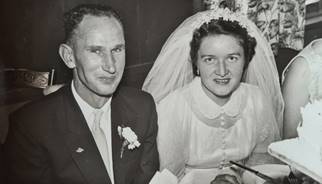
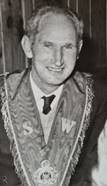
1960
British Prime Minister Harold
Macmillan delivered his Wind of Change speech in 1960.
Frederick J Farndale, son of James and Mary Farndale, (A1), the Ampleforth 1 Line emigrated to New Zealand.
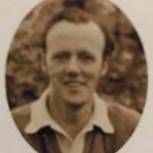
From 1960 to 1962, Major Martin Farndale (my
father), son of Alfred Farndale (my
grandfather), and Margaret Louisa (“Peggy”) nee
Baker Farndale (K1),
the Wensleydale Line
served in Malaya. Artin and Ann nee Buckingham (my mother) drove home from Malaya to UK in
1962.
1961
First man in space
The Berlin Wall was built.
The data from the 1961 census was entered onto a
computer for the first time.
Brian Picton Farndale (K2) married Elizabeth Evans in Pontypridd in 1961. He is
Founder of the Wales 1 Line.
Lilian M Farndale,
daughter of James and Mary Farndale,
(A1), the Ampleforth 1 Line married Patrick Weatherall on 17
December 1961 in Middlesbrough.
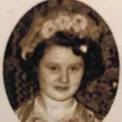
On 25 March 1961 Harold Farndale, son of
James and Mary Farndale,
(A1), the Ampleforth 1 Line married Sandra Hampton. They lived at Stockton.
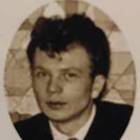
1962
The Cuban Missile Crisis (16–28 October 1962)
In 1962, Francis William Farndale,
son of Charles (“Charley”) Farndale,
son of William Farndale, (K1), the Richmond Line, married Mary Silburn in
Norfolk. They founded the Wales 2 Line.
1963
Kennedy was assassinated and replaced by Vice
President Lyndon Johnson.
1964
In 1964, Wilfred (or “Wilf”) Farndale,
son of Tom Farndale (A1), the Stockton 3 Line,
moved to New Zealand (see the New Zealand 2 Line) with his wife Doris Eveyln
nee Howard to follow their eldest son, Howard Farndale. Wilf
built bridges in the Gisborne area. He was very involved with the Eastern Union
Association Football team.
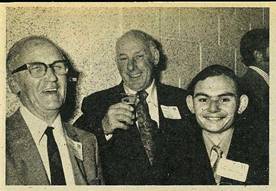
Wilf (left), with his son Nigel (right) in 1974
Clifford Farndale, son
of James and Mary Farndale,
(A1), the Ampleforth 1 Line married Kathleen Gourlay in 1949
and they emigrated to Port Adelaide Australia in about 1964. Clifford and
Kathleen are founders of the Australia 2 Line.

1965
In 1965, Major Martin Farndale (my
father), son of Alfred Farndale (my
grandfather), and Margaret Louisa (“Peggy”) nee
Baker Farndale (K1),
the Wensleydale Line
served with First Regiment Royal Horse
Artillery in Aden.
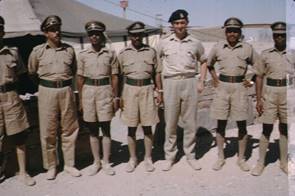
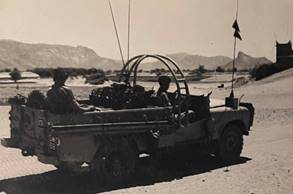
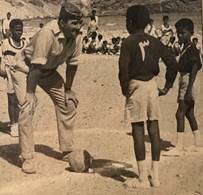
1966
A mini census was held based on 10% of the population.
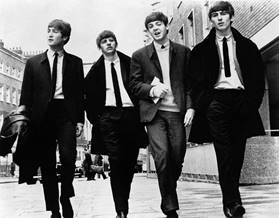
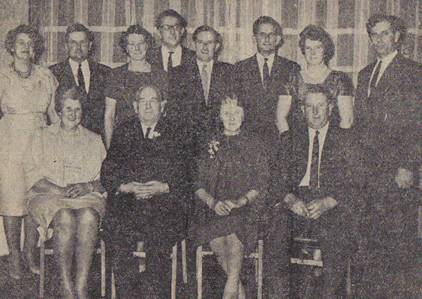
The Golden wedding anniversary of William and Mary Farndale
in 1966.
1967
The Public Record Act 1967 reduced the length of time
records were closed to 30 years, except for census data to remain closed for
100 years.
In 1967, Brian William Farndale,
son of William Claude Farndale
(A1),
the Norwich Line,
born in 1933, by then a pattern cutter, sailed with his wife Margaret nee
Walpole to New Zealand where they lived in New Plymouth and Fendalton.
In 1967, George Derrick Farndale,
son of Charles (“Charley”) Farndale,
son of William Farndale, (K1), the Richmond Line, married Patricia McGregor.
On 9 December 1967 Maxwell (“Max”) Farndale,
son of Ronald Martin and Margaret Madge nee
Maxted Farndale, (K1),
the New Zealand 1
Line married Gail Ann Cadwallada at Carterton, New Zealand.
Max was a sports shop owner and Secretary of the New Zealand Indoor Cricket
Federation. Max Farndale was founder of MSC Newswire, the National Press Club’s
associate site, which reached 1.2 million monthly visits. Max configured the
site around an international audience, reasoning that New Zealand media had
become over-localised. Burly and affable and well known in Auckland athletic
circles, notably in cycling and running, Max had worked in production
engineering and travel before arriving in the publishing sector. MSC Newswire
became renowned for its predictions including the ascendancy of Donald Trump,
and the fall of the National Party in the New Zealand general election.
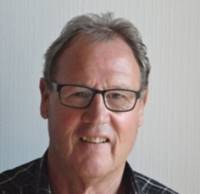

1968
The assassination of Martin Luther King junior.
Denise Mary Farndale,
daughter of William Farndale (A1), the Ampleforth 1 Line,
became a citizen of USA and was a resident of Longboat Key, Florida.
1969

The Apollo 11 mission landed the first humans on the Moon in
July 1969.
The Representation of the People Act 1969 extended the
vote to women and men over 18 years old.
The Divorce Reform Act 1969 made divorce easier from
1971.
British Troops deployed to Northern Ireland.
From 1969 to 1971, Lieutenant Colonel Martin Farndale (my
father), son of Alfred Farndale (my
grandfather), and Margaret Louisa (“Peggy”) nee
Baker Farndale (K1),
the Wensleydale Line
commanded First Regiment Royal Horse Artillery
in Northern Ireland and the British Army on the Rhine.
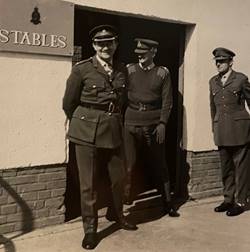
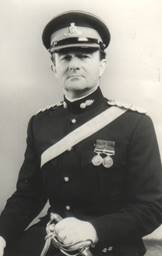
1970
The age of majority reduced from 21 to 18 years old.
William Hill Farndale,
son of William James Farndale
(K2)
of the Stockton 2 Line,
a gas and chemical engineer, had founded a coal effect gas fire company called
Kohlangaz.
Allan Farndale (A1), the New Zealand 2 Line was a Petty Officer on HMNZS
Endeavour
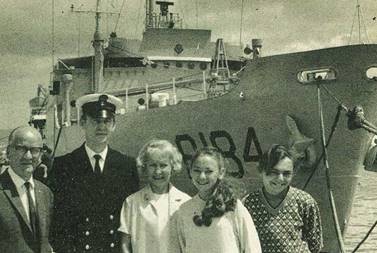
Wilf Farndale, Allan Farndale, Doris
Farndale, Melanie Farndale and Nigel Farndale, 2
December 1970
Melanie Farndale, (A1), the New Zealand 2 Line was a nurse in Gisborne.
1971
Population of UK was 55.9 million.
Decimalisation of the currency.
1972
Bloody Sunday
1973
Britain and Ireland joined the European Economic Union
(“EEC”).
1973 Oil Crisis

The pocket calculator
Howard Farndale (A1), the New Zealand 2 Line was a Production Manager in
the 70s in Auckland, New Zealand.
From 1973 top 1975 Brigadier Martin Farndale (my
father), son of Alfred Farndale (my
grandfather), and Margaret Louisa (“Peggy”) nee
Baker Farndale (K1),
the Wensleydale Line
commanded 7th Armoured Brigade (the Desert
Rats).
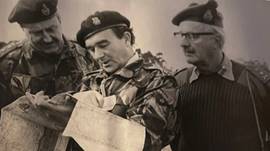
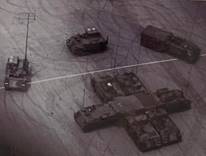
1976
Deaths exceeded live births in England and Wales for
the first time since records began.
1977
Opening of The National Archives (“TNA”) at Kew.
On 21 May 1977, Gordon Elliott Farndale,
son of James (“Jim”) and Edna nee Adams
Farndale, the Nevada Senator (K1),
the American 1 Line
married Alberta Allen. The family lived at Garden Grove, California.
1978
On 16 March 1978, Alfred Farndale (my
grandfather), twelfth child of Martin and Catherine Jane (nee
Lindsay) Farndale and Catherine nee Lindsay (K1), the Tidkinhow Line, and Peggy
Farndale (nee Baker)(my grandmother) had their Golden Wedding at Gale Bank Farm, Wensley.
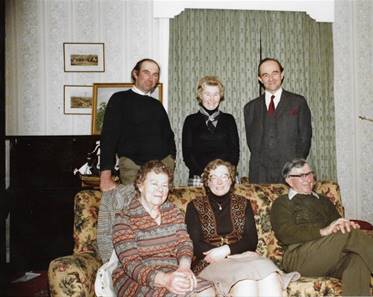
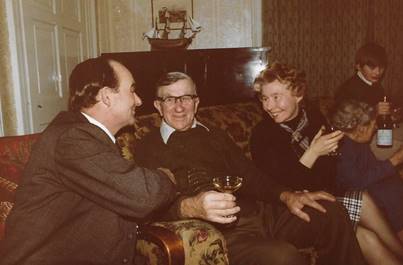
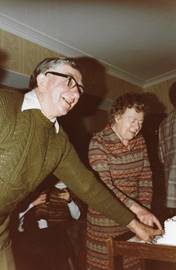
(Back row: Geoffrey Farndale, Anne Shepherd nee Farndale,
Martin Farndale; front
row: Peggy Farndale nee
Baker, Margot Atkinson nee
Farndale and Alfred Farndale)
1979
Margaret Thatcher and the Conservative party rose
to power in the United Kingdom in 1979, initiating a policy of reducing
government spending, weakening the power of trade unions, and promoting
economic and trade liberalization.
SAS storm the Iranian Embassy
Lord Mountbatten murdered by the IRA.
John Nicholas Farndale,
son of Charles and Lilian Farndale
(A1),
the Ampleforth 1
Line, starred as Grinner in Mad Max.

James Henry Farndale (K1) the Hartlepool 1 Line,
served in the King’s Own Scottish Borderers.
In 1979, as Director of Military Operations (Army),
Major General Martin Farndale (my
father), son of Alfred Farndale (my
grandfather), and Margaret Louisa (“Peggy”) nee
Baker Farndale (K1),
the Wensleydale Line
during
the final phases of the guerrilla campaign in Rhodesia after Ian Smith's
unilateral declaration of independence, was largely responsible for setting up
the British Monitoring Force which helped to end the guerrilla war and bring
about an independent Zimbabwe. He was also responsible for considering the
increased military requirements for dealing with a spiralling illegal immigrant
problem in Hong Kong.
1979–1989
Soviet–Afghan War – a war fought between
the Soviet Union and the Islamist Mujahideen Resistance in
Afghanistan.
1980
Between 1980 and 1988, Major General Martin Farndale (my
father), son of Alfred Farndale (my
grandfather), and Margaret Louisa (“Peggy”) nee
Baker Farndale (K1),
the Wensleydale Line
was
Colonel Commandant of the Army Air Corps.
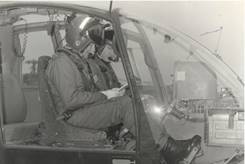
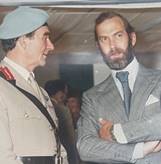
Major General Martin Farndale was
Commander oof 2nd Armoured Division between 1980 to 1983.
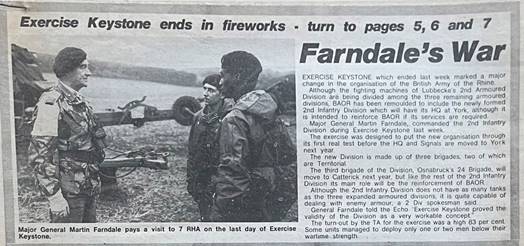
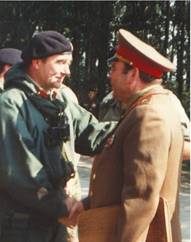
1981
UK population 56.3 million

The Space Shuttle Columbia seconds after
engine ignition, 1981
1982
The Falklands War.
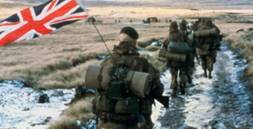

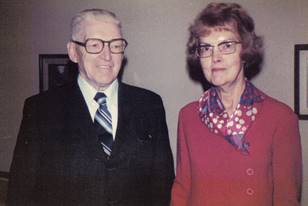
Gordon Farndale with Audrey Celina McKelvie
(nee Farndale), son and daughter of Mark and Mary (nee Wiltz) Farndale,
grand-children of John George and Elizabeth (nee Sanderson) Farndale,
veteran of the Crimean war, and great grand children of John
Farndale, the author (K1),
the Ontario 1 Line in
about 1982.
1983
Between 1983 and 1985, Lieutenant General Martin Farndale CB (my
father), son of Alfred Farndale (my
grandfather), and Margaret Louisa (“Peggy”) nee
Baker Farndale (K1),
the Wensleydale Line
was
Commander 1 (British) Corps. This was the fighting component of the British
Forces in Germany, still during the height of the Cold War. The Headquarters
was at Bielefeld and he lived at Spearhead House. In those days, tests and
demonstrations of ability to withstand an invasion from the east were critical
to keeping the peace and winning the Cold War. In 1984, he devised and oversaw
the vast Exercise Lionheart, a show of strength of the height of the Cold War,
which involved 131,000 British troops, including tens of thousands or
Territorials and Army Reservists and which extended over 3,700 square miles.
During a second phase a further 6,300 German, 3,500 Dutch, 3,400 American and
165 Commonwealth (from Australia, New Zealand and Canada) took part. It was
intended to test BAOR's reinforcement plans and was the biggest military
exercise to be held since the Second World War. In September 1983, he showed
the Prime Minister, Mrs Thatcher, around his Corps during an exercise, during
which now infamous photographs were taken of the later Lady Thatcher riding in
a Chieftain tank.
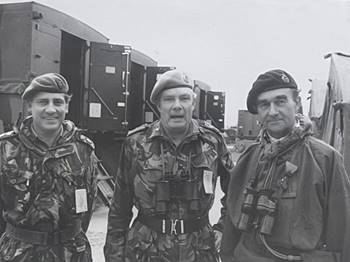
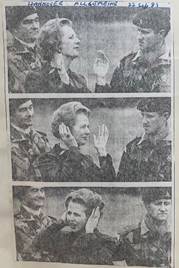
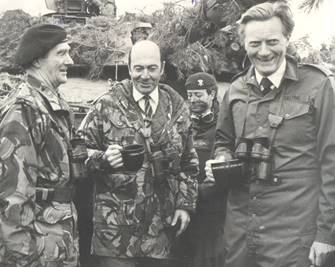
1984
GRO and BMD registers now arranged annually not
quarterly.
1985
The Bradford City Stadium Fire
Toxteth, Liverpool and Broadwater Farm, Tottenham Riots

Between 1985 and 1987, General Sir Martin Farndale KCB (my
father), son of Alfred Farndale (my
grandfather), and Margaret Louisa (“Peggy”) nee
Baker Farndale (K1),
the Wensleydale Line
was
Commander British Army on the Rhine and the Northern Army Group of NATO, the
northern half of Europe’s defence in the Cold War, consisting of a British,
Dutch, German, and American Corps, from its headquarters at Rheindalen.
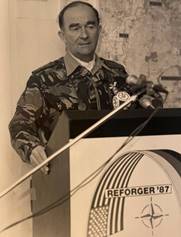
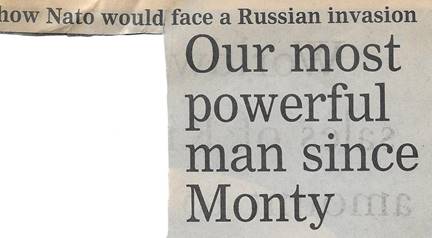
1986
Martha Teresa Farndale,
daughter John George and Elizabeth (nee Sanderson) Farndale,
veteran of the Crimean war, and grand daughter of John
Farndale, the author of Kilton (K1), the Ontario 1 Line, a spinster who had lived in
Toronto, died aged 99, and was buried near her parents at Brampton Cemetery,
Peel, Ontario.
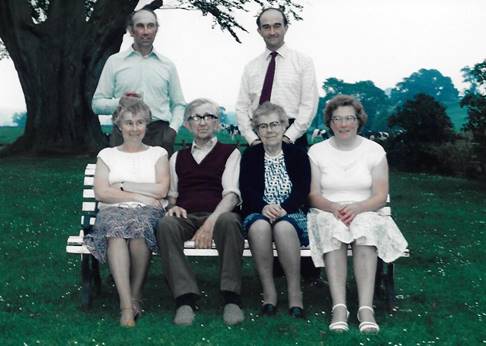
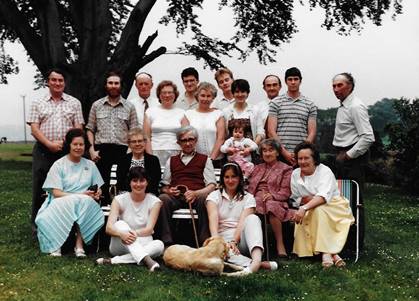
Alfred and Peggy Farndale’s family at Gale Bank in 1986
(Back row: Geoffrey Farndale, Martin Farndale; front
row: Anne Shepherd nee Farndale,
Alfred Farndale, Peggy Farndale nee
Baker, Margot Atkinson nee
Farndale) … and
with their grandchildren
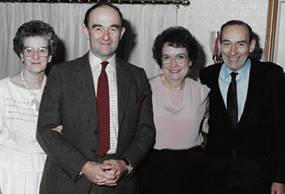
Jean, wife of Jimmy Farndale. Martin Farndale, Hazel Jane Farndale (“Janie”)
and Jimmy Farndale at Foot
Hood, Texas in August 1986
1987
Legal restrictions between Children born to married and
unmarried parents removed (The Family Law Reform Act 1987).
U.S. President Reagan and Soviet General Secretary
Gorbachev signing the INF Treaty, 1987
Gary Farndale, son of Keith and Doreen Farndale,
(A1), the Thornaby Line served with the British Army on the Rhine.
1989
The Fall of the Berlin Wall. Anti communist revolutions
across Europe.
The Tiananmen Square protests of 1989
The development of the World Wide Web (Tim
Berners-Lee).
Between 1988 and 1996, General Sir Martin Farndale KCB (my father), son of Alfred Farndale (my grandfather), and Margaret Louisa (“Peggy”) nee Baker
Farndale (K1),
the Wensleydale Line
was Master
Gunner of St James’ Park, the honorary head of the Royal Regiment of Artillery.
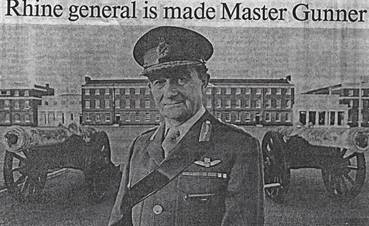
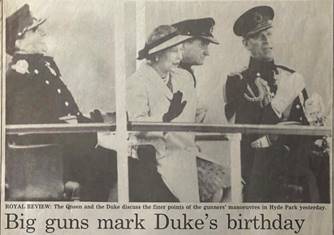
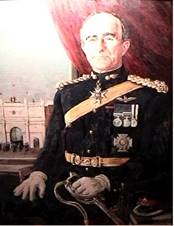
1990
Germany reunified on 3 October 1990 as a result of the
fall of the Berlin Wall and after integrating the economic structure
and provincial governments, focused on modernization of the former communist
East. People who were brought up in a socialist culture became integrated with
those living in capitalist western Germany.

First Gulf War 1990
Richard Farndale, son
of Martin Farndale and Anne nee Buckingham Farndale
(K1),
the Wensleydale Line
was
an artillery Forward Observation Officer during the First Gulf War.
1991
21 April 1991. The Census. About 1 million went
uncounted due to Poll Tax related refusals to participate.
Alan Farndale, son of Robert Edwin and Florence nee
Hooper Farndale (K1),
the Wakefield 1 Line,
an engineer and architectural designer, was founder of the Cambridge Line.
1992 - 1995
Bosnian War
1994
The end of Apartheid in
South Africa following the release of African National
Congress leader Nelson Mandela from jail in February 1990 after
thirty years of imprisonment for opposing apartheid and
white-minority rule in South Africa.
1995
Any suitable privately owed premises could be licensed
for marriage ceremonies which led to increasing number of marriages away from
places of birth/family home.
1997
The Scottish Parliament established following
a referendum in September 1997, the 1997 Scottish devolution
referendum was put to the Scottish electorate and secured a majority in
favour of the establishment of a new devolved Scottish Parliament, with
tax-varying powers, in Edinburgh.
Death of Princess Diana.
2000
The Millennium
2001
UK Population 59 million
29 April 2001 – the National Census – about 94% of the
population completed the survey

11 September 2001 attacks in New York City; Washington, D.C.; and Shanksville, Pennsylvania
2002
The
Golden Jubilee of Queen Elizabeth II
2003
Start of the Second Gulf War
2004
Mars Exploration Rover
2005
7 July 2005 – Terrorist attacks in London
2007/8
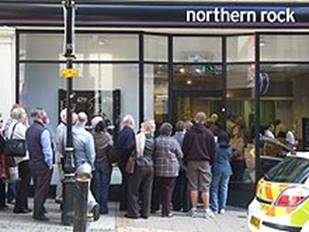
Economic crisis
2009
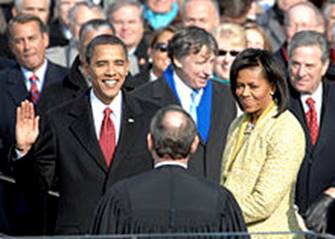
Barack Obama, the first African American president of
the United States, was inaugurated in
2009
2012
Summer Olympics held in London
Diamond
Jubilee of Queen Elizabeth II
2015
Population of London reaches 8.6M (uf you scroll to the
start of this timeline, that is nearly double the national population in 1600!)
2016
The United Kingdom voted to leave the European Union
(“Brexit”)
2018
The Human Genome Project completed in Cambridge
2017
The beginning of the Trump Administration in USA
2020
31 January 2020, The UK formally withdraws from the
European Union.
The start of the Covid 19 Pandemic in UK
2021
The Biden Administration in USA
2022
24 February 2022, Russia invaded Ukraine.
Charles
III, 8 September 2022 to date
The
Future?
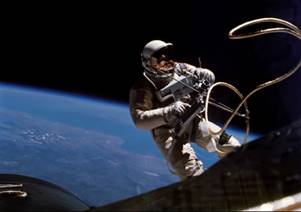

A giant leap?
“New Tidkinhow”?








